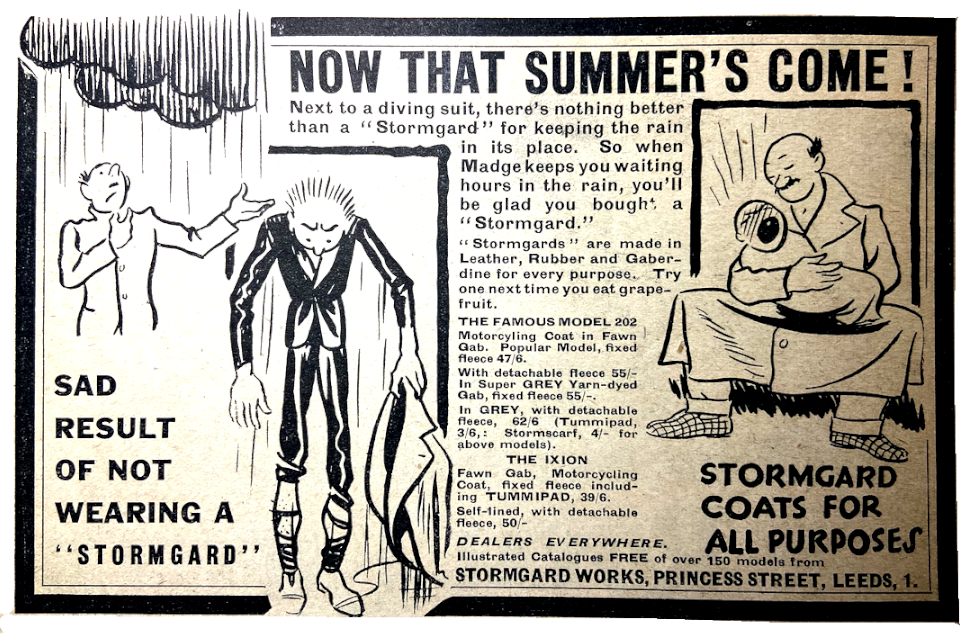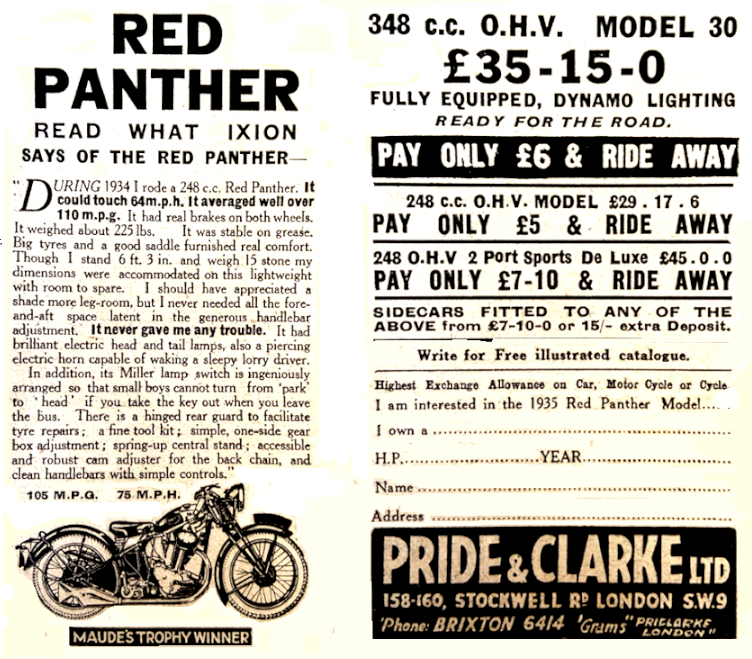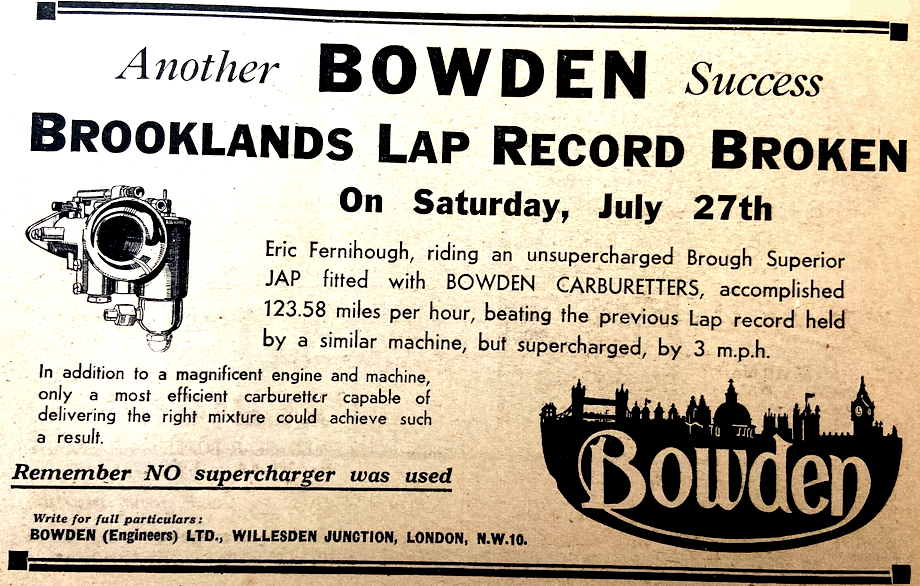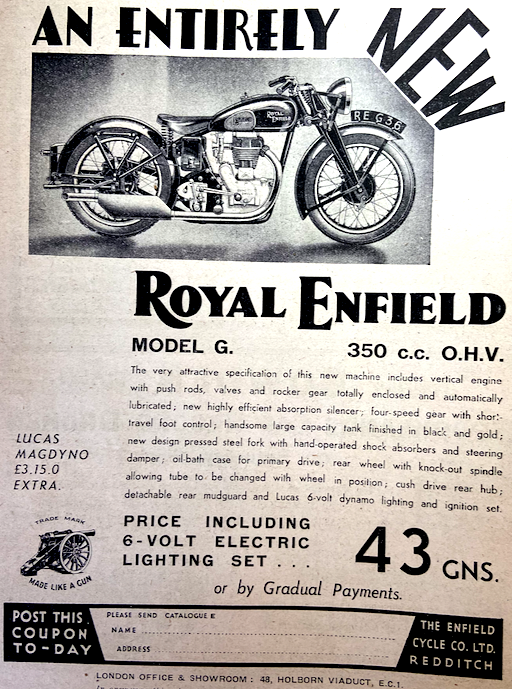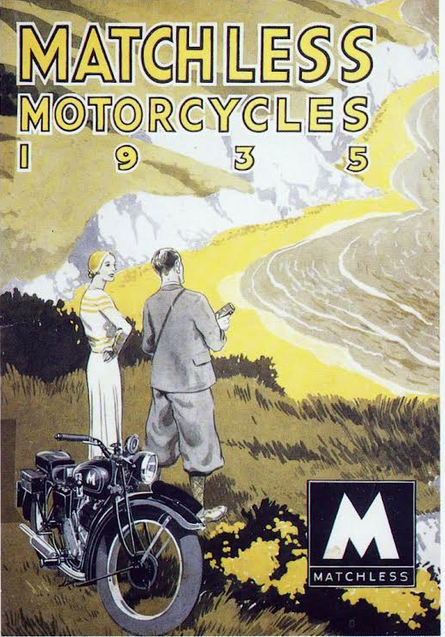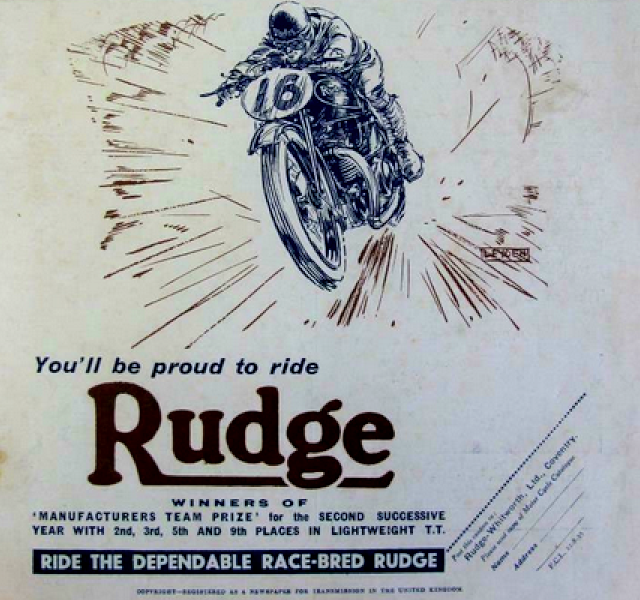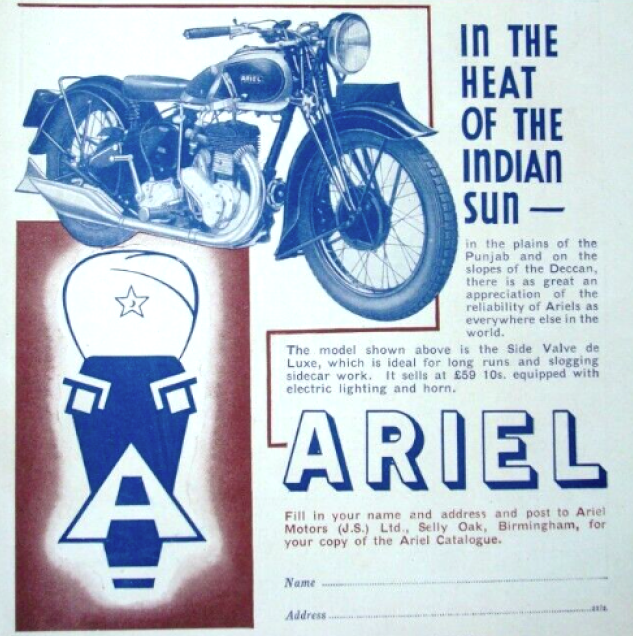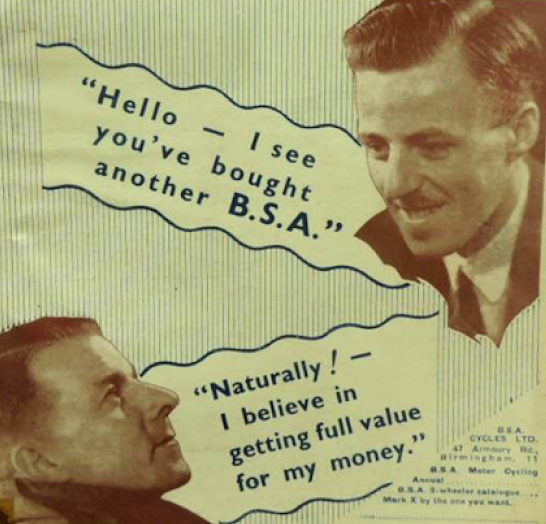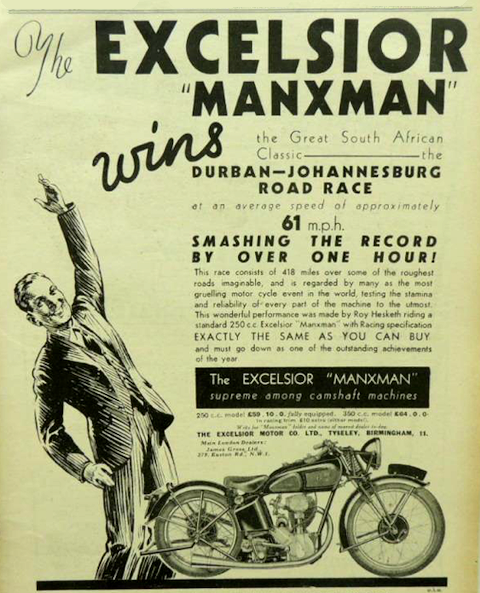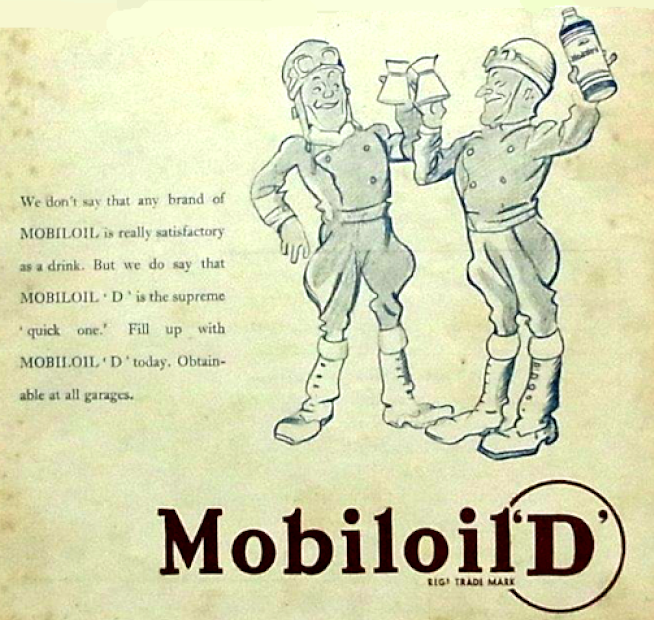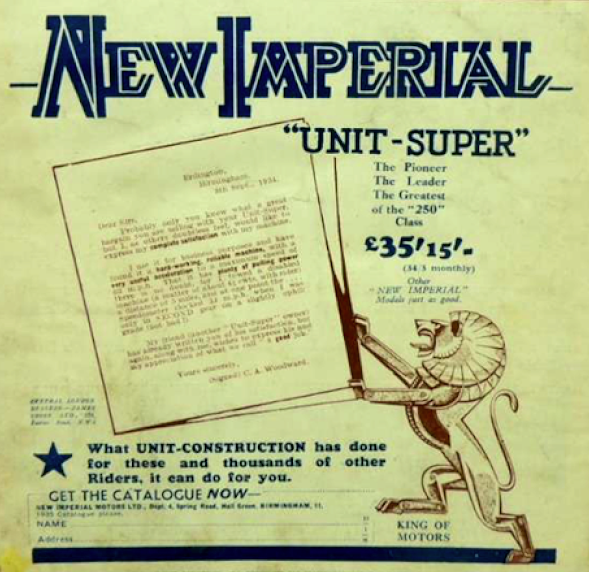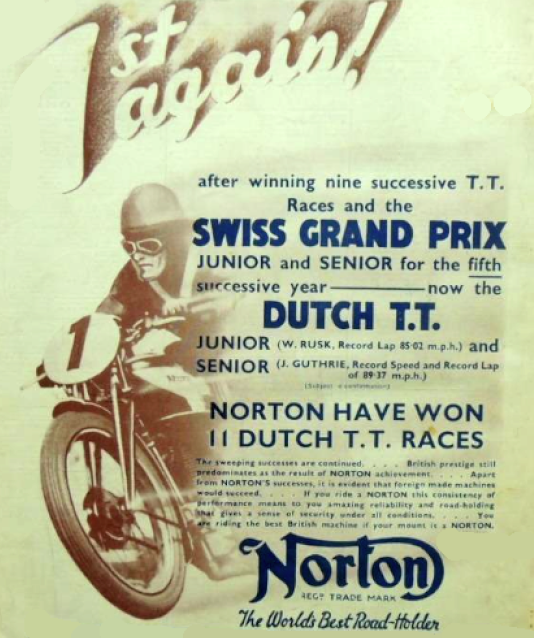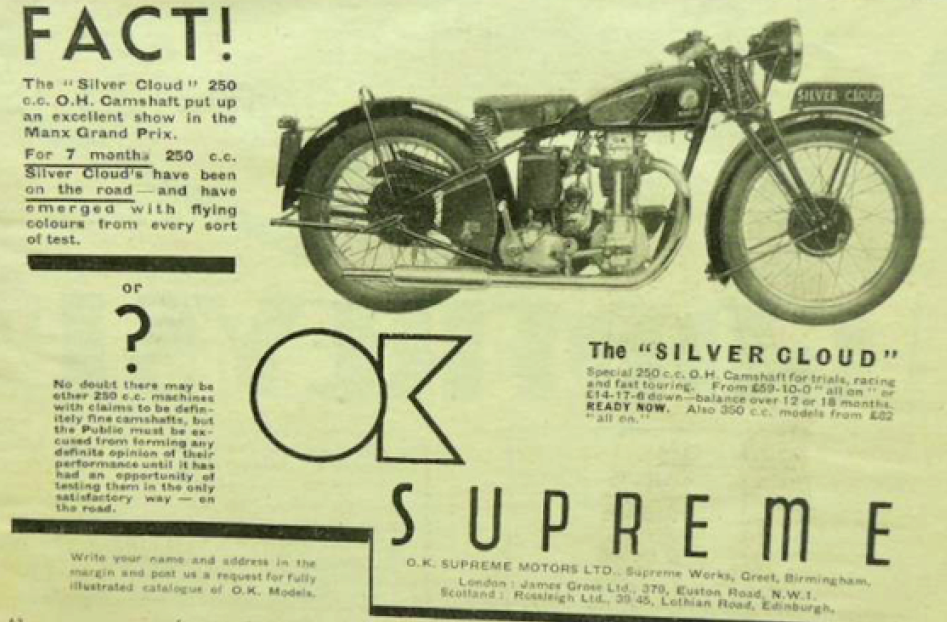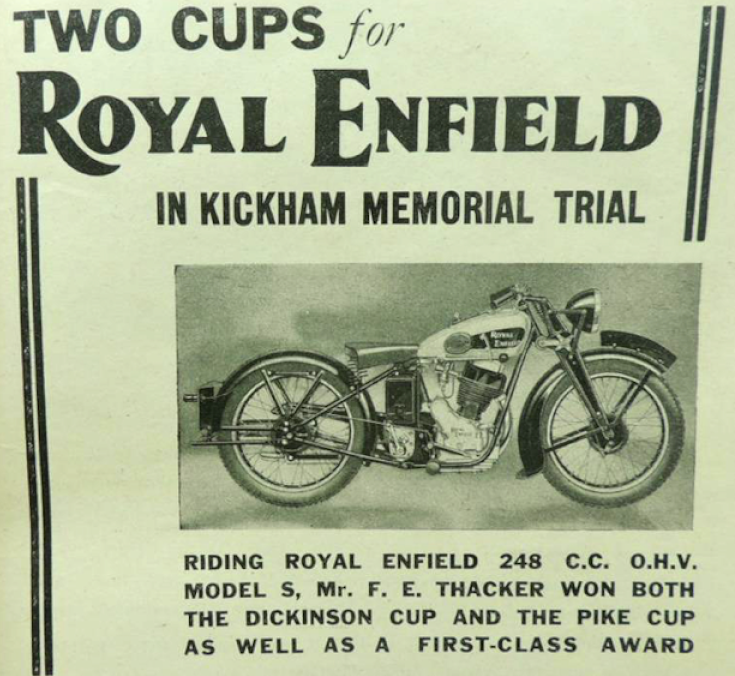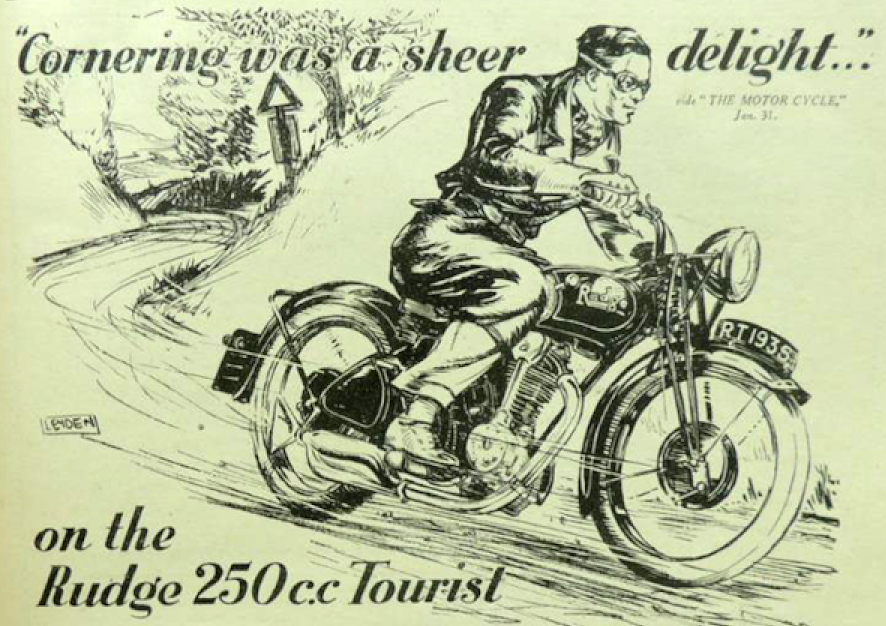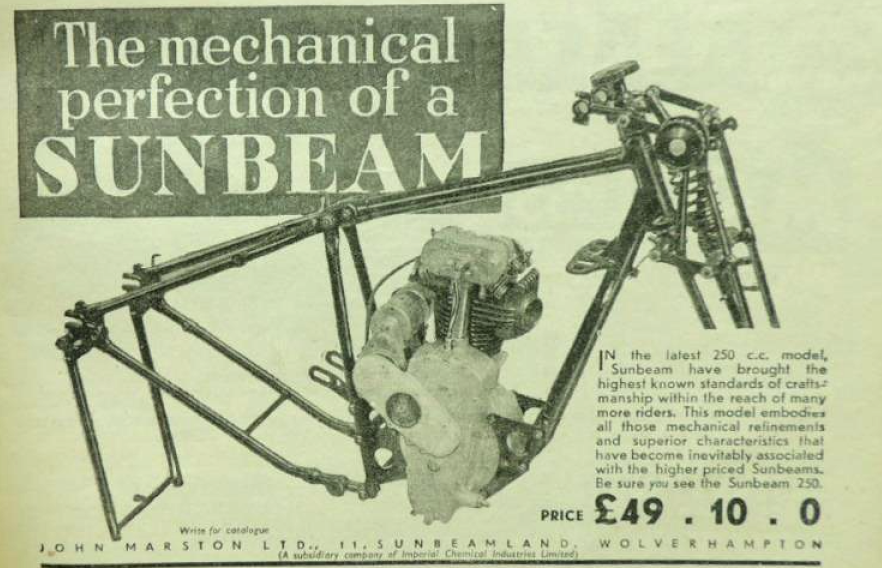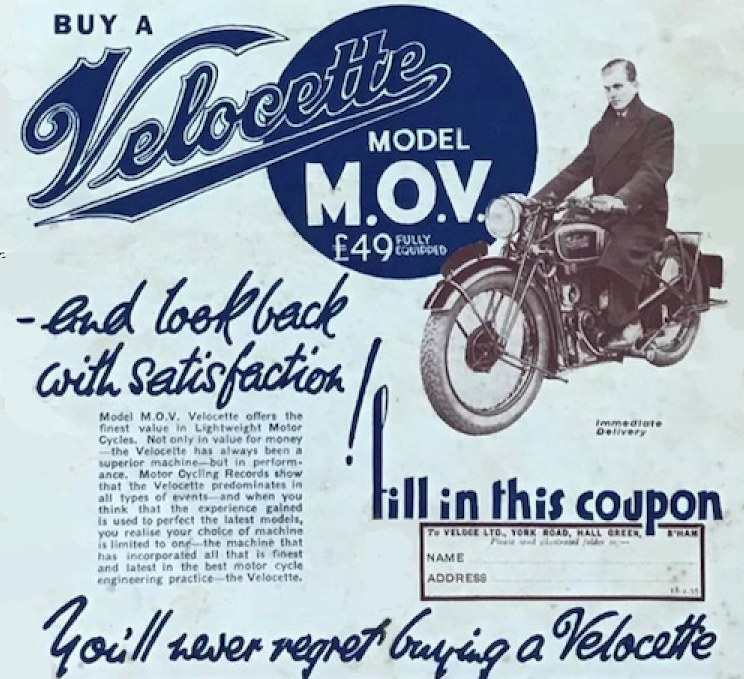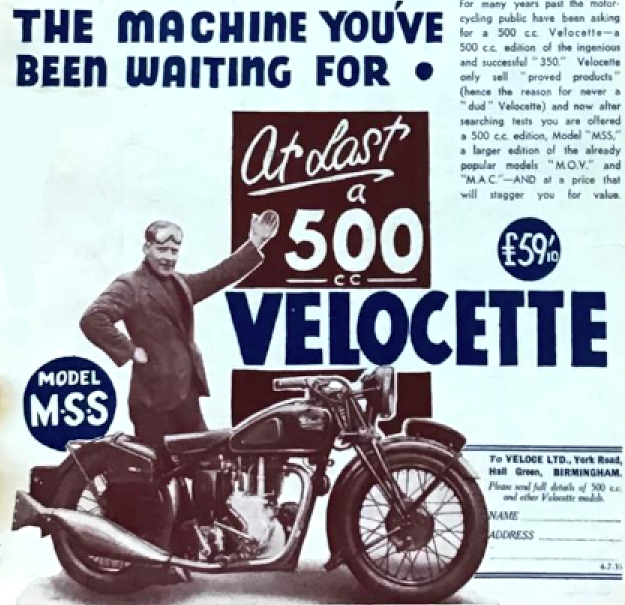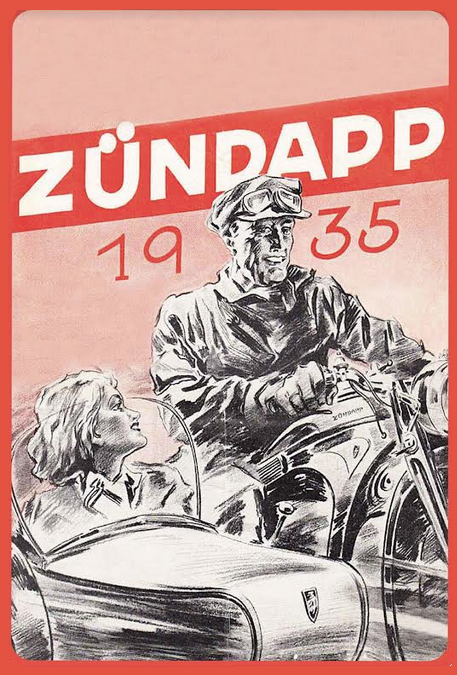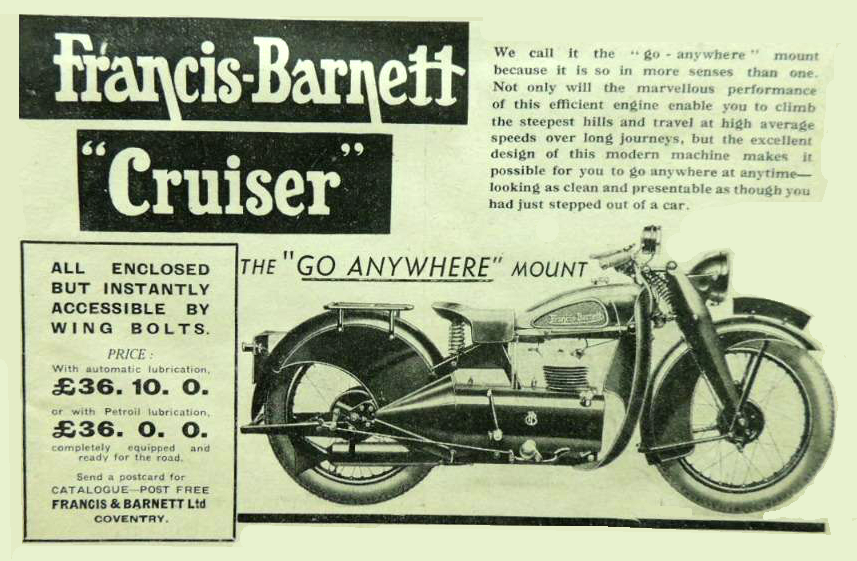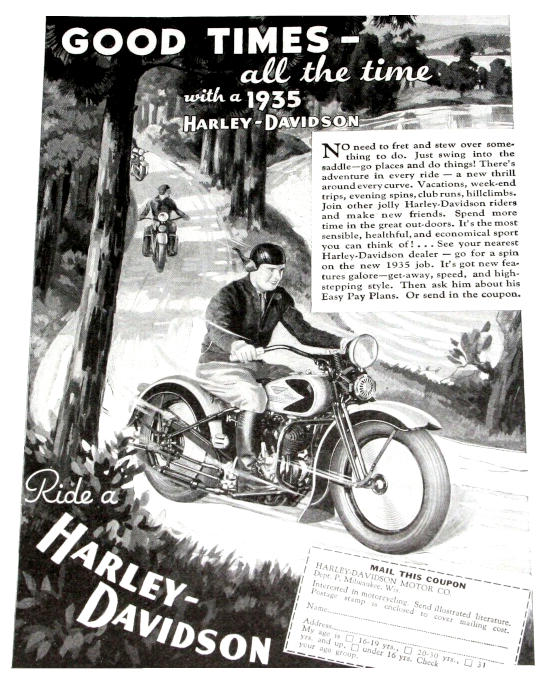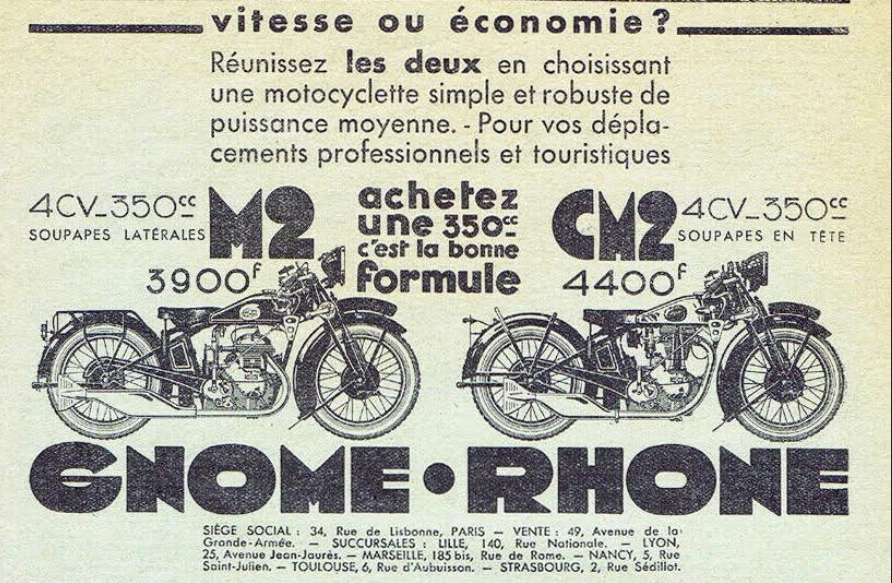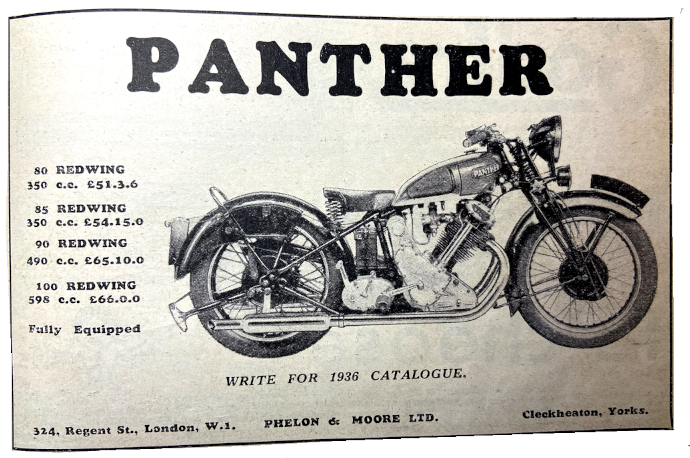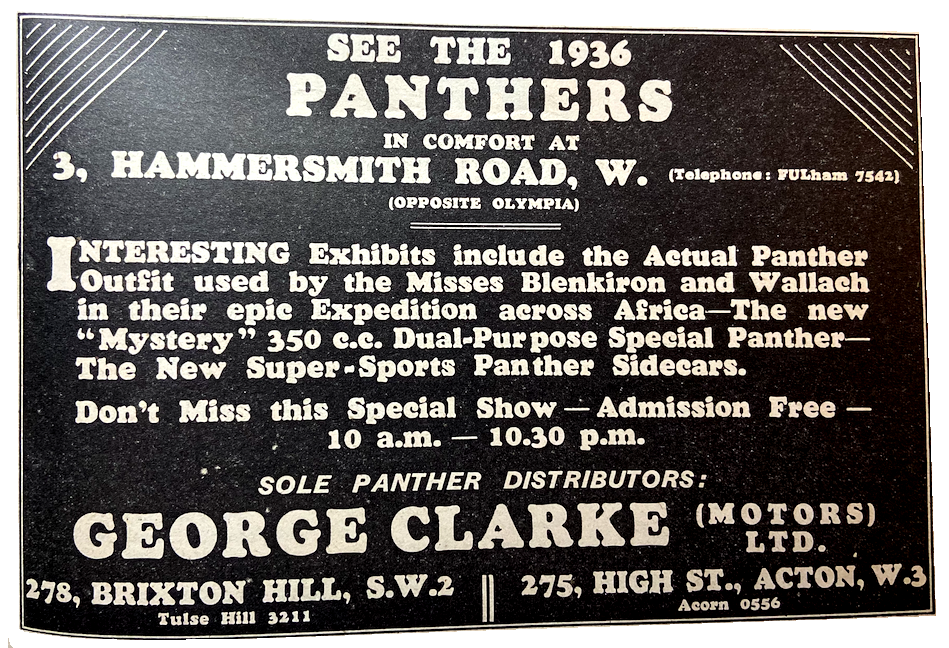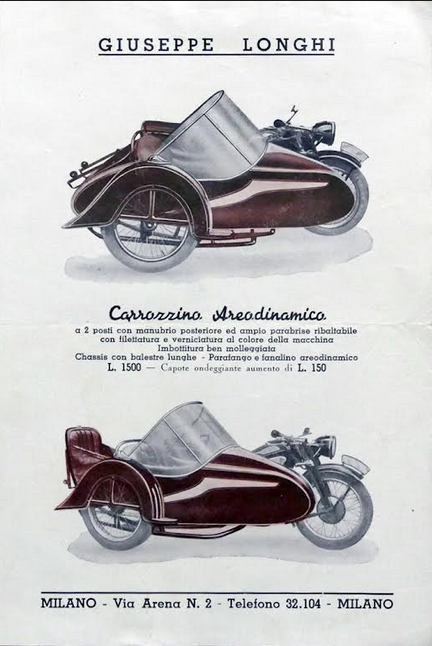The Blue ‘Un’s technical guru, Ubique, “Discusses the Improvements He Likes Best on Modern Machines, and Looks Forward to a Motor Cycle that Will Combine Speed, Comfort and Silence…
“IF YOU WERE ASKED what features you liked best on existing motor cycles, would you know where to begin? I am in that very position—I like so many things, great and small, that I have not a notion where to start. Those who are accustomed to my scribblings will expect to to have something to say about multi-cylinder engines and unit construction, so I will begin there, and get it over. My first choice would be a multi, and by that I mean something with more than two cylinders. We have two ‘fours’ on the market, and I like them both. Yes, I know my tastes are expensive, but that is a common failing with mankind. I like four-cylinder engines because they are smooth, quiet, fast, and accelerate wonderfully These are not just theories, for I have owned one of the two and ridden the other, and I have owned a third type which is now only built to special order. Next to the four I like a twin, preferably a flat twin because of its even firing and good balance. The mention of flat twins reminds me that there is a flat twin on the market with unit construction and shaft drive. Unit construction is one of my pet hobbies, because it leads to a neat, lighter, and more rigid unit, which can be just as accessible as a two unit job—vide New Imperial. I am all for unit construction, and, on
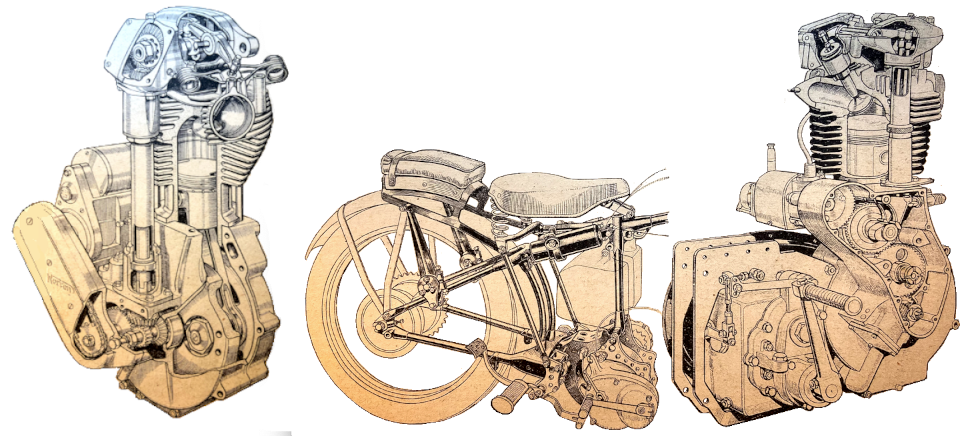
paper, admire shaft drive. In practice I like it only if there are enough cylinders and flywheel effect to make it smooth. I did not intend to get on to transmission matters so early, as I have in mind a lot more items to do with engines. First of all there is the overhead camshaft. More expense—but it seems quite obvious that with just the weight of the overhead rockers and no push rods and tappets, there is bound to be less wear on the valve gear. Further, an engine can run faster and with greater reliability for a given valve spring strength, or the same results can be obtained with lighter springs. Also, a well laid-out overhead camshaft looks so neat, does it not? Next to the overhead camshaft comes the high camshaft, such as is to be found on Velocette, Sunbeam, and Vincent-HRD models. It is less expensive and very practical. While on the subject of valves and valve gear, I like all-enclosed valve mechanism because I feel that no moving parts should be exposed to mud, dust and rain, but I also admire hairpin valve springs because most of the spring is well away from the hot cylinder head and valve stem. However, perhaps they are best kept to their own spheres, the one for touring and the other for racing. Even this is not quite right nowadays, for the Excelsior Manxman races with enclosed springs—shall we see enclosed hairpins in the near future? Another engine feature which I favour is the deeply-spigotted cylinder, which provides support where it is most needed and gives a neat and workmanlike appearance. I have already expressed a strong preference for unit construction, and this, as a rule, means a gear drive for the primary, and this also I like. But if a primary chain is employed, this, in my opinion, must be enclosed, and must run in oil. A clutch that runs in oil is often inclined to drag, and therefore I am in favour of some such scheme as that adopted by the Rudge-Whitworth people in which the clutch to all intents and purposes is oil. proof, and I am inclined to prophesy that there will be further developments in this direction. Humbly I submit that the rear chain also should also run in an oil-bath case, but Sunbeams do not appear to have many copyists. I wonder why? Of course, it involves a quickly-detachable rear wheel, but this is yet another desirable feature, so I for one do not hold that point against it. Wheels, of course, must be strong and stiff, and I like big tyres, but cannot the ensemble be made a little lighter? I am inclined to think that the use of really big tyres should enable the rims and spokes to be lightened, because the wheel in itself is smaller, and receive less shock. Present-day speeds demand big brakes, and it is just as important that the brakes should he waterproof. Further, I like the double brake lever bearing introduced by Excelsiors for the TT. In the matter of gear boxes, I am afraid that I am a bit unorthodox, for I want only three speeds. I have never found a good use for a four-speed box, except for (1) a racing machine, and (2) competition work. This in itself may be an admission of the desirability of four-speed boxes, but you who ride solo—how often do you use bottom gear? However many gears I have I

want fairly close ratios for the two top ones and a moderately low bottom ratio. The four-speed box has its advantages on a really snappy performer, for one can have three ratios close together and an emergency ratio. Also, it is undoubtedly useful on a low-powered machine, but on a slogging tourist three ratios ought to be enough for anyone, and a box of this type would be cheaper, lighter and less noisy, which means more efficiency. In any case, the gears should be foot-operated on the positive-stop principle. I have ridden many machines with spring frames. Some have been bad and some extremely good, and I think that it is fair to say that all the present-day forms are good. I have memories (years ago) of an amazingly comfortable lap round the Manx course on a Velocette fitted with a Draper spring frame, and have often been surprised that spring frames figured no little on racing machines until the last year or two. A similar type of frame has given me many a pleasant ride on Brough Superiors. Then we have the Vincent, OEC, Matchless, and New Imperial, all standardising rear springing. Why don’t we see more spring frames on the roads? In combination with a spring frame I like a long, slow front-fork action, with moderately heavy damping, and I like bottom-link forks because they remove some of the unsprung weight from the front of the machine. Another recent improvement, which I hope I may never be without, is the rubber-mounted handlebar. I have had an early Ariel bar in use for well over a year and can testify to its value, especially on long rims. Just one more matter regarding personal comfort—I like a big saddle, with one of those back rests which appear to be little more than a ledge to prevent the rider sliding rearwards. I have little time for cleaning my machine, and therefore I like an all-enclosed model that can be hosed and wiped down with a damp rag. I have one, too. My ‘Cruiser’ Francis-Barnett has excellent leg shields and mudguarding, and I have never needed waders on short journeys, whatever the weather. This all sounds rather ‘touristy’, but do not imagine that I object to fast machines—I like them. Yet I believe that speed, comfort and silence can be combined, and I think that we are getting nearer to that ideal every year. The ‘perfect’ motor cycle of the future will most certainly possess a good prop stand, although before I get too creaky in the joints I am hoping—and even expecting—to see such an increase in the use of light alloys that the prop stand will not be quite so urgently needed as it is now. Of course, the machine most be silent. I am afraid I cannot give an example of an existing machine in this case because none of them is as quiet as I should like.”
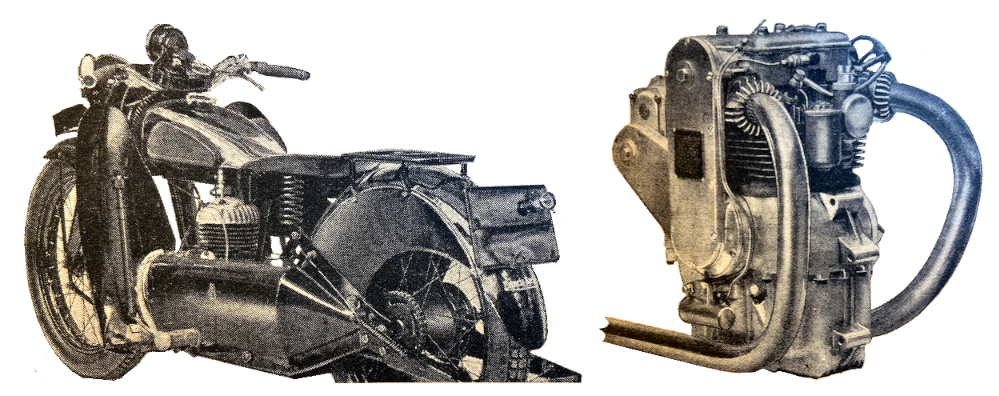
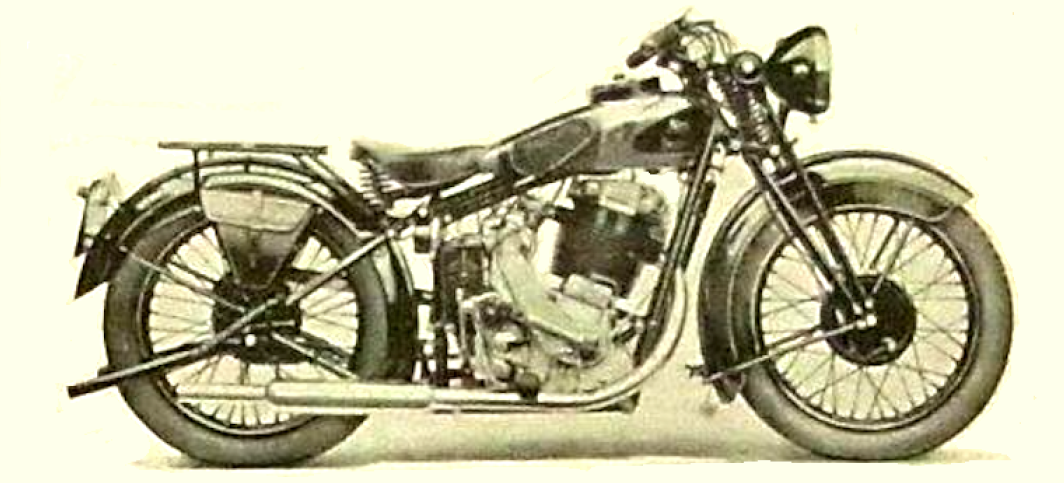
“A 498cc TT REPLICA JAP-engined machine is the outstanding model in the 1936 Zenith range. Known as the C5 Super, the new model has a very attractive specification and is designed generally to be a real ‘rider’s mount’. The massively built JAP engine has its cylinder deeply spigotted into the crank case. The valves are fully enclosed and lubricated; the rocker gear has automatic lubrication, and there is an adjustable oil by-pass to the cylinder itself. Dry-sump lubrication is employed, incorporating a fabric filter. The carburetter fitted is of the Amal down draught type. Ignition is by Miller Dyno-Mag. Transmission is through a Burman four-speed gear box with foot change. The primary chain is enclosed in an oil-bath case (with a detachable clutch dome), while the rear chain is automatically lubricated. The frame is of the full duplex-cradle type with Druid girder front forks with steering damper and shock absorbers. A low-lift rear spring-up stand is a useful refinement. A 26x3in tyre is fitted to the front wheel, and a 26×3.25in to the rear; a 7in front brake and an 8in rear brake are employed. Other detail points are the folding kick starter, two-lever petrol tap, three-gallon petrol tank, Dunlop saddle, rubber mounted handlebars, a quickly detachable portion to the rear mudguard, and a very complete took-kit. The finish is in black enamel, with the petrol tank chromium plated and with Zenith purple and black panels. The other machines in the range cater for widely differing tastes: the capacities of the machines range from 250cc to 1,100cc.”
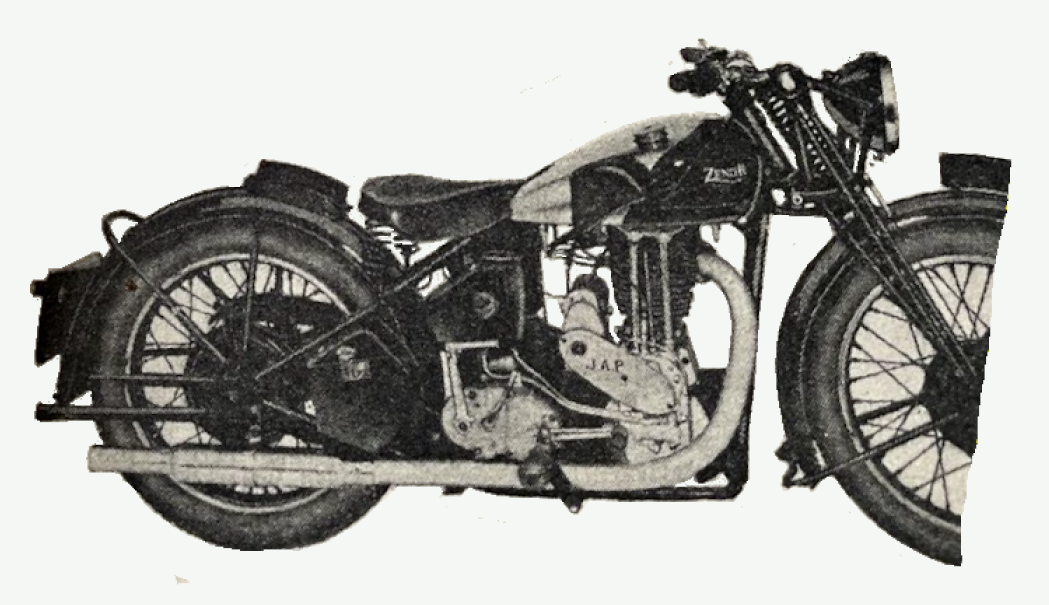
“HOW SIMPLE AND SAFE the modem motor cycle. is to ride has been proved up to the hilt—if additional proof were needed—by the announcement just made by the Post Office authorities regarding their motor cycle telegram service. In the past year 3,200,000 miles of city streets were covered by the messengers (all boys still in their teens!) without a serious casualty. About 200 machines have been in commission for 18 months, and each has had a yearly mileage of about 16,000. Where motor cycles have been used telegram deliveries have been twice as quick as formerly. Here are the views of a prominent Post Office official: “We are more than satisfied with the innovation, and we have reason to be proud of the boys who are in charge of the machines. The latter are all under 18, but they have proved skilful riders. Before the scheme was adopted some of us were rather nervous over the risk of accidents. The fear has proved to be groundless. There have naturally been some minor accidents in the heavy London traffic, but more often than not the fault been with the driver of some other vehicle. Certainly the motor cycles have turned out to be a successful means of telegram delivery. The idea that motor cycles are dangerous is exploded. Mechanical difficulties have been negligible, although each machine.is used by several boys. All the boys have been remarkably apt in mastering. the technicalities of the machines, in which they had a course of instruction. In time the service will be extended to cover the whole country.”
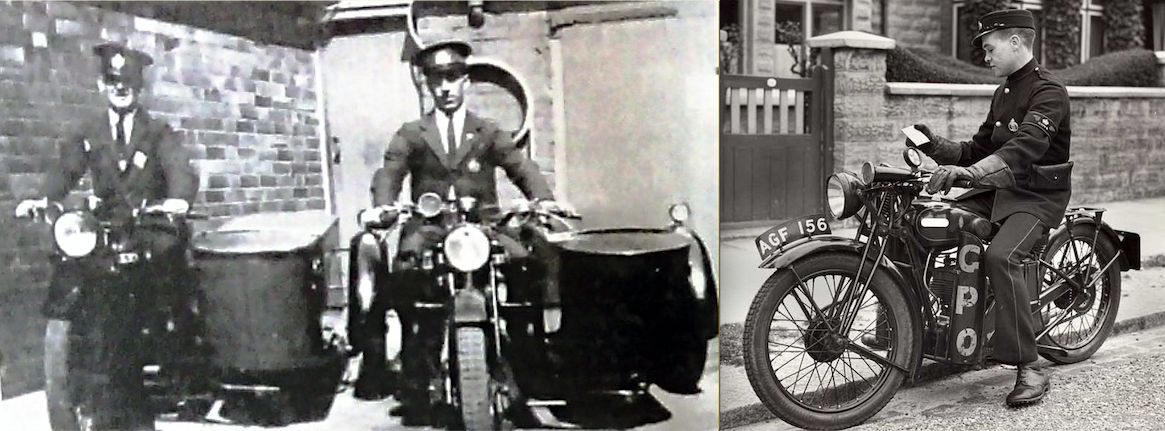
“AS WE CONFIDENTLY EXPECTED, the Postmaster-General’s experiment of mounting telegram delivery boys on motor cycles has proved a great success. The speed of telegram deliveries from the post offices concerned has more than doubled during the 18 months that motor cycles have been employed. And what of the boys themselves? No praise can be too high for these young riders—not one of them over 18 years of age. According to the official figures, the boys covered a total of 3,200,000 miles of busy streets during the past year—an average mileage of 16,000 for each rider—without a single serious casualty. When the scheme was first suggested, high officials in the Post Office were apprehensive about putting such young riders in charge of motor cycles. We are glad that the boys concerned have shown once and for all that not only is the youth of this country to be trusted on the roads, but also that the motor cycle is the safest and finest vehicle on which to gain experience.”
MOTORCYCLE SPORTING EVENTS at Easter included track racing, sprinting, grasstrack, speedway, trials, hillclimbing, sandracing and scrambles. Highlights included a sprint at Gatwick Racecourse in which Eric Fernihough and his blown 996cc BruffSup broke the 12sec barrier with an 11.72sec standing quarter.
“AA PATROLS IN THE past year covered, in the aggregate, more than 34,000,000 miles and rendered mechanical assistance on over half a million occasions.”
“SPEEDY SPEEDO. HIGHGATE motorist: ‘My speedometer was out of order.’ Policeman: ‘I agree. When the car was stationary the speedometer showed it was travelling at 11mph.'”
“WRONG-SIDE PARKING. ‘I am sorry to say there is no law against pulling up your vehicle and leaving it on the wrong side of the road. If there were, many accidents would be avoided.’—Mr Justice Humphreys.”
HARLEY DAVIDSON DEALER Earl Robinson crossed the USA from NY to LA on a Harley 45 flathead (that translates as s a 750cc sidevalve) in a record breaking 78hr 54min. Then he did it again on a combo with his wife Dot in 89hr 58min to set another record. They were both successful in long-distance trials; Dot later co-founded the Motor Maids of America.
“TENS OF THOUSANDS OF READERS are no doubt on holiday at the present time. If you are one of them perhaps the following cross-word puzzle, which I am including with the Editor’s permission, will amuse you even as it has amused me. As you will find when you delve into it, the puzzle contains much that concerns motor cycling. Next week I will publish the solution so that you can check whether you have got all of it right. One thing I can promise you: it is not difficult—I managed to solve it myself!—Nitor [Nitor edited the ‘On the Four Winds’ page of the Blue ‘Un; I plan to try the crossword but you’re on your own with the solution—it was published in the issue dated 15 August which I don’t have, so best of luck—Ed.]
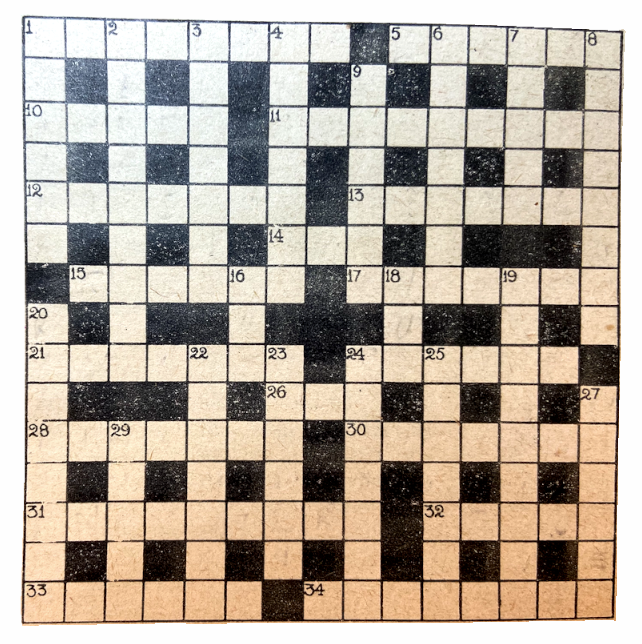
“WHILE ON THE SUBJECT of Post Offices, here is an out-of-the-ordinary adventure—quite true—which recently befell a reader, and which started in a small PO in East Sussex. When buying some stamps he overheard a gentleman making an enquiry re the licensing of his car. He had, apparently, forgotten to renew the licence, and the 14 days’ grace had also expired. Worse still, he had left his log book in his empty house in Dorset, 150 miles away! More or less as a joke, our reader offered to ride there, enter the house and find the log book, license the car at the local licensing office and return. The offer was accepted—and the whole thing was carried through successfully.”
“AN ELECTRIC CIGARETTE-LIGHTER may be constructed quite simply from a few oddments, usually to be found in the motor cyclist’s ‘ junk-box’. The lighter in question is fitted to a BSA, and in action takes only 1½ amps out of the six-volt battery. The items required are, briefly: A piece of ebonite 2in long by 2in wide, an ordinary handlebar-clip, three cheese-headed bolts with nuts, a small piece of spring brass (for the press switch) and a wireless earthing stud, an element from an old electric fire (about 2in long and containing three small coils), and two pieces of mica for insulating the element. Examination of the sketch will make clear the construction of the gadget, which is quite simple to make.—’JHT Jnr’.”
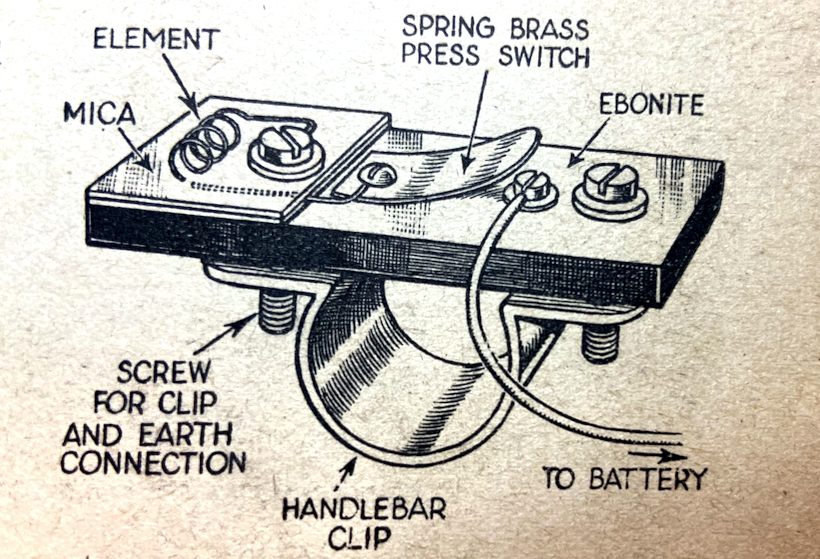
“TOO SENSIBLE FOR WORDS. After 45mph limit signs had been erected in Honolulu, it was discovered that the maximum prescribed by law was only 35mph. It was too expensive to alter the signs, so the law was suitably amended.”
“PRETORIA (SOUTH AFRICA) HAS started a ‘fines-on-the-spot’ scheme for motoring offences. Using an unlicensed motor cycle costs only £1, according to the official ‘price list’.”
“BORINGS IN GERMANY resulted in 48,098,700 gallons of petroleum in the first half of 1935, compared with 29,217,100 gallons in the corresponding period a year previously.”
“TOLL TALE. SURPRISE has been caused by the news that a profit of £120,000 from Menai Bridge tolls may be handed to the Exchequer. In some quarters it is felt that any surplus should be devoted to reducing the tolls.”
“‘OF ALL INDICTMENTS of the high-compression single-cylinder motor cycle there can never have been one so forceful as the mere sight of these clubmen trying to get their engines started…’ Thus ran a pertinent comment in our review of The Motor Cycle Brooklands meeting. It so happened that the very morning this was published we received a letter from a reader condemning the BMCRC for not allowing the clubmen to have assistance in starting up. Fancy, it is actually considered desirable that motor cyclists—young and, presumably, hardy clubmen, not elderly men who have, perhaps, lost their early vigour—have help in starting their own motor cycles! Does not all this bring home to the whole motor cycle world, and through it to every manufacturer of motor cycles, that there is something seriously wrong with the general trend of modern design? The blame lies with our almost slavish adherence to the single-cylinder engine and the constant demand for more power per cc irrespective of the consequences. We have stressed over and over again this desire for easier starting, but still the tendency is to concentrate upon one type of motor cycle, which by its very nature must restrict the number of would-be devotees of the most economical motor vehicle that exists. Some definite evidence of designing and manufacturing enterprise in the motor cycle world would prove a tonic.”

“A TOME AT HOME? ‘The Highway Code is not a novel or a history book, but its influence—its practical influence—can be as considerable as almost any book that was ever written.’ —The Minister of Transport.”
“CONVERSATION PIECE. Motor cyclist giving evidence at Highgate: ‘He said to me: “Why doesn’t your machine go?” I said I didn’t know. He said: “Why don’t, you know?” I said I didn’t know, and he said he didn’t know either.'”
“OWN MEDICINE. Distinguished Ministry of Transport officials, says The Daily Telegraph, were to be seen recently picking their way across Whitehall Gardens through a sea of tar inadequately covered with stone chippings.”
“AN ‘ALL STATIONS’ CALL and a signal to the police wireless cars sent out when a vehicle is stolen costs anything from £15 to £20, according to a detective-sergeant giving evidence at Tower Bridge police court.”
“MOTOR CYCLES ARE ON the increase again—this is the interesting fact that emerges from the licensing return issued last week by the Ministry of Transport. The latest statistics show that at the end of February this year there were 30,000 more motor cycles registered than was the case last year. This might be explained as resulting from the dry weather but…the number of motor cyclists is definitely rising. In the recent past there has been a widespread desire to possess that key to the open road and freedom, the motor cycle, but thousands, because of lack of money, were forced to remain ‘motor cyclists on paper’. The tide has turned, and we believe that, excluding the so-called boom years, there will be more motor cyclists than ever on the roads this Easter. Only two things are needed; first, the boon of good weather, and, secondly, the realisation that an ounce of rare is worth a ton of regrets.”
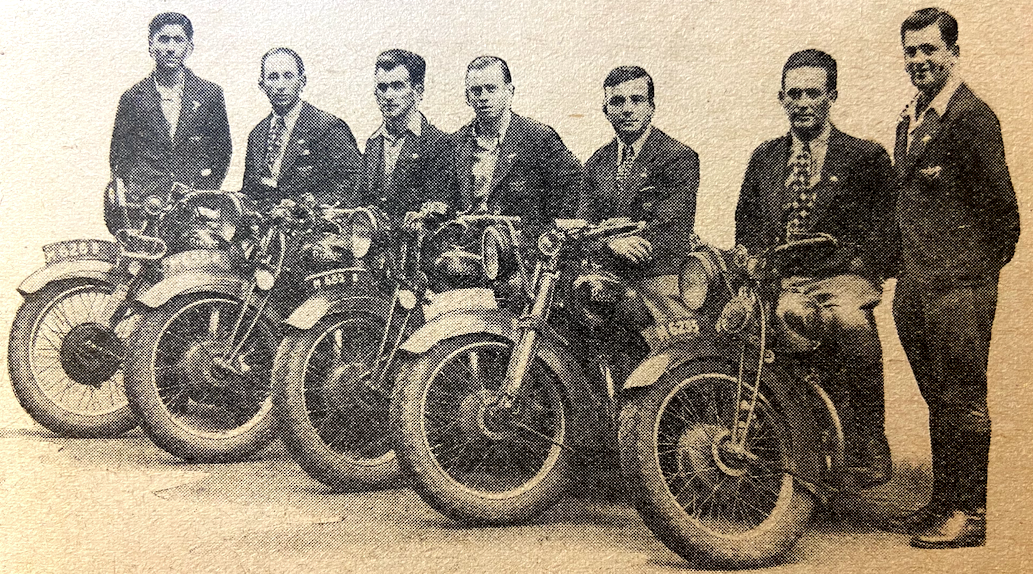
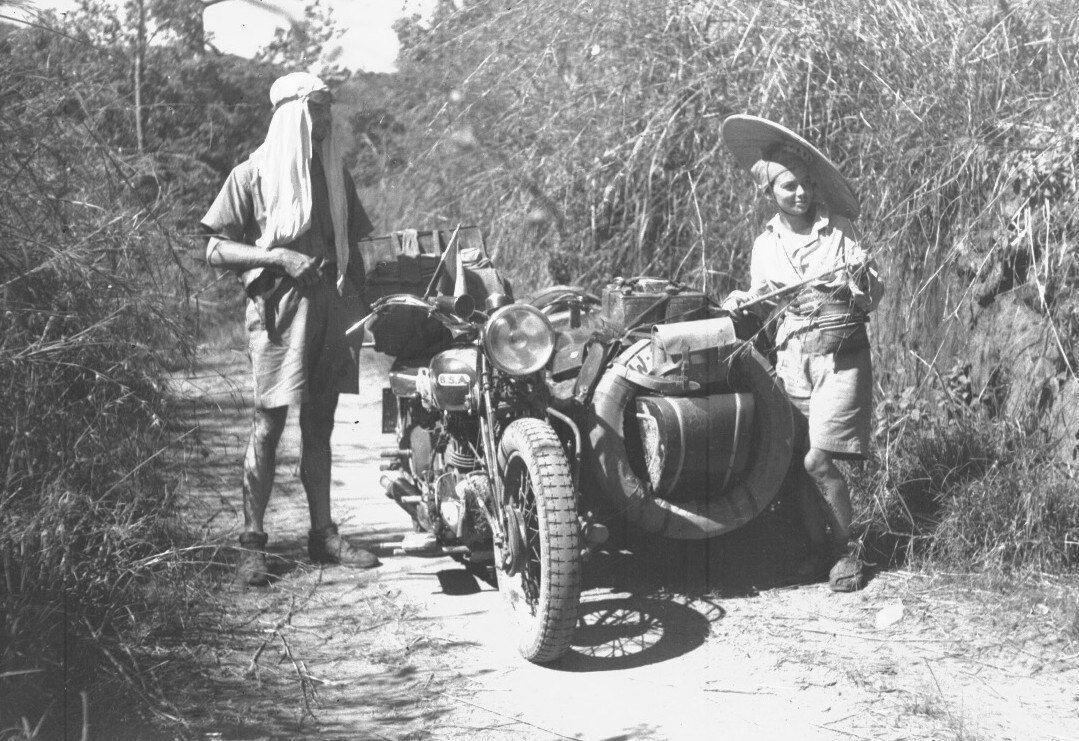
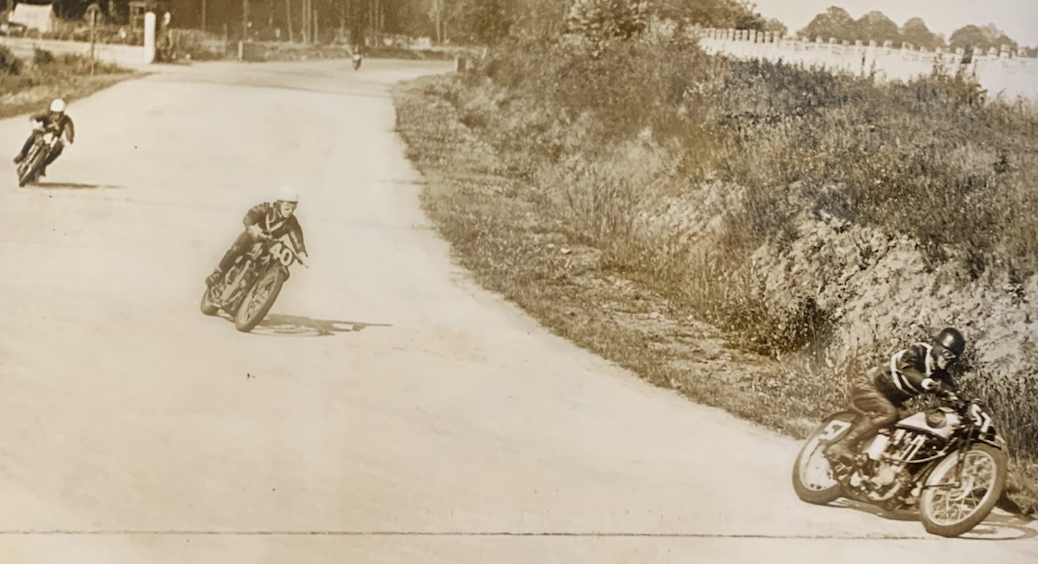
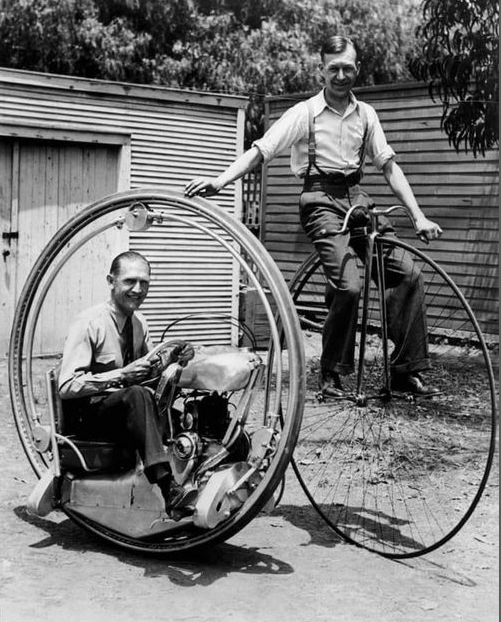
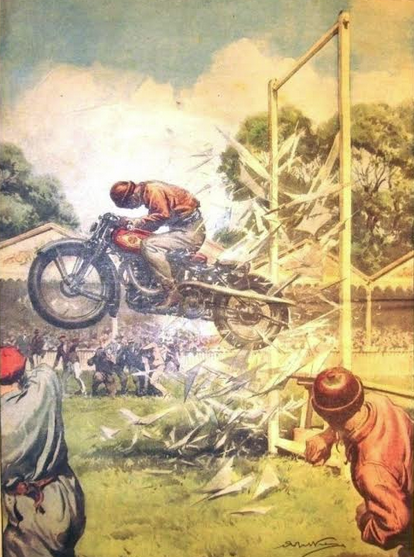
Prepare for three doses of Ixion. Beautifully written, as always, but thought provoking too.
“I HOBNOBBED with a Yank the other day. Quaffing an Ovaltine in my den at Benzole Villa he picked up the current issue of the Blue ‘Un, and I saw him bristle suddenly, as a terrier who smells something fresh and catsome. (Should have said that the Yank is a big publicity man.) He began to hold forth on what an extraordinary country Britain is. ‘In America,’ he said, ‘motor cycles sell in quite microscopic numbers, considering the huge population and the general size of their motor industry; and sell only to cops and working men. But here,’—he almost stuttered as he drew my attention to the 40-odd pages of small ads. at the back of the issue—’you contrive to exalt motor cycling into a national sport, as proved by this constant interchange of machines and parts between individual enthusiasts, and you sell them to wealthy youngsters as freely as you sell them In factory apprentices.’ From that we wallowed in a lengthy argument as to why all phases of motoring are more individual and more sporting in England than in other countries, which emphasise the social and utilitarian aspects more than we do. I suppose the only answer is that we Britons are more individualistic. My Yankee friend admitted that he never dreams of driving himself when a chauffeur is available—a weakness which seldom assails us till we are seventy. It was also agreed that we Britons place a possibly exaggerated emphasis on sport of all sorts. We instanced two rich young men of our acquaintance—the one an American, who employs a chauffeur and seldom drives his own roadster; the other an Englishman, who will not allow anybody but himself either to drive or to adjust his Bentley.”
“ALTHOUGH I HAVE A PASSIONATE desire to see youthful male and female labour motorised, it is not due to self-interest. If a couple of million cheap lightweights could be sold in 1936 it would not benefit me personally a stiver. I am much more altruistic than I sound; and I dream of motorising the mass of labour because: (a) Motor cycling is a great asset to health. (b) Motor cycling is a great convenience. (c) Motor cycling makes a man concentrate, and his worries are driven out of his mind when he is in the saddle. (d) Motor cycling is highly educational, and teaches judgment and self-reliance. (e) Motor cycling facilitates far more enjoyable holidays than the railways or motor coaches. (f) Motor cycling introduces great variety into lives which’ without it may become monotonous.”
“DURING AUGUST BANK HOLIDAY the roads leading to the coast and to the many beauty spots were a-hum with happy, care-free motor cyclists. Adherents to the sporting side had their pick of many road races, trials and grass-track meetings organised by clubs up and down the country, and every event had its huge and enthusiastic following. Despite the busy condition of the roads riding was more than usually pleasant owing to the noticeable all-round improvement in road manners. Observation showed that motor cyclists were particularly praiseworthy in this respect, while drivers of other vehicles also appeared to have taken the injunctions of the High-way Code to heart.”
“THE MANAGING DIRECTOR of the Enfield firm has had a 98cc miniature built for his seven-year-old son—and I warrant the said son is the envy of small boys all over the Empire. The news set me thinking, for I often encounter a difficult problem which it might solve. A lad of licenseable age pesters his parents to equip him with a motor bike. His parents see me. They are moderately willing, so far as £sd goes, and admit that Jack has made himself fairly safe and knowledgeable on a push bike. But youth is naturally a little impetuous and rash; and the parents dread lest Jack should commit some blunder in his initial essays on our congested roads. Very probably there is no really quiet place where Jack may put in some hard riding practice. I usually solve their difficulties by driving Jack to some lonely place in a car and taking a baby two-stroke for him to learn on. But if I had a big agency I would coax Enfield’s to list the 98cc miniature as a production job; buy one, and instead the youth of my neighbourhood on cricket fields and other enclosures where no licences are necessary and where no age limit exists. What a happy afternoon any boys’ prep school could spend under such conditions!”
FOR THE FIRST time TT competitors were allowed to warm up their engines before the start; travelling marshals were appointed to patrol the course during races; pit crews were allowed to do more to help their riders; and the Manx flag was waved by the starter in place of the the Union flag. Understandably, after its traumatic 1934 experience, Husqvarna stayed away from the TT so Stanley Woods rode 250 and 500cc Moto Guzzis. The previous year Woods had made the fastest Senior lap and if he hadn’t run out of fuel would have won. In 1935 the ‘foreign menace’ was gathering momentum. Woods’ Senior Guzzi twin head effective rear suspension—the only Brits with rear suspension were Vincent-HRD and OEC. From Germany came 250 and 500 DKWs and NSUs which were known to be race winners on the Continent; they were joined by a brace of ohc unit-construction Jawas in the Junior and while the Czech contenders were untried no-one doubted their potential. Among the 107 entries were riders from Australia, Denmark, France, Italy, Spain and New Zealand. Woods broke the Senior lap record by more than 30sec during practice; his team-mate Omobono Tenni did likewise with the Lightweight lap record. But the Junior, as expected, was a repeat of the 1934 race with a Norton hat-trick courtesy of Jim Guthrie, Walter Rusk and ‘Crasher’ White—Norton’s fifth consecutive Junior victory. There were 19 finishers in the Junior; Norton, Velocette and AJS took the top 14 positions with Jock West’s NSU 15th, followed by three more Velos and an Excelsior. Two Jawas and two NSUs were among the ‘DNF’s. But, also as expected, Stanley Woods and his Guzzi took top honours in the Junior (setting another lap record in the process) to
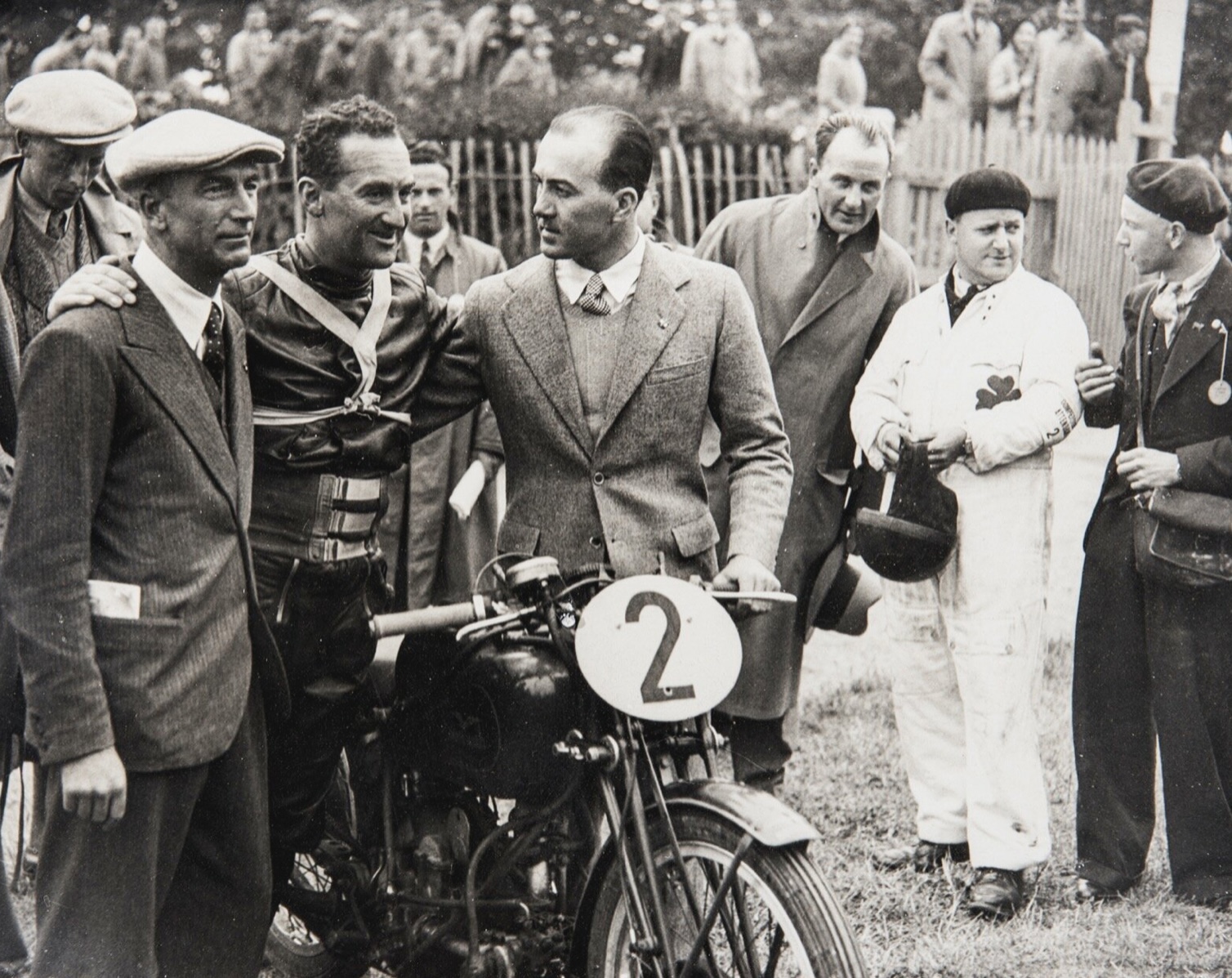
record the first TT win by a foreign marque since the Indian tribe’s Senior hat-trick of 1911. He was chased home by Tyrell Smith and Ernie Nott of their Rudges and Ginger Wood on his New Imperial—three top TT riders on three top TT bikes. The message was clear: the TT was no longer a British benefit. A DKW and a Guzzi finished 7th and 8th—Omobone aboard the third Guzzi held second spot until lousy visibility caught him out and he crashed at Craig-ny-Baa on his fifth lap. Two DKWs failed to finish as, in the marque’s final TT appearance, did Freddie Clarke’s OEC. The big question was, could that man Stanley Woods and the 120° V-twin Guzzi do it again against the might of the Nortons? The poor weather that had dogged the Lightweight deteriorated to the point that, for the first time in TT history, the race had to be postponed. Many fans had to go home; so did some Senior competitors (including Noel Pope who had an
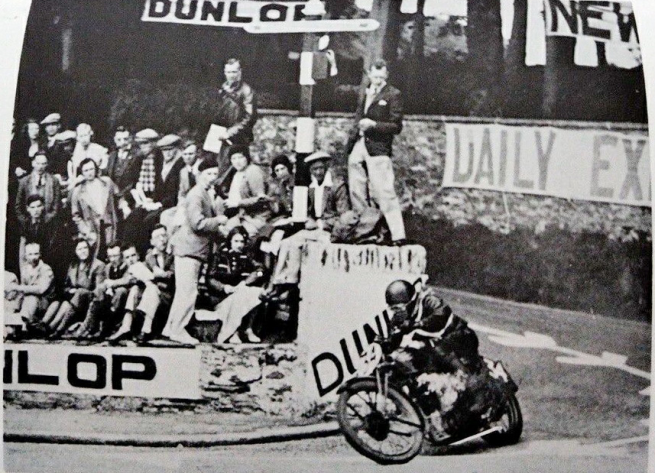
appointment at Brooklands…as we’ll see, it was a good call). But finally the mist on the Mountain cleared enough and the stage was set. At which point I’m handing over to TT Special editor Geoff Davison for an eye-witness account: “I can only describe the 1935 Senior as a terrific race. It was the fastest Senior up-to date, the course was lapped at over 86½mph, and it was won by the narrow margin of only four seconds. Jim Guthrie led on the first lap, with Walter Rusk on another Norton 27sec behind and Stanley on the Guzzi a second behind him. Then on the next lap the Irishman drew into second place, 47sec behind the Scots Norton rider. Jim increased his lead to 52sec on the third lap, but the difference was 42sec only on the fourth lap. The fifth lap saw Stanley creeping up, now only 29sec behind, and on the sixth lap 26sec. ‘Jim’s done it again,’ we said. ‘Stanley can’t catch him.’ Jim was No 1 in the race, by virtue of his last year’s win Stanley was No 30 [and thus started 15min later]. Jim came flying past the finish and everybody at the Grandstand rose to cheer him as winner of his fourth TT race in succession. When the lap times went up it was seen that Jim’s last lap had been covered in 26min 40sec, as against 26min 31sec for the lap before. It was, indeed, his slowest lap except the first, from a standing start, and the fourth, on which he re-filled. Still, he has plenty in hand, we said;
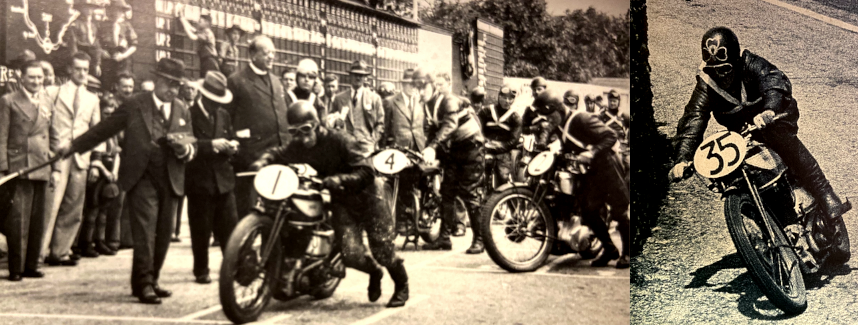
Stanley can’t do it. But Stanley, on the far side of the Island, was doing all he knew. Spectators reported that on this lap he was really in a hurry—not half he wasn’t! Flat out he went round that last lap, to do it in 26min 10sec, to break the lap record by nearly 4mph and to win the closest-ever TT race by four tiny seconds. And whilst he was doing it, Jim stood quietly at the pits, with anxious eyes on Stanley’s clock; knowing, of course, that he could have made his last 26min 40sec a 26min 30sec lap without any effort at all…So the Norton winning sequence was disturbed by an ex-member of their own team, a rider who had won five TTs on Norton and who that day scored his eighth TT success.” Everyone thought Norton had done it again until Woods flashed over the line and over the loudspeakers came the announcement: “This is the clerk of the course speaking, Stanley Woods is the winner—by four seconds!” So instead of their expected 1-2-3 Nortons ridden by Messrs Guthrie, Rusk and Duncan finished 2-3-4 to take the team prize—but they were followed home by Otto Steinbach and Ted Mellors aboard NSUs (once again a brace of Jawas failed to finish) and the TT would never be the same again although it was a good year for HRD-Vincent; having abandoned JAP in favour of the Phil Irving-designed own high-cam engine the Stevenage crew finished 7-9-11-12-13.
WOODS LATER DESCRIBED THE race in a feature for the Blue ‘Un: “In this Article, Describing His Tactics in the Most Thrilling Road Race of the 1935 Season, Stanley Woods Shows an Ability for Writing that is Second Only to His Skill as a Rider” “There has been so much written about my win in this year’s Senior TT that perhaps it will be of interest to many followers of the game to know the inside story of the race and of the events which led up to it and determined the tactics used by me. In the the first place it will be remembered that this year, previous to the TT races, I failed to finish every race in which I started on Moto-Guzzi machines. My retirement in each case was caused by a more or less serious engine failure—and every time something different! This state of affairs rather damped my hopes of success, but with three weeks to go before the start of TT practice, we set about modifying the parts which had so far given us trouble. In addition to addition to these modifications we reduced the power output by lowering the compression ratio quite a bit. The fact that we were ready for practice speaks volumes for the energy we expended. It soon became apparent to us that, excluding mechanical failure, we had little to fear in either class. My win in the Lightweight confirmed this, but upon examination of the engine after the race I realised that I should have to change my methods of driving if I wished to complete the course in the Senior. In the Lightweight race I drove the engine to peak revs (7,700rpm) in each gear, but seldom exceeded 7,300rpm in top, except on the second lap when I drove as hard as I could! Accordingly I began to work out how quickly Guthrie would go—and promptly slipped up very seriously! I forgot that in practice last year he had lapped in 27min 1sec, and that if conditions had been good in 1934, in all probability he would have gone round in about 26min 50sec—so I let myself be misled by his best practice time this year (speaking from memory, 27min 20sec). I expected an opening lap at about this speed (82.3mph) and decided that it would suit me nicely. Thus, I would save my machine and at the same time lull the opposition into a false sense of security, as during the last three years my tactics have been to establish a good lead as early as possible (when possible!) and then hold it. My idea was to keep somewhere near Guthrie on time until the last lap, and then take the lead with a final lap in about 26min 30sec. But, as is often the way, the best laid plans slip up. Came the great day, with both my private telephone stations and timing staff working perfectly. My pit man was drilled to perfection; he knew that I would fill up at the end of the third lap, and was prepared to give me half a gallop or so should I need it at the start of the last round—and was anxious to bluff the opposition into believing that I would definitely need it and so perhaps make my task a little easier. A final talk on the phone to my ‘back of the Island’ station at about 10.15am gave me the reassuring news that conditions were rapidly improving, and that as far a Ramsey there were only two slightly damp spots—bright news indeed after the previous three days’ conditions! A last word to the lads in charge of my ‘No 2’ station at Glencrutchery Road and I leave for the Paddock. The extra half hour’s wait, due to the postponement, throws an extra strain on all the riders, but I am not unduly nervous and the time soon passes. From the word ‘Go’ my bike runs perfectly, and in accordance with my plan I do not exceed 7,200rpm in the lower gears or 7,400rpm in top. With the exception of a severe skid at Greeba Castle, due to the frame dampers being a shade slack, I have an unexciting run until I reach any timing station, where I get the ‘thumbs down’ sign—meaning that I am a little behind Jimmie G. I am tempted to open up, but caution wins—or almost wins—and I let her go up to about 7,300rpm in the gears up the Mountain. However, I go gently down the gears and easy on the bends as she is a very different machine from my 250, and I have not ridden her at racing speeds since Wednesday week—and then only for two laps! The day is perfect, and conditions could not be better—just a few wisps of mist high up on the hillside before the Bungalow. I thank heaven that the ACU did postpone the race—what a difference from Wednesday! This is real racing. What a. joy to have a machine under one which is anxious to go faster than one thinks necessary! And so to the end of Lap 1. Through the pits so fast that I can only just pick out my pit as I flash past—but it is only necessary to locate it accurately for my filling-up stop, as I get all my information at my ‘No 2’ station several hundred yards below the pits. Here a shock awaits me, for ‘No 1′ has telephoned through the correct results for the first half-lap—’Second, 15 seconds behind.’ A nasty shock, but I must not panic. Down Bray it soaks in—15 seconds in half a lap! Then I remember those extra hundred revs up the Mountain and decide that that will hold Guthrie OK. On I go, keeping the revs down, but going a bit harder on the bends till I reach ‘No 1’ station again and get the times for the first lap—still second —that’s OK, but now I am 28 seconds down. I panic for a while and turn on the gas for a mile or so. It is surprising how much time one has for thinking when travelling round the Island at about 84mph, so Reason soon returns and I throttle back, but decide to lose nothing on riding. Up the Mountain once more and down again to Douglas. More bad news—a lap and a half done and and another nine seconds lost. A total of 37 seconds in arrears—this will not do, so reluctantly I decide that I must go faster. I decide on 7,400rpm in the gears and peak safety revs—7,700— in top.
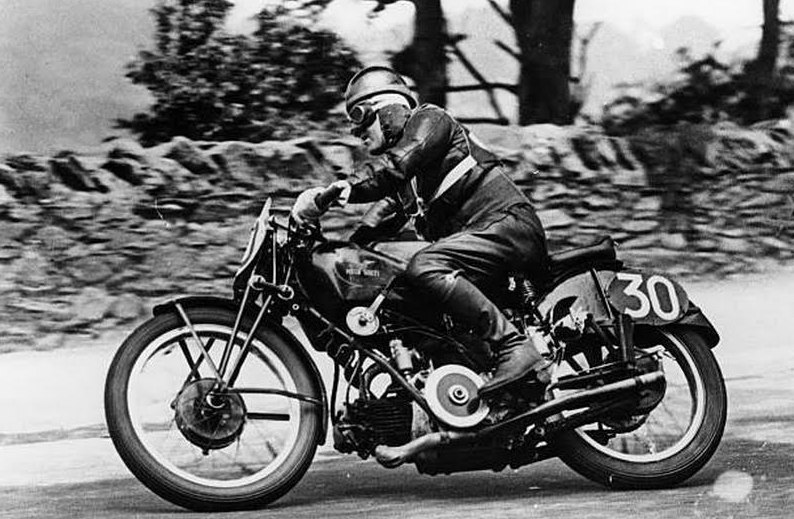
The Guzzi seems to like it, and, of course, pulls the higher gears much better after revving up the extra bit in the lower ones. I reach ‘No 1’ again and find myself another 10 seconds down—47 seconds for two laps! I won’t know how much good my extra revs are doing until I pass the finish and get ‘No 1’ station’s report by ‘phone. Entering Ramsey I come up against my first snag—a couple of slower riders who hold me up for a few valuable seconds, which seem like minutes. The same trouble occurs again on the Mountain, but I soon get by and go on to finish the third lap. I accelerate hard from Governor’s while opening the tank caps and slow down early and brake to a gentle stop in exact position at my pit. In goes the petrol and oil, a heave, a few staggering steps, and the Guzzi bursts into life once more. A glance at ‘No 2’ station tells me that at last I’m holding Jimmie G—in fact, I have pulled back two seconds and am now only 45 seconds behind. Once more I tackle the ever-terrifying Bray, but this time with a lighter heart, and so on without incident to Sulby where I get further information from the timing staff. Curses! Another seven seconds down—a total of 52 seconds for three laps. I fume as I remember those baulks near Ramsey and on the Mountain, and I hope I shall meet no more. On to Ramsey—the Bungalow—Windy—the 33rd—concentrating on the exact line everywhere, and happy in the knowledge that I am taking each bend faster every lap. The Stands with their waving flags and cheering crowds, and—Cheers! my signal showing a gain of four seconds. Here comes Sulby—another six seconds saved, but still I am 40 seconds behind and with only three laps to go I reckon it out as I approach Sulby Bridge. I gained six seconds that last half-lap 12 seconds a lap and I need 14 to tie. Surely I can do it without over-driving—surely I can find those few seconds somewhere on the innumerable bends. I feel sure I can and decide to nurse my engine a little while longer. The Stands again. The strain of restraint is beginning to tell and I can hardly wait for my signal. My optimism is justified for I have pulled back another seven seconds. I start the sixth lap confident of victory, and perhaps for this reason I have my one and only super thrill of the race. Approaching ‘Handley’s Cottage’—a tricky left-right double bend between the 11th and 12th milestones—at about 107mph, I forget to shut off until some considerable distance past my usual braking point. I suddenly ‘wake up’ and indulge in some really hectic braking and scrape through at about 10mph faster than I’ve ever got through before! A very rude awakening, but a lesson to me. Sulby’s tale is not so good when I get there. I am still 29 seconds behind, but I decide to hold to my schedule and not use maximum revs unless I have to. Ramsey and the climb over Snaefell one more, my motor going better than ever. The spectators realise that I am still in the running and are cheering wildly. Craig-ny-Baa is a wildly waving mass of arms. A strange thrill runs through me to know that they are cheering my efforts, and showing the true sportsman’s appreciation of a race well run, whether the rider be first, second, or also ran. Glencrutchery Road, and a quick glance into my petrol tank to make sure that all is well. To stop means to lose the race, but better second place than ‘Stopped on the Mountain’ as in 1934! All is well! For the first time in the race I let her go to peak revs in third gear, only engaging top below the pits. There is my signal—second, 21 seconds behind—another eight seconds saved. That was at Sulby I reckon as I rocket down Bray Hill at almost peak revs in top—110mph. Another eight precious seconds saved by the end of that lap will bring Jimmie’s lead down to 13 seconds—and another lap to go at 8 seconds a half-lap makes 26 seconds—I’ll win by three seconds! These simple calculations have brought me to Braddan and then the devil ‘Doubt’ creeps in. Surely the Opposition—familiarly known as Joe Craig—will have signalled Jimmie to unleash another horse or so, for he cannot have failed to notice my progress. I’ll have to risk it and turn on those extra revs—no I won’t, I will, I won’t—I will—three seconds is too close a margin when dealing with a combination like Jimmie G and his Norton. So leaving Union Mills I turn it all on, and the way the Guzzi responds in third after peaking in second is a joy. I get into top before Glen Vine, but realise the extra speed at which I’m travelling and return to third for this tricky right-hand bend. Back into top once more I find the revolution counter showing 7,700rpm. By the foot of the hill before Crosby it shows 7,900—about 116mph. Up the hill through Crosby it falls back to 7,700. Down the hill to the Highlander I keep her throttled down to that speed—fear for the engine and of the road surface helping to restrain me. From now on I most be careful. I am tiring slightly and am not accustomed to the extra speed which I am using. I must watch my braking points very carefully and shut off just the correct amount earlier to allow for this extra speed. Thank goodness the brakes are standing up perfectly. From the Highlander to Ballacraine I run with some slight restraint on the revs, and then I begin to think once again of the wonderful record of Jimmie and his Norton. To blazes with restraint! I run up to 7,700rpm in the gears and let her go as high as the road will let her in top. After all, once during practice I let the practice machine go to 9,000-odd in second and nothing broke. Quite by accident, may I add! On up Glen Helen and Greg Willeys, screaming in second and third, and then down Cronk-y-Voddy, screaming in top towards the bend. Then up to 7,800rpm before I shut down. A light touch on the brakes—third gear is engaged and down to it once more. I ease in time for Handley’s Cottage this time, and then prepare for that wonderful drop down Begarrow to the ’13th’ milestone. Round that—too bumpy to think of the rev counter—just about on the grass for a few yards—must take it easy! More bends—more bumps—a short straight—Kirk Michael, Birkin’s Corner, Bishopscourt, Ballaugh, The Quarries, Sulby, and my last signal…What a signal! Instead of the expected 13 seconds I see ‘2nd, 26 seconds.’ I can hardly believe it. What has Guthrie had in reserve? I almost despair, but thinking to die game I crouch even lower on the tank and by the end of the straight see the needle touch 8,000—118mph! Ramsey and the Mountain—I most not lose a hundredth part of a second anywhere. My motor responds better than ever, and peaking on all gears I top the long climb at 7,500rpm in top. Round the bend by the telephone box I get on the grass again, but it is smooth and it is where I meant to go. All along the course little groups of people are shouting and waving. The Bungalow, Windy, 33rd, Keppel Gate and down to Craig-ny-Bea with its cheering mob at 120mph. On to Brandish with the engine revs mounting and higher, and then hard on with the brakes for Brandish. Peak in second, peak in third, up to top, cut her off, brake, third, second. Off again, only another couple of miles. Seconds to save, but I must be careful. The bends are slower from Hillberry, but so tricky. The cheering crowds tend to put me off—I must ignore them—not even a little smile—except perhaps one of sheer happiness after a splendid race, for after my last signal I do not think that I can possibly win. Signpost, Bedstead, The Nook, Governor’s, the finishing straight—the chequered flag…I shoot off down the road some hundreds of yards. My Italian friends come running after me and smother me in congratulatory embraces—for what? For a good second? For a stout effort? I don’t know! Suddenly, a voice says, ‘Good lad! You’ve done it by four seconds!’ That was the biggest thrill of my life!”

“HOPELESS—THAT IS HOW it seemed to Jimmy Guthrie. He wrote letter after letter, asking for he chance of riding in the TT, but not a solitary manufacturer displayed the slightest interest. This occurred little more than ten years ago, at a period when almost the entire industry races. was supporting competitions, and particularly the Tourist Trophy races. As I chatted with Jimmy, our thoughts—his and mine—turned to the present day. How much more difficult it is—indeed, next to impossible—for the budding star of to-day to break down the barriers and get his chance as one of a works’ team. As Jimmy said, there are so few makes to be approached. He himself had a hard enough task. Already he had done well in speed trials, sand events and hill-climbs. True it was in a small way, but he had been racing on his own account for five years and more. He started in 1920, following a spell in the Army as a Despatch Rider, and he had ridden in the Island in 1923 on a Matchless, more or less as a private owner. Having regard to his speed trial successes it might have been thought that some manufacturer would have sat up and taken notice of his possibilities as a racing man, particularly in view of the hold racing had upon the public. The way he got his chance is interesting. He was always a clever mechanic, and he succeeded tuning his AJS until it was moving really well. It was the Druridge Bay speed trials in 1926 that set him on the path to fame. The late Bert Le Vack, Brooklands idol and one of the most famous racing men of the day, was there; so was another well-known New Hudson rider, Ted Mundey, while looking on was Mr Price, who was managing director of the New Hudson company. Jimmy Guthrie had already approached Mr Price but without avail. The private owner proceed to wipe up Le Vack, winning both the 350cc and 500cc events—a lone man with no works’ backing against a powerful company and two of the best-known men in the racing world…Along rushed Mr Price and asked Jim whether he would ride for New Hudson. Jimmy would and did. ‘Things went very smoothly after that,’ says Jim. The following year he made his first pukka appearance in the Isle of Man, and if you look up the records of past races you will find J Guthrie (New Hudson) second in the Senior of 1927. He was a made man, and I believe I am correct in saying that from that day to this Jimmy Guthrie has only once finished a race without being either second or first. How many races this means in all goodness knows. In 1935 alone he was first in the Junior TT, second in the Senior TT—beaten by a mere four seconds—first in the 500cc North-West ‘200’, first in the 500cc Swiss Grand Prix, second to his team-mate, Rusk, in the 350cc Swiss Grand Prix, first in the 500cc Dutch TT, first in the 500cc German Grand Prix, first in the 500cc Belgian Grand Prix, first in the 500cc Grand Prix of Europe (Ulster) at 90.98mph, first in the 350 and 500cc classes of the Spanish TT, and, more recently, has raised the 500cc hour record—the ‘Classic Hour’—to 114.09mph. No ewer than nine firsts and two second places in famous international road races in a single year—what a record ! And if you talk to Jimmy you will be told that he owes it all Nortons: to the machines, to the directors, to Joe Craig, to the design staff and the Norton mechanics. To get him to talk about himself is next to impossible. There are one or two things I can tell you about him, though. Jim, as all are aware, is a Scot, and hails from Hawick, where he is in partnership with his brother in a garage business. They have a big machine shop; this is,Jim’s job, while his brother looks after the sales side. There is a lot of repair work, and that causes Guthrie’s difficulty—it is next to impossible for him to find time for any special training when he is at home and difficult to get away for the actual racing and practising periods. He has to rely chiefly upon work to keep him fit—work which often causes him to be still at it until eleven and twelve at night. The last year or two, however, he has really tried to make himself as fit as possible. He used to feel that it was impossible to compete with the younger lads in the Norton stable, such as Tim Hunt and Stanley Woods, and then he decided he would have a shot at it. Few people realise the fact, but Jimmy Guthrie is over 38 years of age. As I say, he decided to become as fit as he could. Once or twice a week he goes from Hawick to Edinburgh for 1½ hours’ muscle development exercises…While obviously the endeavour is to develop his wrists and arms, the important point is to develop his body as a whole, for in these days perfect fitness is essential to the road-racing man who is to hold his place at the top of the tree. What Jimmy finds really difficult is giving up smoking. He tried to do so last Christmas, ready for the TT in June, but never succeeded for more than a week or two, though he has managed to cut the number of cigarettes down to two or three a day. On the particular day I had this chat with him the racing season was a thing of the past, and the number he smoked— well, I didn’t count! In addition, Jimmy likes to have an hour or two each day on a motor cycle, but nowadays it is impossible to do any batting, he says, in view of traffic conditions and the speed of modern racing machines; therefore there is no chance of developing judgment at high speeds or indulging in true racing-type cornering. Since Guthrie is not a mere jockey but a real mechanic as well as brilliant rider I asked him how much work he does on his machines. In the Isle of Man, he said, all he any has to do is to ride, but on the Continent, if there is work to be done, he and Joe Craig do it. Fortunately, he added, there is seldom any need for anything except changing the carburetter jets to suit the the local fuel and conditions, and fitting new chains and tyres—fortunately, because there is very little time in view of the travelling from one race to the next and the need for getting in some practice on the fresh circuit. Since the Norton men do not necessarily ride the same machine each time I asked Jimmy about the alterations they have to make to the riding positions. I learned that one and the same position suits every member of the quartet, so there are no worries in this direction. From that I passed on to questions about Jim’s own riding position—there are few men who squash themselves so fiat along their tanks and. thus cut down wind resistance to the same degree. Had he ever tried lying down to it in front of a mirror? No, he hadn’t, and he mentioned that you cannot keep down to it when at speed in the same way that is possible when the machine is stationary. He added that one day he had to have three stitches in his chin—that was before his tank top was covered in rubber. ‘Even now you get some clouts,’ he said, feeling his nose tenderly as he did so. While on this question of lying down to it, he stressed again the need for fitness. ‘The young man who is naturally fit has a big advantage over the older hand,’ he added, ‘especially in a massed start, for he has started and is away yards—miles—before you are.’ Of course, we discussed riding methods.
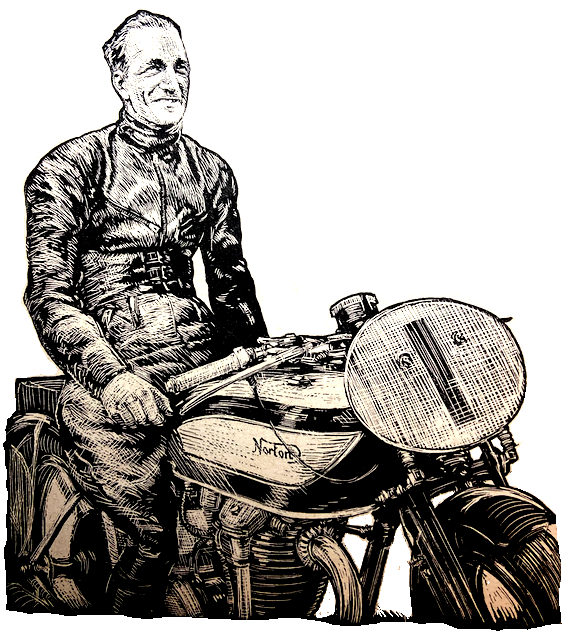
You have or to go quickly in the TT right from the signal to start, said Jim. He used to have trouble in this direction—it took time before he became warmed up to it—but now, he says, the one thing he has to guard against is that he does not go too quickly—he has to hold himself in until he has settled down and feels he has got everything weighed up. He blames old age—or blesses it!—for teaching him that wild riding does not pay. Twice he came off this year, but in neither case was it wild riding. The first time was in the Leinster ‘200’—he had had no practice and came off on a patch of loose stones—and the other occasion was avoiding his team-mate, Walter Rusk, who had fallen at Aldergrove in the Grand Prix of Europe, that is, the Ulster Grand Prix. Nowadays, he says, one spends most of the TT practice period batting round the course trying to find the bumps and the way to miss them. On the bends, however, the line that can be taken is very limited, and often it is quite impossible to miss them. Within limits, Jim says, it is quicker to charge over the bumps than to take a bad line. This year he tried almost every conceivable course down Bray Hill. He even walked down it several times in order to spot the bumps and find a new route. It was hopeless, though, for he could not spot the bumps barring the obvious ones, and those he knew already! Finally, he gave up the task of finding a smooth route as being a bad job. Slow corners are the ones he does not like. On hair-pin bends, he says, he never seems very clever, and always feels that he is going slower than the others. Guthrie’s practice is to lighten down the steering damper until he feels that it is just gripping—so that with the front wheel off the ground the handlebars are stiffish to turn—just that and no more. All the damper does is to act as a steady; an important one, as will be realised when I mention that two years ago in the Island his damper broke and dropped him from third to fourth. I asked him whether he thinks it worth while adopting a touring riding position when one is actually rounding a corner in a race. His reply was: ‘If you are lying down to it and then start sitting up, you become all upset—you are in an unaccustomed position and therefore are better off if you keep as you were.’ He believes in lying down to it the whole time, even in cases where one is lucky enough to have a useful lead. Then the engine should be saved rather than the cramped limbs of the rider. In the TT, he said you have got to use all the power and speed that is available unless you have a good lead—as he thought he had when he came to the last lap of the Senior (which is especially interesting in View of Stanley Woods’ comments). In a massed-start race, however, you know exactly where you are; if you are in front, instead of sitting up to it, you save the engine by keeping in as high a gear as possible—you don’t rev the engine up so high in the gears as you would if pushed, and you ease the throttle back once the machine has got up to its speed But changing up sooner than you would do if pushed, he says, wastes a surprising lot of time even on a single lap. When changing up Jimmy always eases the clutch slightly and snaps the throttle closed. Coming into a bend he swishes in with the throttle shut and changes down with the clutch right out as the revs drop to a suitable speed for the engagement of the next lower gear. The clutch has to come right out in this case because the back wheel is driving the engine, and unless the clutch was out there would be clashing of the dog-clutches in spite of the closeness of the racing-type gear ratios. An interesting point Guthrie made is that when coming into a really slow corner you cannot go down to bottom gear straightaway—you have to engage each gear until such time as the rear wheel will take it without tending to lock, and therefore to skid. Changing down, even with a.very close-ratio gear box and considerable care, provides just about as much braking as the rear-tyre adhesion will stand. As regards the actual brakes, at least 90% of the work is borne by the front brake. It is practically impossible, he says, to lock the front wheel when braking in a straight line on a dry surface on, say, the Isle of Man course. Naturally, all braking has to be accomplished in a straight line, unless you misjudge a corner—then you certainly can’t use the front brake, but most tread very lightly on the rear one, and get out of the mess as best you can Those are Jimmy’s words, not mine, and are worth bearing in mind by every solo rider in the country. Finally, I popped question after question to him. Pit work: Jimmy told me that stopping dead at one’s pit without wasting a second is one of the most difficult things imaginable, and totally different from slowing down for a corner. ‘Have you ever experienced rolling with large section tyres?’ No he said; there was none at all with the 3.50in section rear tyres used on the 500cc Nortons. What of the future as regards racing design?’ Jimmy believes that the ‘multi’ must come…We parted, he to Scotland, and I to the office. Full marks to you, Jimmy;• you—quiet, modest you—and your famous Nortons have done more to uphold British prestige over the past two years than anyone else.”
FORGET THE WILD ONE. Forget Easy Rider. No Limit, starring motorcycling ukulele maestro George Formby, and featuring footage from the 1935 TT, is the best motor cycle film ever made. Our George builds the Shuttleworth Snap, a modified Rainbow (actually a 1935 350 Ajay), takes to it to the Island, falls off Mona’s Queen, makes a record breaking practice lap when his throttle jams, throws the Snap off a cliff, wins a works ride on a Sprocket (actually an Ariel 350) nearly misses the start of the race, punches a bullying motor cycle racer in the snoot, pushes his bike over the line to win the race, wins the girl, wins a Sprocket agency and, of course, sings (all together now): “La la la la la-la going to the Teeee Teeee ra-ces”. You can hear the song at http://www.youtube.com/watch?v=eayllywNxUw and see highlights of the film at http://www.youtube.com/watch?v=CwW0hElU6Kc. Eeeee turned out nice again!
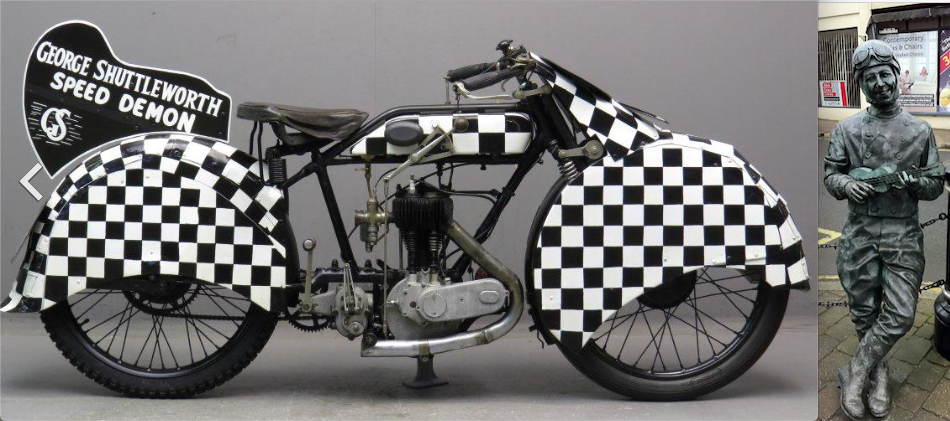
“NOEL POPE, A NOTED POET and novelist with a penchant for fast motor cycles, was entered for the Senior TT but when it was delayed by bad weather he left the island to keep an appointment at Brooklands. Pope had bought Ted Baragwanath’s supercharged 996cc JAP-engined Brough Superior outfit and set it up as a solo; he was after the Brooklands track record. And, as the Blue ‘Un reported: “After six years the Brooklands motor cycle lap record has been broken. A young racing man who only recently started riding very fast motor cycles has raised the speed to over two miles a minute—from 118.56mph, which was the record achieved by JS Wright on June 1st 1929, to 120.59mph. The feat is compensation for a disappointment. NB Pope, the man who now has the distinction of being the fastest Brooklands rider and the first to exceed 120mph for a lap, was to have competed in the Senior TT, but owing to the postponement he had to give up all thought of riding and return to the mainland. None but those who have an intimate knowledge of the track can realise what the achievement means. Brooklands is no billiards table. Even at touring speeds it is bumpy. Pope lapped in a series of breath-taking leaps. Thanks to the steering of his machine and his own grit this private owner set up a new Brooklands milestone.” He was awarded a BMCRC ‘Super Award’ for lapping at over 120mph. The same BMCRC meeting included s three-lap handicap: “Miss B Shilling on her self-tuned 490cc Norton ran through the field, and with one lap at 102.69mph provided a somewhat unexpected win. CR Bickell on the 499cc supercharged Ariel Four was second NB Pope (996cc Brough Superior), who covered his third lap at 116.38mph, third…The Brough Superior that EC Fernihough wheeled to the line for the second event, a two-lap handicap, looked very hush-hush in its sacking. Ferni was in his usual place at scratch and was giving 1min 32sec to the limit man, HR Nash (123cc New Imperial). Nash kept the lead until the end of the second lap, when he was passed by EC Garfield (996cc Brough Superior sc). Close behind Garfield was EG Bishop (496cc Exclesior sc) and the three crossed the line with only yards between them—really clever handicapping.”
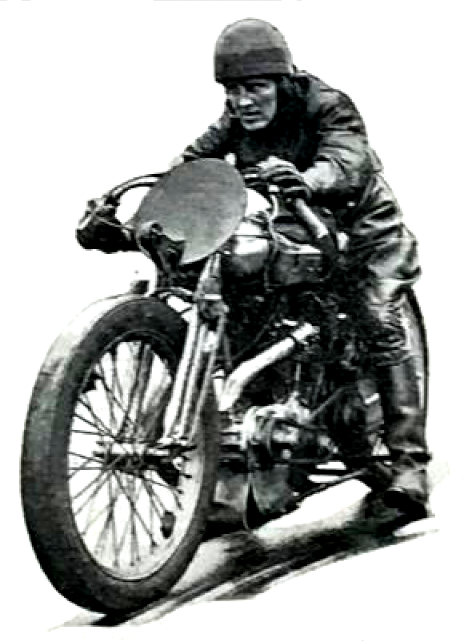
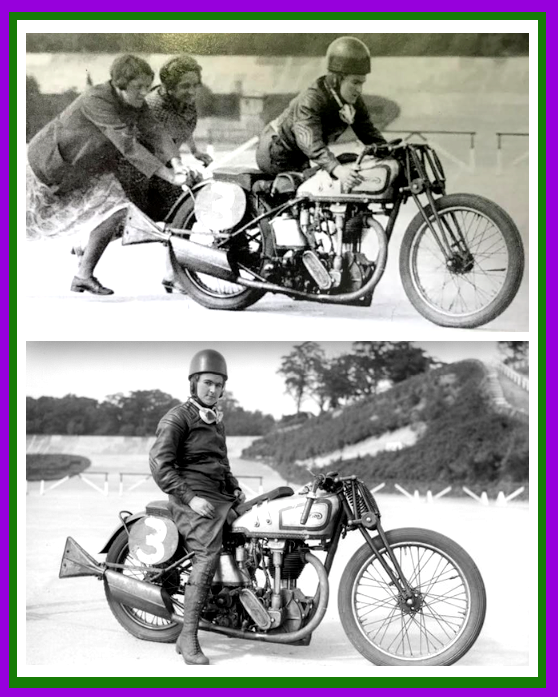
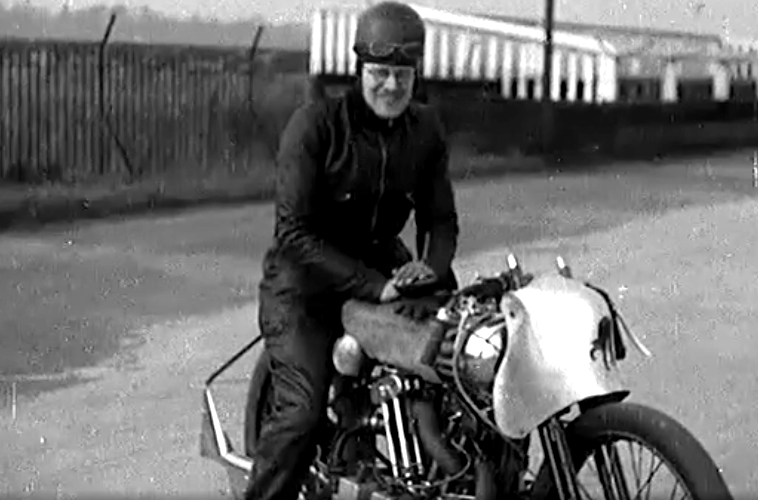
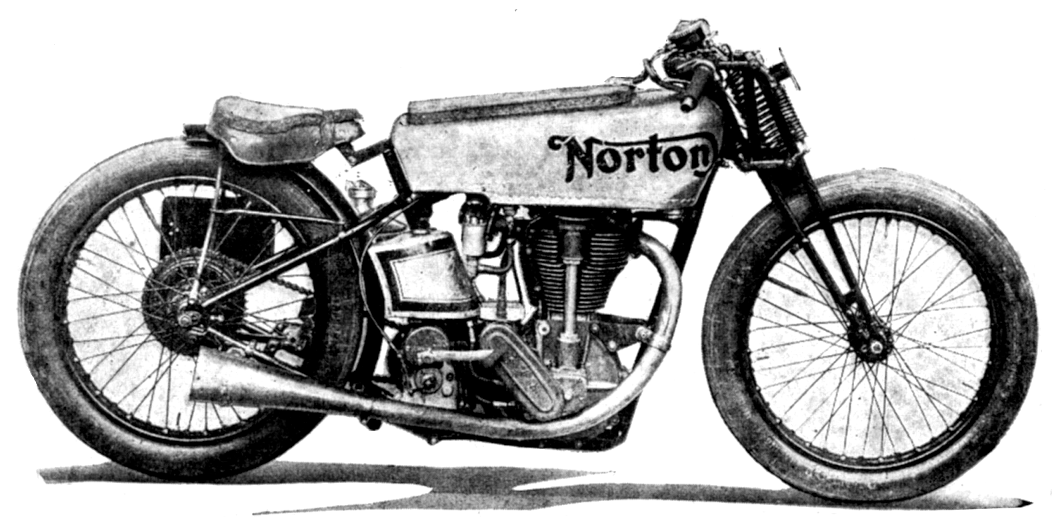
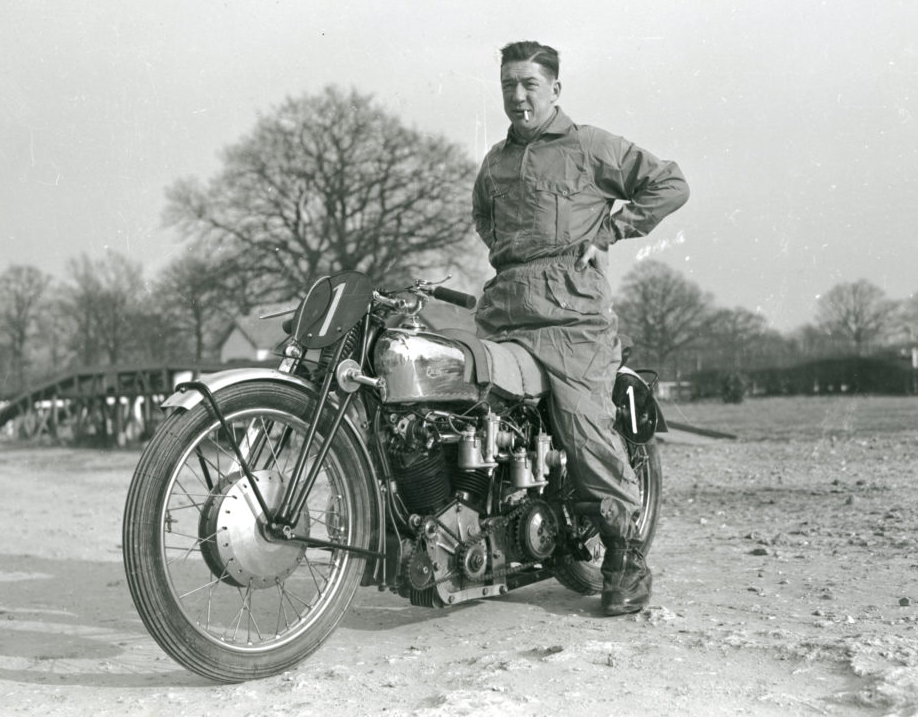
“A MACHINE WITH AN ENGINE of less than 100cc capacity is too small for serious motorcycling. This is the view held by many; indeed, it has been suggested more than once in these columns that such machines are only suitable for runabout work in flat districts. The 97.5cc DKW submitted to The Motor Cycle for test makes such opinions out of date. The writer would willingly set forth on this machine on a tour covering the length and breadth of Great Britain. And the tour would not be accomplished at a crawl, for the machine tested will keep up its 30 to 35mph with ease and thus maintain its position in any normal traffic stream. At first sight the DKW appears closely related to the continental velomoteur, chiefly because of its large wheels and small tyres. The minute engine is a two-stroke with a flat-topped piston is built in unit with a three-speed gearbox. Gears are employed for the primary drive, which is automatically lubricated by petroil from the engine, and since the magneto is incorporated with the flywheel, there is only one chain—the driving chain to the rear wheel. Lighting is of the direct type from coils in the flywheel, with a dry battery as a standby for parking purposes. Small internal expanding brakes (of 4in and 5½in diameter) are fitted in the front and rear wheels, which are shod with 26×2.25in tyres. The remaining features of the specification are a soft-topped saddle, a single-lever carburettor (without strangler), a special form of air cleaner on the carburettor air intake, pressed-steel, single compression spring type front forks and a central stand fitted with a spring which tends to flick the stand over dead-centre position when the machine is pulled backwards. Use of the stand is almost the easiest task imaginable since the machine in running trim was found to weigh only 119lb…Here is a machine with the performance of the popular type of small car plus the ability to climb hills at a reasonable speed. Britain has more than one engine of a similar size. At the moment they are lying more or less dormant. Perhaps the experiences we relate will arouse fresh interest in the small motor cycle…machines of this size, if they give satisfactory service, can form a valuable stepping-stone to larger and more expensive motor cycles.”
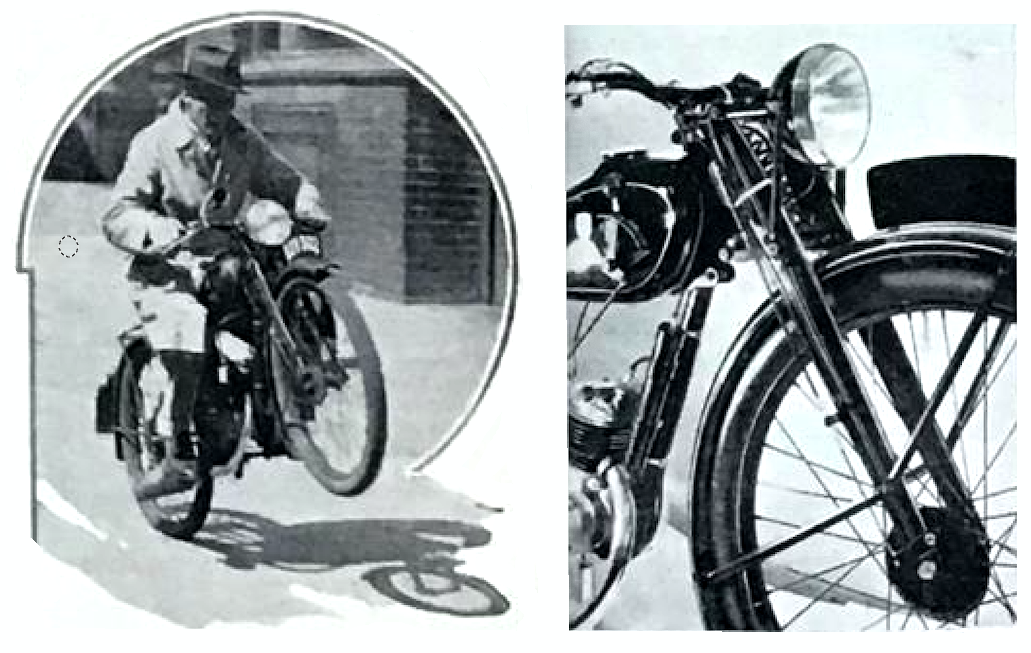
“WITH A DOZEN OR MORE 1936 programmes announced, it is interesting to pause for a moment to consider where the improvements lie. So far no startlingly novel machines have emerged from the secrecy of their chrysalids; instead there are whole ranges of standard-type mounts which display numerous new features, some of them of great utility. To the hard rider the features of, perhaps, greatest appeal are controlled battery charging and the widespread adoption of larger fuel tanks. It is probable that before long all new dynamo-equipped motor cycles will be fitted with this form of control which regulates the dynamo output according to the requirements of the battery. It will probably he the greatest boon since the standardisation of electrical equipment. For 1936 even small-capacity motor cycles will, in many cases, have tanks capable of holding three gallons of fuel. Often the cruising range on a tankful will be 250 or 300 miles. Ten years ago many a machine would only accommodate a gallon and a half, and the quantity that had to be purchased at each of the many stops for filling up was a single gallon! In addition, on machine after machine there are improvements in the riding position and modifications to ensure that routine adjustments, such as the valve clearances, can be made easily and quickly. A number of 1936 motor cycles incorporate some form of motif. Care, too, has been taken to ensure graceful lines. Particularly is this the case with the new and larger fuel tanks…the outstanding feature of the new models is the care and attention that have been lavished on them to make them more ‘rideable’—to make them ‘motor cycles for motor cyclists’.”
KING GEORGE V’S SILVER Jubilee led to countless press reviews of his 25-year reign. The Blue ’Un’s contribution was a review of the 1910 Olympia show, with a reassuring list of marques that had exhibited there and were still in business. They included: AJS (albeit under Matchless ownership), Ariel, BSA, Calthorpe, Douglas, Excelsior, FN, James, JAP, Matchless, Montgomery, New Hudson, Norton, OK, Panther, Royal Enfield, Rudge, Scott, Triumph and Zenith.
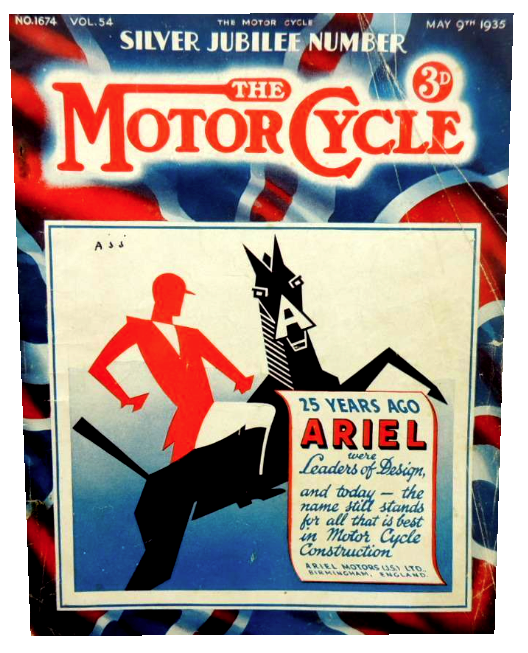
BSA MARKED THE Silver Jubilee with the launch of the Empire Star.
“MIGHT HAVE GONE WEST: A man was fined £2 at East Ham for smoking while driving a petrol-tanker lorry.”
PORTIA UP TO DATE: Summoned at Plymouth for disobeying a police signal, a woman motorist asserted that she hadn’t seen the signal, and, therefore, she couldn’t have disobeyed it! Fined an illogical 5s with 5s costs.”
“PARLIAMENT DISCUSSES ‘RIBBONS: In answer to a question in the House of Commons last week regarding ‘ribbon building’, the Prime Minister said that a Bill dealing with the matter ‘will be introduced as quickly as possible.'”
“HEN-PECKED?: A Parisian cyclist who sued the owner of a hen which swerved under his front wheel and upset him failed in his action. The Court maintained that the cyclist ‘tried to pass a hen that was keeping on the correct side.'”
“TRIUMPH OF DIGNITY: A Marylebone Police Court, during a pedestrian crossing case, a motorist made the novel plea that he was anxious not to imperil his new £1,000 car by a possible skid, so he hooted instead of stopping. Stranger still, the summons was dismissed!”
“BEACONSCIENCE: The Borough Treasurer of Kingston recently acknowledge the receipt of 5s.3d as ‘conscience money’ for the breakage of a Belisha beacon.” [Younger readers might care to flick back to 1934 to discover the source of their alliterative name; sub-editors will recognise the inclusion of a story as an excuse for a headline. All subs enjoy portmanteau words, and how often do you get the chance combine ‘beacon’ with ‘conscience’?—Ed.]
THERE WERE 48 MARQUES at the Milan show exhibiting 227 models; the major trend noted by tye B;ue ‘Uns correspondent was a move from 175s to 250s. There was no Paris Salon; the French industry concentrated on conventional 250s and 500s, as well as swarms of velomoteurs. In Germany the motor cycle industry, like the rest of the country, had fallen under strict government control, with various firms concentrating on specific classes—11 marques covered everything from two-stroke tiddlers to the big BMW and Zundapp flat twins.
ITALY AND GERMANY declared all motorcycles free of roadtax – and Italian motorcyclists wouldn’t even need driving licences.
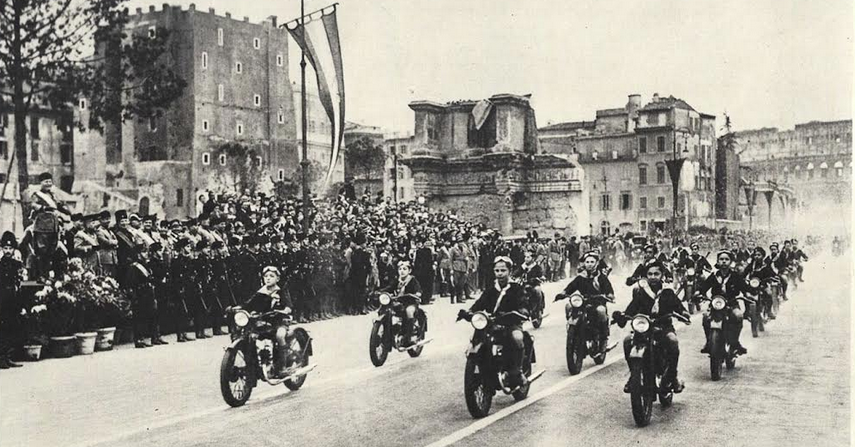
THE JAPANESE GOVERNMENT was alsotaking an interest on motor cycles. The Japanese Automobile Manufacturing Law excluded foreign companies and foreign capital. The government said: “The motor vehicle industry is of major importance both for industry and national defence. Entrusting this industry to the control of foreigners is unthinkable.” Tohatsu was nominated as the sole manufacturer of small petrol engines to the Japanese military and developed a range of rotary-valved two-strokes ranging from 48-248cc. Rukuo began production of Harleys under licence for supply to the Japanese military.

“THE HOPES OF THE DERBY Club officials, so far as the weather was concerned, were amply fulfilled on [August] Bank Holiday Monday. A brilliant sun was tempered by a light breeze, and conditions were ideal for racing. Donington Park looked lovely on this bright summer day, but, at first, there was a quietness about the place that seemed a little unusual. The crowd was only a thin one when the racing started, but hopes were held of a bigger muster as the day wore on. The finishing line is now graced with a beautiful Belisha beacon, but few pedestrians availed themselves of the crossing! A fine entry was received for the first event—a race for novices—and it was run off in two heats, each over five laps. The first heat was well contested, with HL Brooke (499cc Rudge) in the lead throughout, and he was never seriously challenged. However, there was a fine scrap all the way for second place, between SW Cooper (496cc Sunbeam) and WG Wright (348cc Velocette). Wright wrested the ‘lead’ from Cooper on the third lap, but Cooper was not to be denied, and passed his rival in a fine effort on the penultimate lap, and was not over-taken again. In the second heat, nobody could come near AJ Wellsted (493cc Excelsior). This rider established a wonderful lead on the first lap and was ‘miles’ ahead at the end of the race. The second man, WA Jordan (348cc Norton), occupied a gap in the ‘field’, being a long way behind Wellsted, but a long way in front of HS Green (497cc Ariel). Green, however, did not retain his position, for GA Chamberlain (348cc Norton) went ahead of him towards the end. As appeared obvious, Wellsted proved the winner of the race, with two heat-heat men, Brooke and Cooper qualifying for the places..Result, Novices’ Race: 1, AJ Wellsted
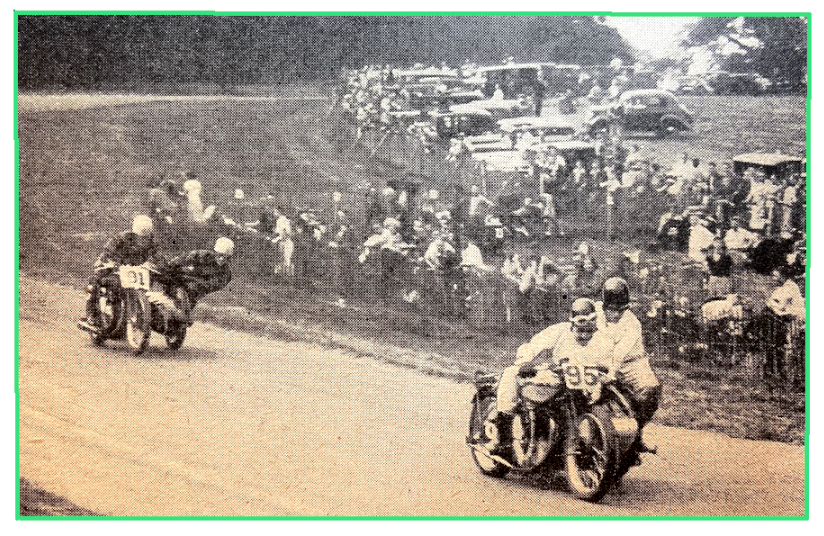
(493cc Excelsior) 63.93mph; 2, HL Brooke (499cc Rudge); 3, SW Cooper (495cc Sunbeam). Next on the programme was the ‘250’ race over ten laps, run in a single heat. Our old friend Paddy Johnston (246cc Cotton) celebrated his first visit to Donington by leading the race all the way, doing pretty well as liked with the rest, of the entry. His nearest rival was TA Hampton, on a camshaft OK Supreme, but Paddy had the legs of him and romped home an easy winner. There was very little of interest in this race, for after the fourth lap the order of the procession—even of the back markers—remained unaltered, SV Smith (247cc Excelsior) being a consistent third, a short distance behind Hampton. Result, 250 Race: 1, P Johnston (246cc Cotton) 59.12mph; 2, TA Hampton (246cc OK Supreme); 3, SP Smith (247cc Excelsior). There was another run-away win in the 350cc race, M Cann (348cc Norton) being quite invincible. Probably the story would have read differently had not HL Daniell (346cc AJS) had the misfortune to stop his engine at Starkey’s Corner when he was lying third on the third lap. At first CVM Booth (348cc Velocette) set the pace, but after the end of Lap 2 he was forced to play second fiddle to Cann. He did this throughout the race, riding very consistently. Daniell restarted a long way behind, but by dogged persistence he rode from 15th on the 4th lap to 5th at the finish—not a bad effort. WG Wright (348cc Velocette) came along well to finish in 3rd place after a scrap with N Croft (348cc Rudge), who was later forced to retire. Result, 350cc Race: 1, M Cann (348cc Norton) 65.20mph; 2, CVM Booth (348 Velocette); 3, WG Wright (348cc Velocette). There was more excitement in the 500cc solo race, in spite of the fact that Norman Croft (499cc Rudge) ran away with it. Indeed, it was this running away that provided the excitement, for, in riding as he did, Croft smashed a 10-lap record by a handsome margin, and at the same time won the Craner Bowl for the best time of the whole year. Heat 1 of the race was not very interesting, but a word must be said for WG Wright (348cc Velocette), who was riding splendidly with a long lead when he had the misfortune to fall and bend things. He carried on and finished third in his heat after a fine effort. Nobody in Heat 1 was fast enough to figure in the final placings, Croft (499cc Rudge), Cann and HL
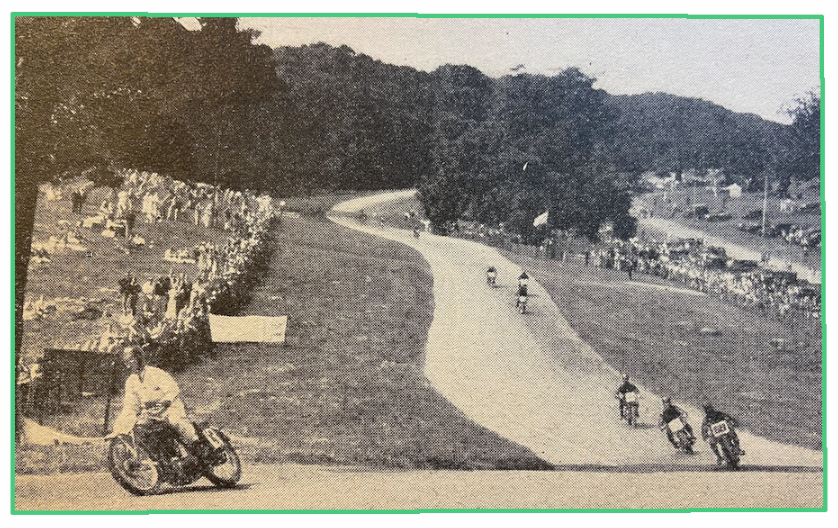
Daniell (490cc Nortons) setting too hot a pace for them. Daniell for once was outridden; he did not seem to be at home on a new machine and steadily dropped away from the two leaders. It would, in fact, have been a very good man indeed who could have held Croft in this event, and he deserves a full measure of praise. Result, 500cc Race: 1, N Croft (499cc Rudge), 67.1mph; 2, M Cann (490cc Norton); 3, HL Daniell (490cc Norton). The 600cc sidecar race was a grand one—a real fight from start to finish—with Kim Collett (490cc Norton s.) rather dominating affairs. He was not allowed to have it all his own way, however, for WH Rose (596cc Norton sc) was.chasing him madly, and actually pushed his nose in front and held it there for three laps. Collett, thinking this was hardly good enough, really put his skates on, slid ahead again, and refused to be caught thereafter. All this time Rose was being harried by LW Taylor (490cc Norton sc), and it was all he could do to keep in second place. The finish was marvellous. These three riders crossed the line in a bunch, and a good-sized blanket would have covered them all. Result, 600cc Sidecar Race: 1, Kim Collett (490cc Norton sc) 56.66mph; 2, WH Rose (596cc Norton sc); 3, LW Taylor (490cc Norton sc). On paper the unlimited sidecar and three-wheeler race looked good, for the interest included Collett and his big Brough, and Henry Laird on his supercharged Morgan. Laird started with a handicap of 100sec, and everyone was eager to see whether he could catch the rest of the field. He set off at a great pace with the flying Brough as his object. But success was denied him, for things happened to the engine and he was forced to pack up after a couple of laps. Meanwhile Collett was going wonderfully well and had attained a tremendous lead. On the fifth lap, however, Rose was almost on his tail, and it was obvious that something was wrong. Something was wrong. Collett did not appear again, and Rose and Taylor were left to fight it out. They were the only two finishers, and less than two seconds separated them at the end. Result: Unlimited Sidecar Race: 1, WH Rose (596cc Norton sc) 55.99mph; 2, LW Taylor (490cc Norton sc). Lastly came the unlimited solo race, and Daniell was obviously out to beat Croft this time. Croft, however, was in altogether too joyous a mood, and although Daniell got in front for a few seconds Croft romped ahead again, riding a great race. Cann battled along in great style, coming in third, and these three went quickly enough to deprive all others but one of a replica. Result, Unlimited Solo Race: 1, N Croft (499cc Rudge) 66.66mph; 2, HL Daniell (490cc Norton); 3, M Cann (490cc Norton); Replica, CVM Booth (348cc Velocette).
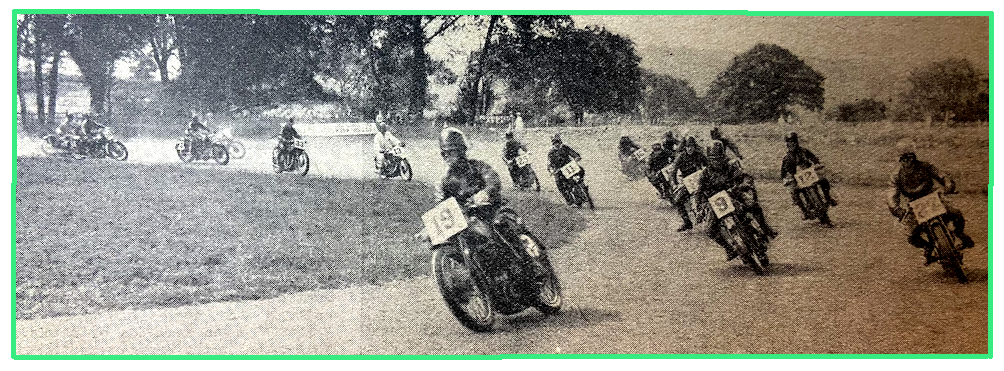
THE FOURTH BRIGHTON SPEED TRIALS were hosted by the Brighton & Hove Motor Club along a half-mile straight on Madeira Drive. Cars dominated the trials in numbers, if not performance, and Eric Fernihough dominated the motor cycle classes. He won the 250 and 350cc classes on Excelsior-JAPs; CB Bickell won the 600c class on a 499cc Ariel and Ferni’ rode 996cc Brough Superior-JAPs to win the unlimited solo and sidecar classes and, finally, the Special Class at 88.7mph—and that was the fastest run of the day. The fastest car run was 79.41mph by RO Shuttleworth in an Alpha Romeo; Forrest Lycett managed 66.18mph in an eight-litre Bentley and John Cobb’s mighty 23-litre Naipier-Railton could only manage 78.44mph. Motor Sport’s man at the seaside noted: “Fernihough’s speed of 88.7mph on a solo Brough-Superior motor-cycle will give further material for the bikes vs cars acceleration controversy, and only a Merc or an Auto-Union could have rivalled this performance.”
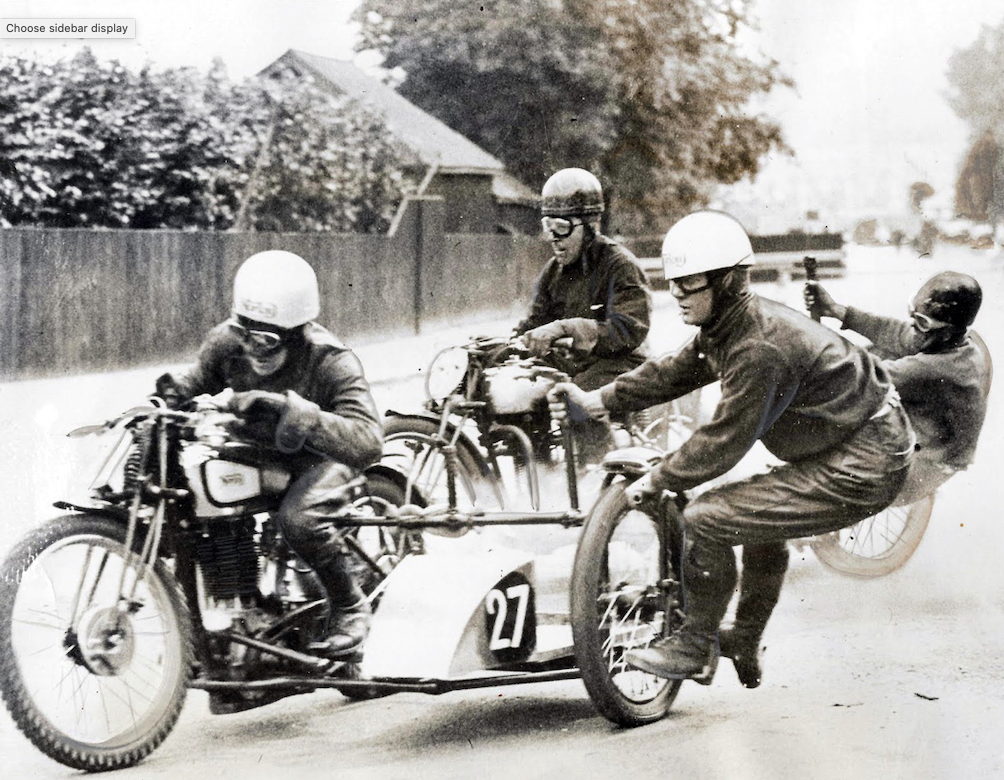
“TO HOLD AN OPEN TRIAL a long way from home requires courage and foresight, otherwise detail is apt to be faulty on the ground chosen. The Wood Green and District MC, in travelling all the way from the northern edge of London to hold its sixth annual Clayton Trophy Trial, was certainly not lacking in boldness in the conception, and, as everyone said who took part last week-end, the organisation lacked nothing in perfection. There is always a good chance, too, when a trial is run on ‘foreign’ ground, of making a gift of the main pots to some of those who know every gully and pitfall of the selected obstacles. This did not exactly happen in the case of the Clayton Trophy Trial, because Ken Wilson, the winner, probably was on quite strange ground. But he does knew the tactics necessary for rough and stony going. Ken Norris, the runner-up, rides regularly in this territory, and might have been tipped as a likely winner. Two of the class award winers, at any rate, have been trained on rocks and boulders. It was quite a short affair as open trials go. The route was only about 36 miles long, starting and finishing at Longnor, near Buxton, and never getting much more than about five miles away from that somewhat quiet village, but there were more than 20 observed sections, not to mention a ‘special test’ section, observed only to decide ties; this section had a dozen sub-sections, the shortest of which was only about three yards! Timekeeping did not enter into the affair at all. As a competitor you just kept going and only retired (a) if the model wilted, (b) if you ‘fell behind the general body of competitors’, and (c) having done so were overtaken by the rear marker marshal—who presumably was not expected to fall by the wayside himself! Some of the officials had ridden all
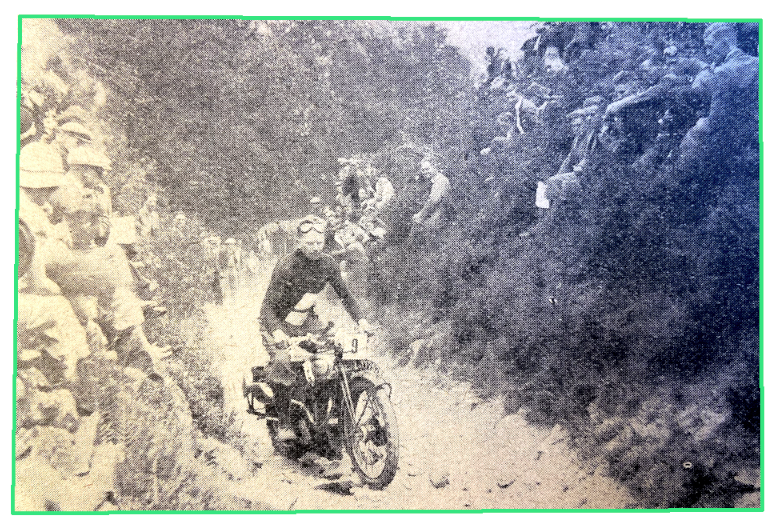
night to reach their jobs, and one of these, who was to do a large share of route marking, discovered a broken fork spindle on arrival at Longnor. Did the organisation fall down? Not likely! A tommy bar was pushed through the holes, the ends burred over and the job carried through according to plan. Of the 84 entries the North provided some 30 or so, the Midlands a handful, and all the rest were from the South, with, naturally, South Midland Centre riders predominating. Probably all except the Northern riders were more at home on mud and slime than on the bumpy, rocky stuff that the Longonor-Buxton area presented last Sunday. For the dry weather and brilliant sunshine had intensified the jaggedness of the outcrops and loose stones. But no one was daunted, and non-starters were very few. E Harris (347cc Matchless) came all the way from Middlesex and then could not start because of a seized fork spindle. F Drew (247cc Levis) was likewise delayed on his way from Warrington with a seized exhaust valve and arrived just too late. F Flintoff (493cc Sunbeam) had had some mishap the day before, so it was said, and so the Bradford Club started one short. Hollinsclough, near Longnor, was the first observed point, and probably the most difficult problem of the trial, and although then route had been kept ‘secret’ some hundreds of spectators were either in the know or had taken a chance, and out of over 70 ascents they saw only half a dozen make really clean climbs of the entire hill. AC Lane (490cc Norton) and G Leonard (490cc Norton) both got off the route when approaching Hollinsclough, and as they were turned back KB Norris (248cc Red Panther) started the ascent. ‘Ah!’ said the locals, ‘our man on his own ground will show how it can he done’—but he footed a little! Then NR Illingworth (248cc Royal Enfield), probably a perfect stranger to the hill, rode it as
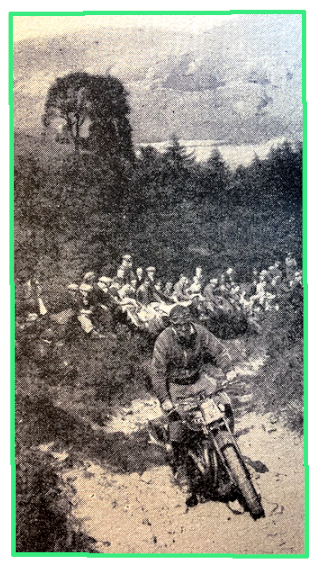
prettily as one could wish to see, standing on the rests, motor pulling steadily, and checking every rock-induced swerve before it got out of hand. Colin Edge (348cc Norton) was fast and used his feet, while JS Boote (348cc Panther) was also fast—too fast—and leaped from ridge to ridge with mighty crashings of this and that about the model. Then KD Haynes (347cc Matchless) from Wood Green dealt with the worst section in a fussless and very easy way; his machine steered just so, and was quiet about it, too. His fellow-clubman, TW Wright (348cc Norton), was also steady and did the entire hill without a touch. After that, for a long time, the efforts were monotonously unenterprising, too little gas and too much paddling being the order of things. And the locals were not noticeably better than those who had come from afar. Even S Smith, who performs such prodigies on his ‘plain tyre’ 1927 Rudge in Cheshire events, put out his plates, while Ken Wilson (348cc Panther)—Scott Trial winner—climbed a vertical bank and dropped back facing downhill. The real Midlands claimed the next no-penalty effort, the rider being LG. Holdsworth (496cc New Imperial), and he was shortly followed by WE Garrod (347cc Matchless) and R. Davis (343cc Triumph), all being sure and quite fast. Much more footing, bank climbing, sitting down suddenly and engine losing followed, until the last man of all, SE Breffitt (493cc Triumph), made as good a climb as any of the few who had lost no marks; how he pulled his front wheel up out of a most awful slide is known only to himself—if he realised at all what happened! By the time Breffitt was dealing with Hollinsclough the early numbers had completed the 36 miles and had checked in at Longnor again. They had dealt with Little Hollins, Washgate, Cheeks and various other less well-known spots. Even though some of the observed points were unspectacular, thereby disappointing the news-reel men, who could not understand a trial without water-splashes, marks were not earned, and they all counted at the finish. The maximum marks that could be got (marks were ‘earned’, not ‘lost’ in this event) was 170, and four people tied with this figure; they were KB Norris (248cc Red Panther), K Wilson (348cc Panther), R Davis (343cc Triumph) and SE Breffitt (493cc Triumph), and they had to be separated by reference to the special observed section. Results: Clayton Trophy (best performance), K Wilson (348cc Panther); Le Vack Cup (runner-up), KB Norris (248cc Red Panther); Easterbrook Cup (best Wood Green MC member), KD Haynes (347cc Matchless); 250cc Cup, TA Kitching (249cc Triumph); 350cc Cup, R Davis (343cc Triumph); Unlimited cc Cup, SE Breffitt (495cc Triumph); Tankard (best novice), H Cartwright (348cc BSA); Tankard (best Wood Green MC novice), PG Handford (348cc BSA); Tankard (best performance on pre-1930 machine), S Smith (1927 499cc Rudge); Club Team Prize, Wood Green ‘A’, KB Norris (248cc Red Panther), KD Haynes (347cc Matchless), EW White (348cc Norton); One-make Team Prize, Wood Green Norton, FV Chambers (348cc), EW White (348cc), LR Surtees (348cc). First-class Awards went to the top 30% of starters other than trophy winners.”
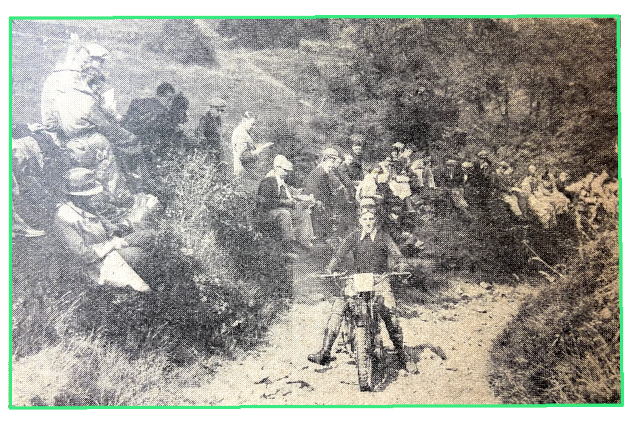
THE MANX GRAND PRIX Junior and Lightweight classes were run together with 30 350s and 24 250s on the grid. Nortons and Velos formed the bulk of the Junior entry, with a Rudge and a brace of Ajays. R Harris (New Imperial) won the Lightweight class at 68.58mph; HM Rowell (Rudge) was runner-up, despite running out of fuel and pushing in from Governor’s Bridge. CAW Darno (Cotton) came third. As expected, Nortons dominated the Junior race. Freddie Frith won at 76.02mph; he was followed home by B Darbishire, JK Swanston and JH Blyth, all on Nortons; WA Rowell was 5th on a Velo with T McEwan sixth on yet another Norton. Nortons also dominated the Senior MGP. Frith was on course to score a Junior-Senior double until the final lap when J. K. Swanston scorched round at a record breaking 81.84mph to finish 1min 17sec ahead of Frith, who had ridden the second half of the race with a broken clutch lever. Third place went to SB Darbishire, ahead of A Munks, R Harris and TH Blyth. They were all riding Nortons, and Blyth’s was a 350.
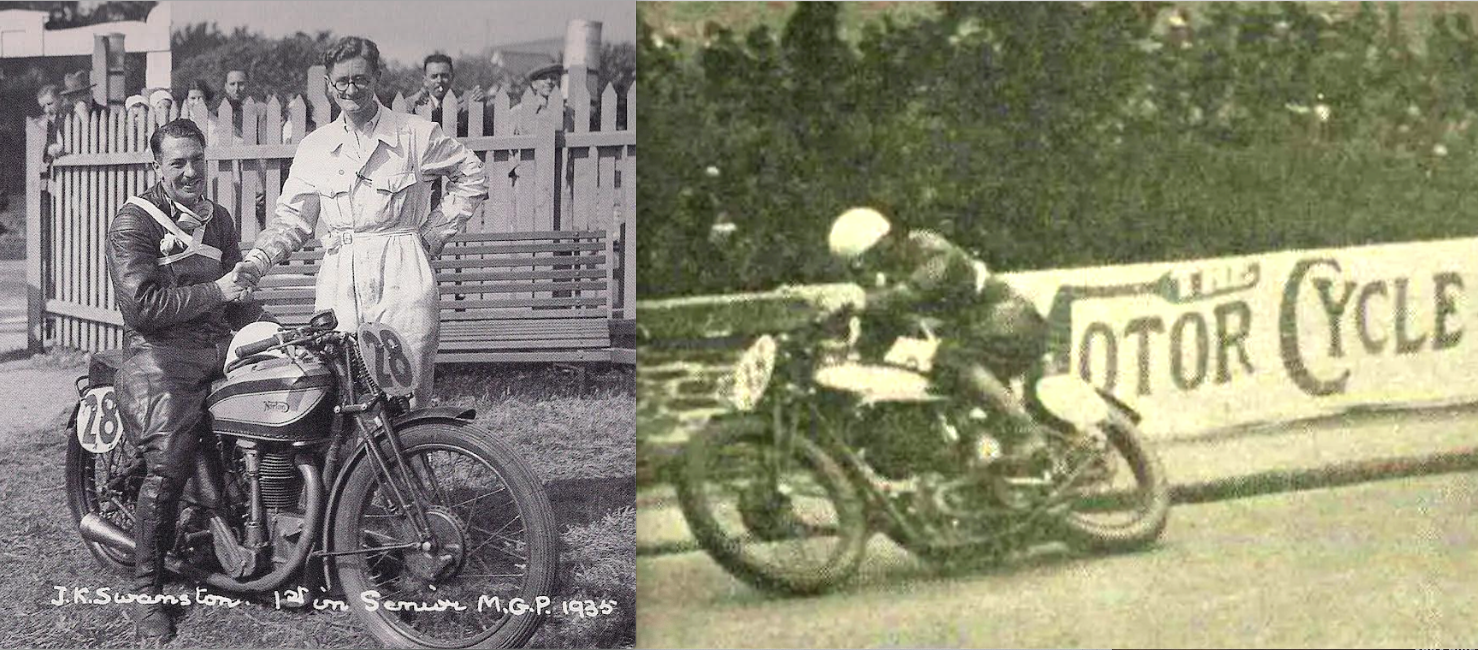
COLONEL TE LAWRENCE (of Arabia) died after swerving his Brough Superior SS100 to avoid an errand boy’s bicycle. Another motor cycle accident took the life of Norton designer Arthur Carrol.
WITH THE ROADTAX SYSTEM weighted in favour of 250s they now accounted for a third of all motorcycle registrations. The tough economic climate also led many manufacturers to drop high priced large-capacity models. Coventry-Eagle, for example, whose 988cc JAP-powered Flying 8 had challenged the BruffSup SS100, now majored on an advanced 250, the Silent Pullman Two-Seater. Available as a (Villiers) twostroke or (Blackburne) fourstroke, the Pullman featured full enclosure with a a leafsprung monocoque frame.
RUDGE CAME UP WITH a trials/scrambles version of its four-valve Ulster based on the bike Bob McGregor rode to victory in the Scottish Six Days Trial.
WITH MORE THAN 500,000 vehicles laid up for the fourth quarter the Blue ’Un called for roadtax to be replaced by increased fuel taxes.
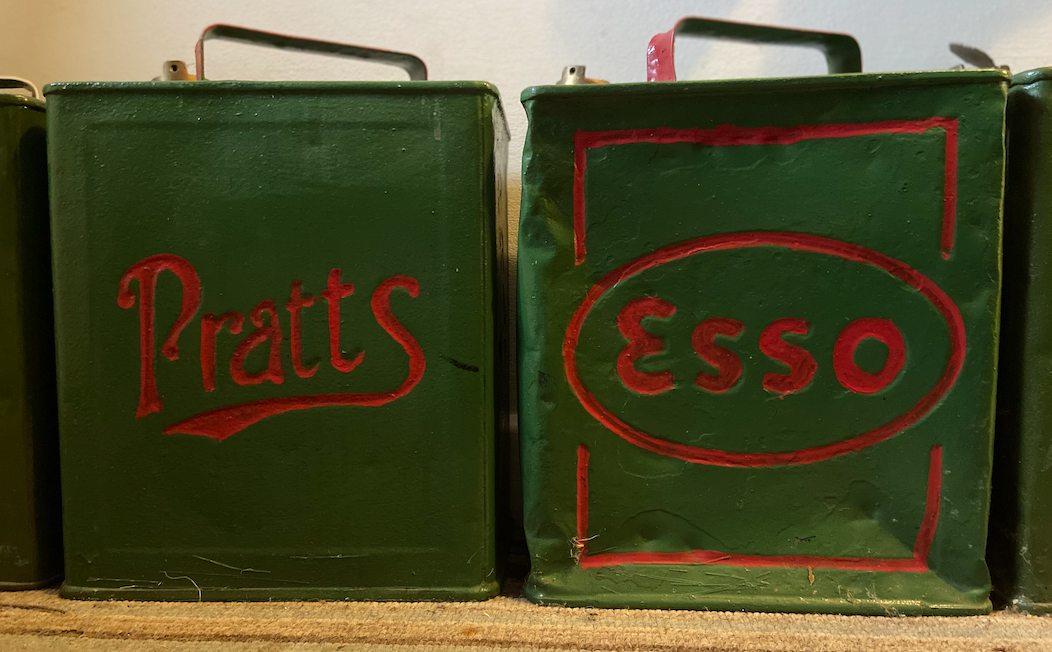
AFTER YEARS WITH NO national speed limit a 30mph urban limit came into force, as did a riding/driving test for all new applicants, initially on a voluntary basis to avoid a logjam when it became compulsory, and anyone who had held a licence before April 1934 was allowed to keep it under ‘grandfathers’ rights The first person to pass the new test was a Mr Beene.’. Provisional licence holders were required to display red L-plates.
BSA DIRECTOR JAMES LEEK returned from the Leipzig Fair with dire tales of Nazi militarisation—the famous German engineering show was packed with military hardware; SS troops were goose-stepping in all directions. BSA responded to his report by getting back to its Small Arms roots. Gunmaking machinery mothballed since 1918 was cleaned up and large sections of the mighty Small Heath works was soon working overtime churning out rifles and machine guns. The 498cc V-twin produced for the Army was put on the open market.
WAR DEPARTMENT thinking had swung back from twins to singles and a seven-marque shootout was arranged, involving Ariel, BSA, Matchless,New Imperial, Norton, Royal Enfield and Triumph. Orders were placed for the Norton 16H and Matchless G3, then BSA replaced its unsuccessful W35/6 with the M20.
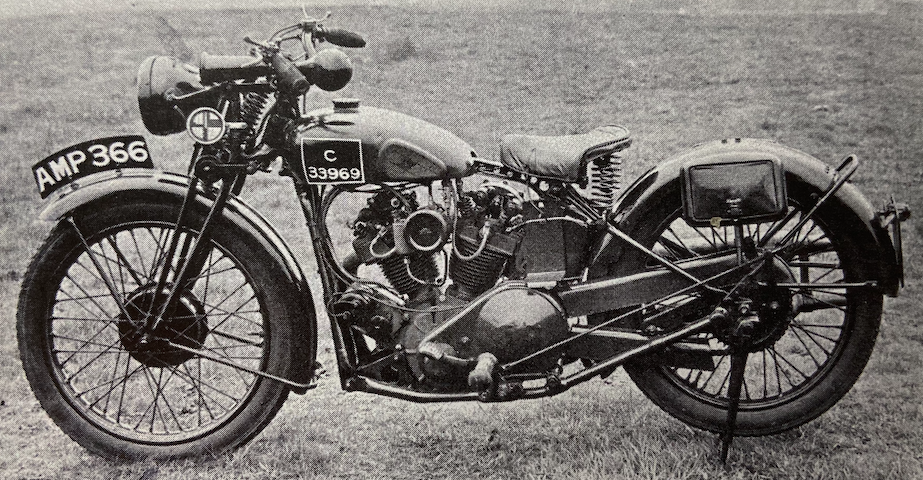
VINCENT-HRD’S NEW high-cam 500, designed by Phil Irving, was offered in three versions: the 80mph Meteor, 90mph Comet and 100mph TT Model. When a factory tester on a tuned Comet was summoned for doing over 110mph the magistrate didn’t believe a bike could go that fast and dismissed the charge.
THE MOTOR CYCLE’S MAN at the German Grand Prix, staged “…in the midst of golden cornfields high up in the plains of Saxony” reported: “All night long the streets have been packed with cars, motor cycles and walkers who have come from all parts of Germany…It is a really cheerful crowd, in keeping with the flag-bedecked streets. Everywhere there are Nazi swastikas—everyone seeks to be somebody and very important. Hands are constantly being raised in cheery ‘Heil Hitler’ greetings—one no longer says ‘Good Morning’ in Germany. Enthusiasm is almost as fever pitch, for your Saxon is one of Europe’s keenest motor cyclists—even the willing Nazi Storm Troopers, who sit down in front of the vast crowd, can hardly refrain from standing up as the riders take up their positions on the grid…” The German DKWs and NSUs were certainly formidable machines—the DKW was a 500cc double-split-single two-stroke twin with an extra supercharging cylinder, giving a total of five pistons. Germany had an exotic bike and all the resources of the Nazi state;. Jimmy Guthrie had a Norton one-lunger and British pluck. Of course the Norton won, followed home by a Husqvarna ridden by Ragnar Sunqvist, now comfortably sans appendix. The highest placed German bike was Karl Gall’s blown Beemer. Then Walther Rusk rubbed their faces in it by winning the the 350 race on another Norton single. Tyrell Smith rode his Rudge to third place in the 250 race.
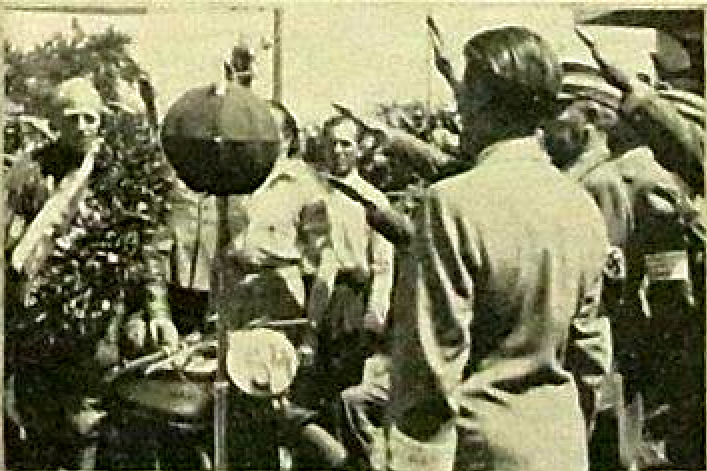
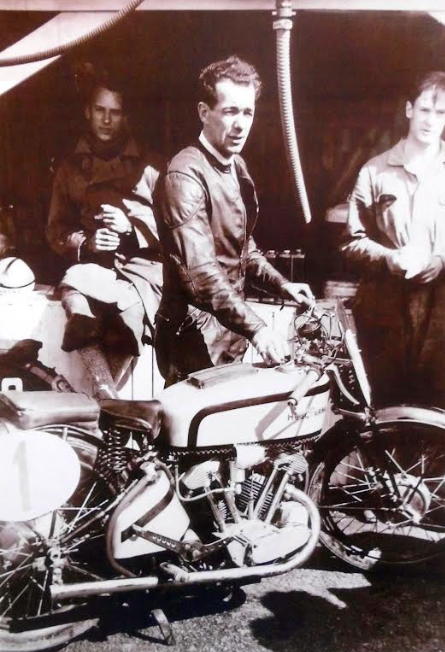
STANLEY WOODS RODE a Husqvarna to victory in the Swedish GP.
THE ULSTER GRAND PRIX, generally known as the world’s fastest roadrace, was the 1935 Grand Prix of Europe—the first time the courtesy title had been applied to a British race. The title rotated between the major races; the winners of the various classes were declared European Champions. In the Senior Guthrie and Rusk on their Nortons were up against Woods on the TT winning Guzzi. In the Junior Nortons ridden by ‘Crasher’ White and Johnny Duncan took on Velos ridden by Wal Handley and Ernie Thomas. The Lightweight set British Rudges and New Imps against Continental DKWs and Guzzis. The 250s, 350s and 500s all ran together—the racing was fast and furious. Guthrie and Rusk both recorded standing-start laps over 93mph which annihilated all previous records. But on the second lap the two Norton stars collided, putting Rusk out of the race. Guthrie straightened a twisted mudguard and was back in the running with damaged footrests, gear change, handlebar and front wheel rim. The crash had put him back in fourth place but he tore through the field to regain the lead with a 95.33mph lap and finished three-and-a-half minutes ahead of Belgian René Milhoux on an FN. Woods’ Guzzi had engine trouble from the start. The Norton vs Velo Junior fracas was a clear win for Hall Green over Bracebridge Street: the finishing order was Handley, Thomas, White and local Velo rider Jackie Chambers. Germany’s Arthur Geiss won the 250cc class on his DKW, ahead of Bob Foster (New Imperial) and Gordon. Burney (Moto Guzzi). Jim Guthrie’s 90.98mph race average set a world record.
“THERE IS SOMETHING indefinably fascinating about riding a machine which is out of the ordinary. Particularly is this the case if it emanates from a foreign country. We in England are rather liable to have very fixed ideas as to what goes to make a motorcycle and what does not, and therefore, when I was told to take over one of Germany’s leading motorcycles for a few days, I was more than excited at the prospect of broadening my views. The machine in question was the 740cc Model R12 BMW, a product of that famous stable, the Bavarian Motor Works of Munich. British readers are familiar with the name of this German marque. Not only has it wrested from us the International Trophy in the International Six Days Trial for two years in succession, but it also holds the world’s maximum speed record for motor cycles. From this it will be gathered that, although unorthodox to our eyes, the BMW is a well-proven design with a definitely outstanding performance. Briefly, the R12 is a touring model, a side-valve. It has the BMW flat-twin engine arranged transversely in a pressed-steel frame. The engine, clutch, and gearbox are in one unit, and the final drive is by shaft to the rear wheel. The complete engine unit is undeniably a masterpiece of design and pleasing to look upon. The R12 is fitted with two Amal pump-type carburetters, and has cast-aluminium cylinder heads and fully enclosed valve gear. A point worthy of notice is that the finning around both the inlet and exhaust port is separate from that of the cylinder barrels. A large petrol filter combined with a two-way tap is part of the equipment. No air lever is fitted to the carburetters, yet starting, once the knack has been acquired, was easy, in spite of the fact that the kick-starter works outwards on the near side. Towards the end of the test I found myself able to start the BMW without having to rise from the saddle. When once warm, the engine had the most glorious tick-over that I have heard for a long time; its extreme silence in evoked interest wherever I happened to be. The engine was particularly sensitive to the adjustment of the carburettors. This was most noticeable if one float chamber had been flooded without the other for starting purposes. One cylinder will begin to fire unevenly, with a result that the whole engine unit would tend to swing the frame from side to side. The misfire would
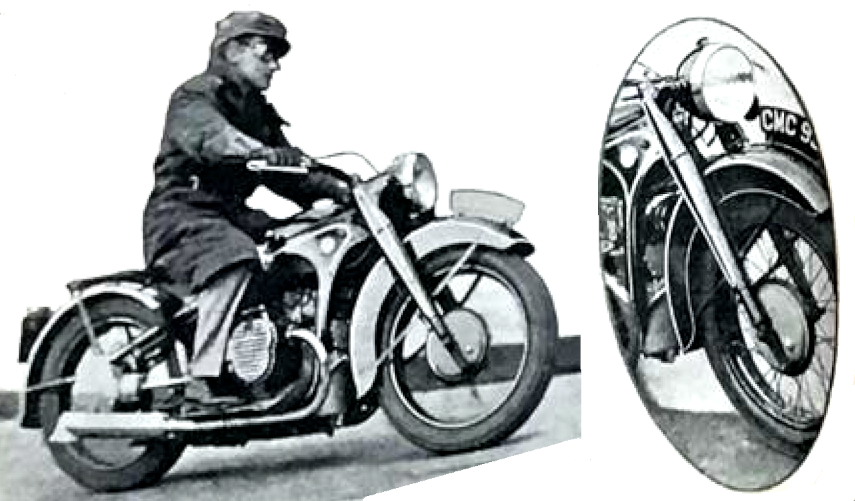
disappear within two or three seconds, after which no noticeable vibration could be felt. In fact, the engine appears to be perfectly balanced and vibrationless throughout its range. I found myself completely at home within a few yards of taking over the machine. The riding position just fitted me, though I doubt if a taller man would find the leg position quite so comfortable on account of the proximity of the air cleaner of the offside carburettor to one’s right shinbone. Possibly the fitting of footrests in place of the footboards would obviate this minor point. Incidentally, the foot boards are cast in some extremely tough aluminium alloy, which would withstand the machine toppling over on its side without damage. The gear change is simple, and similar to that of a car. It has an H-type gate combined with the rubber knee grip mounted on the side of the frame. While it was always possible to engage the gears without using the throttle, a completely silent gear change called for a blending of the engine revolutions with those of the gears. The clutch was delightfully lights and smooth in action, although on withdrawal it produced a curious metallic ring. Of the steering, I find it hard to avoid writing too much. The latest type of BMW forks are fitted. They are telescopic in action and automatically damped hydraulically. Apart from appearance—no thin tubing, no external springs, no grease nipples, and no visible working parts—the forks are also perfect in action. When moving slowly in traffic the low centre of gravity of the machine and possibly the wide handlebars help me maintain perfect control.”

“ALTHOUGH THE STEVENS motorcycle is of comparatively recent origin, the men behind the scenes have on more than one occasion been responsible for TT winning machines. Therefore, in spite of being a newcomer, the latest addition to the Stevens range—the model LL1—is not in any sense of the phrase “an experiment”. Simple, clean-cut lines typify the new model. A sturdy, single-port, ohv 349cc engine is housed in a strong cradle frame. Mounted on the front down tube in front of the crankcase is a large-capacity oil tank. This somewhat unusual position leaves ample room under the saddle for the accommodation of the accumulator. Unfortunately, the model tested suffered from a tight fitting contact breaker cam ring which left the ignition set permanently in advance. In consequence, starting was somewhat uncertain. If the carburettor was merely tickled and not flooded, and a good swinging kick applied to the kickstarter the engine would fire immediately four times out of five. If it failed to do so the best remedy was to push the machine in second gear when it would always start with certainty. In spite of the advance ignition timing, the slow running of the Stevens was good. Silence is also a feature of the machine. In a traffic stop it could be left idling in gear with the clutch withdrawn, and only with difficulty could the engine exhaust be heard. Response to the throttle was immediate, while throughout the range of the engine vibration was negligible. One noticeable peculiarity was that at engine revolutions corresponding to 48mph in top gear the front fork spring would vibrate, its centre moving as much is an inch in all directions. This period would disappear the moment the engine revolutions were either increased or decreased. A combination of a relatively high saddle mounting and low handlebars imparted a feeling of the greatest confidence, no doubt due to the excellent control over the front wheel which the rider had at all times,. The steering is of the Stevens is exceptionally good. It could be ridden at 40mph over an atrociously bumpy road, with the hands clear of the handlebars.
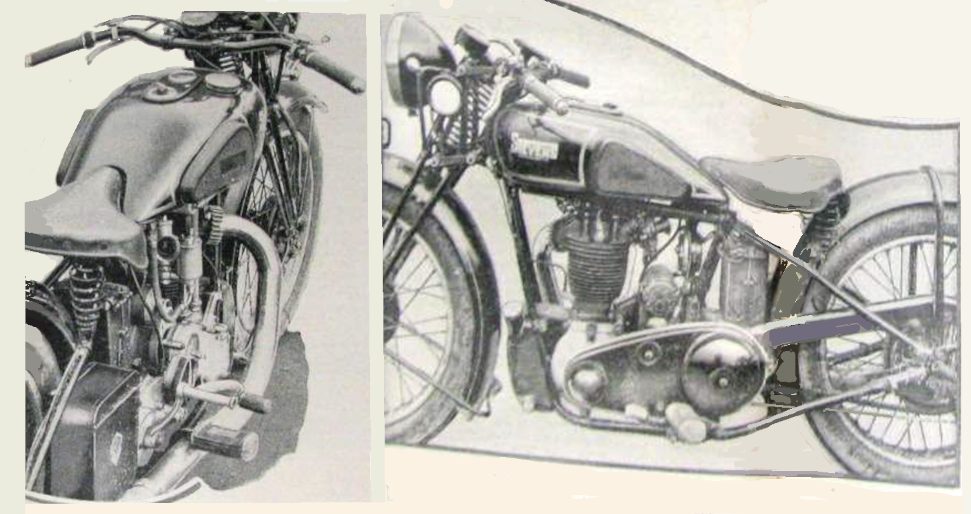
A steering damper is fitted, but at no time during the test was it necessary to use it, for not even the suggestion of a wobble appeared. Cornering was exactly the same as that of a TT thoroughbred. The machine could be heeled over until the foot rest gave warning that the limit was reached. If, in the course of rounding a fast bend, the front wheel struck a bump, it would always come down without deviation. On grease the same excellent steering was in evidence. Combined with first-class road-holding and nigh on perfect breaks, riding on the greasy roads of London was almost child’s play. The breaking is one of the outstanding features of the Stevens. Both back and front brakes are very powerful in action, yet possess that desirable ‘sponginess’ in application. The rear brake, incidentally, is connected with an efficient stop-light. The makers of the Stevens do not claim it to be an out-and-out sports model. Rather it is an extremely well-built and well-finished motor cycle. It is only to be expected that the speeds obtained in the different gears were not exceptionally high. Even so, they were above the average. Under slightly favourable conditions, against which must be discounted the newness of the engine, a maximum speed of 67mph was attained in top gear (5.5 to 1). In third gear (7 to 1) 55mph was reached, while valves started floating at 46 and 25mph in second (9 to 1) and bottom (15 to 1) gears respectively. The minimum non-snatch snatch speed in top gear with the ignition fully advanced was approximately 12, and when accelerated from 20mph to 45mph in the same gear the Steve took just under 12sec. In third gear the time was taken was 8sec, while the 7sec in second gear does not give any true representation of the acceleration, as it 45mph the engine had ‘peaked’. The operation of the gears was easy in the extreme, though if a silent change down was desired a little care in matching the engine revolutions was necessary. Apart from a slight whine in third gear the gearbox was reasonably quiet. Mention should be made of the clutch, which was both light and smooth an action. Although the clutch is completely enclosed in the primary oil bath chain case there were no signs of drag. At a maintained speed of 35mph the petrol consumption was 78.4mpg. It was noticed that if the Steve were driven hard—it could cruise at 55mph—this consumption figure hardly varied. Some idea of the power developed by the engine may be gained by the manner in which Pebblecombe Hill, near Dorking, with its gradient of 1 in 6, was climbed. Taken at 40mph at the bottom, the hill was surmounted in top gear, though the speed dropped to 25mph. As the oil pump is adjustable, and the engine was new, a general setting was given, so that no true idea of the oil consultant was gained. It should be pointed out that a wet-ump lubrication system is employed. Throughout the test the engine remained remarkably free from oil leaks, while the rocker gear called for no adjustment. Finally, in keeping with the rest of this excellent little machine, the mudguarding was exceptionally good.”
“SINCE LAST YEAR THE Red Panther has been considerably improved. In the 248cc model the valve gear is now completely enclosed in a massive valve chest cast integral with a detachable cylinder head. Attention has also been paid to the brakes; the rear brake pedal is mounted forward on the offside. The wide range of adjustment possible on the footrests allows them to be set to give the maximum degree of comfort. As the brake pedal is fitted with a stop it is possible to arrange the height of the pedal to suit the foot rests. However, if the pedal is set too low, there is a risk of it found in the exhaust pipe. At all times, the engine started with a minimum of effort. From cold, a certain start could be guaranteed provided the carburettor was flooded. On one occasion the coil ignition switch was inadvertently left in the ‘on’ position for over eight hours; in consequence of the accumulator was completely run down. However, the engine started fairly easily on being pushed hard in second gear, the dynamo cutting-in a fast running pace. Idling was excellent, and so was the mechanical silence. The exhaust note was unobtrusive, though at speeds over 40mph on top gear. it’s ‘tang’ became slightly more conspicuous. The brakes were all that they should be, the front one being particularly smooth and light in operation. The rear brake, however, was a trifle too light, and caution was called for in its application if a locked rear wheel was to be avoided. At first, the selection of second gear was a trifle uncertain, but after the gear rod of the hand change had been adjusted, this minor point was rectified. The clutch was perfectly light and smooth in operation. The gearbox was silent in all gears and exceedingly easy to operate. To a connoisseur the selection of the ratios would appear to be a trifle on the wild side, this being particularly noticeable between second and top gears when changing up – one second, the engine was revving hard and the next it was seemingly just able to make
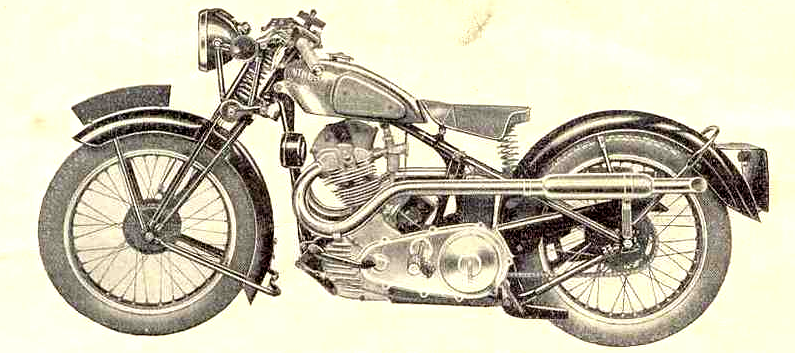
headway. After 200 miles the maximum speeds in second (9.5 to 1) and bottom (13.5 to 1) gears were approximately 43mph and 24mph. At the end of the test the maximum speed in top gear (5.0 to 1) was 60mph. In both the indirect ratios valve float appeared to be the limiting factor. Acceleration from 20mph to 45mph in top gear was particularly good for a 250cc machine, the time taken being 11sec. A comfortable cruising speed was 50mph, and although the Panther would rapidly accelerate to 55mph, it took an appreciable time to reach 60mph. At the other end of the speed range the machine could be throttled down to a quick walking pace in top gear without retarding the ignition. Fuel consumption at a maintained speed of 35mph amounted to 105mpg. On the other hand, the oil consumption was not outstanding, amounting to a bare 900mpg. This might be accounted for by the severe nature of the test—the Panther was driven hard throughout—and the generous setting of the adjustable oil pump. A slight criticism can be levelled at the dipstick into the oil sump. Although this is marked, there is nothing to indicate the correct ‘full’ or ‘half-empty’ levels. Incidentally, the crank case was not so oil tight, as with previous models, while a too liberal supply of oil appeared to reach the primary chain, whence it was flung over the nearside of the machine. On the road, the Panther handled admirably. The steering was excellent, even at high speeds, although no steering damper is fitted. The shock absorbers are rather inaccessibly mounted and difficult to adjust by hand. Cornering was good, and the Panther’s general handling over grease and rough roads was all that could be desired. A small but disconcerting point was that when travelling over rough surfaces and the rider was bumped off the saddle, the peak of the saddle would pin, the underside of the rider’s coat to the tank in such a manner as a cause distraction; at the same time the riders coat was liable to be damaged. Throughout the test the dynamo balanced the discharge of the coil at speeds above 20mph in top gear. At night the brilliance of the headlamp beam made riding a pleasure; its intensity was exceptional, yet, at the same time sufficiently diffused to provide ample illumination of the roadside—an unexpected luxury on such a low price machine.”
“WHEN OUT ON MY MACHINE at week-ends I am struck by the fact that the majority of motor cyclists are not so smart as they used to be a few years ago. Motor cycling kit is cheaper and more varied than ever before, and yet many riders are still badly turned out. To my mind, for smartness and utility there is nothing to equal breeches and high boots. Waterproof clothing and rubber boots should fit well and not give the impression of being merely hastily donned overalls. The motor cyclist who wants to look at his best should wear kit of a ‘semi-military’ style.
BW Newman, London, WC1.”
THE ISDT WAS BACK in Germany; there were 267 entrants. The German contingent fielded 33 DKWs—having won its spurs on Continental race tracks the potent 500 two-stroke twin proved readily adaptable to cross-country competition—and 23 BMWs, with 20 apiece from Zundapp and NSU. British hopefuls arrived on 16 Ariels, 10 Beezas, eight Triumphs and eight Velos. Germany’s Trophy team, including world speed record holder Ernst Henne, was mounted on supercharged 500cc BMWs with telescopic forks; DKW’s factory roadracing team rode 250s as the Vase team. There were five teams competing for the International Trophy and 16 for the International Silver Vase—and once again it was Germany’s year. The Courier Mail of Brisbane set the scene (strange to recount, international motor cycle sport was still considered internationally newsworthy): “Details of the International Six Days’ Reliability Trial, to be held in Germany from Monday next to Saturday, September 14, should prove of interest to Queensland motor cyclists. No fewer than 1,600 miles will have to be covered by the competitors. Such a mileage gives some inkling as to the strenuous nature of the event. When it is remembered that the last day is more in the nature of a ‘half day’, since it includes the final speed test, it is realised that the trial is likely to prove even more arduous than ‘1,000 miles in six days’ would make it seem. During
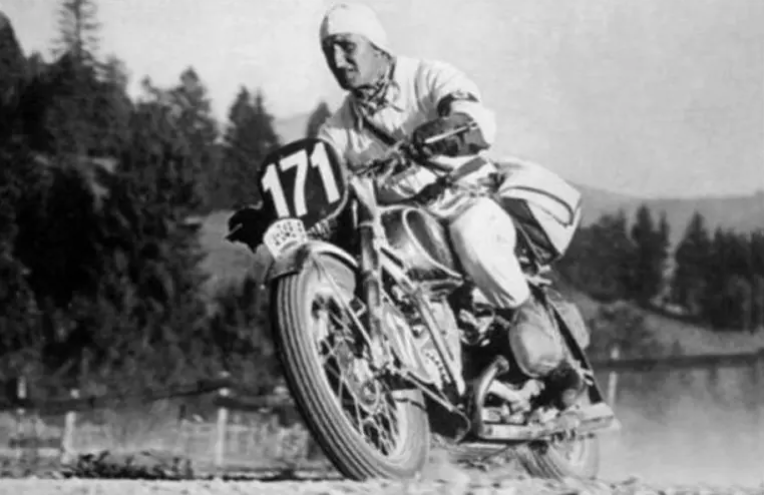
each daily run there will be special tests held on good main roads closed to other traffic. On three of the six days these special tests will be speed tests over a distance of not less than six miles and not more than 18 miles of level roads. The minimum speeds are: 175cc solos, 44mph; 250cc, 46mph; 350cc, 48½mph; 500cc, 49¾ mph; 750cc, 50½mph; 1000cc, 50½mph; and for 600cc and 1000cc side-cars and 1000cc three-wheelers, 43½mph.” By way of contrast, some excerpts of the report in Motorwelt, published by the German ACU equivalent, the DDAC. Laid-back, it ain’t: “Once again, German riders and motorbikes triumphed in the toughest test known to motorcycling in all countries. The 17th International Six-Day Race was a German victory for the third time! Our national team of Henne, Stelzer and Kraus with co-driver Josef Müller won the international trophy on the new BMW compressor machines. The DKW team Geiss, Winkler and Kluge won the International Silver Vase with 0 points and thus also one of the three FJCM Grand Gold Medals. In addition, the prize of the Führer des Deutschen Kraftfahrsportes for the best of all club teams also went to Germany, namely to the DDAC, won by the team Steinberger, Seltsam and Schäffer on BMW. Our teams and machines have not yet been able to provide more impressive and convincing proof of German superiority…On the descent on the old Oberjoch road, it was clear to see that many bikes were already experiencing braking difficulties. Such a steep descent in scree-covered bends requires soft and evenly applied brakes, as the slightest blockage inevitably leads to a crash. What’s more, we had already travelled 440km, the effect of which had probably impaired our sensitivity to brake control. In any case, this day also claimed its victims. A total of 26 participants dropped out, bringing the total number of cancellations to 59. Once again, various sidecar combinations were among them, for which the endurance test seems to be particularly severe.
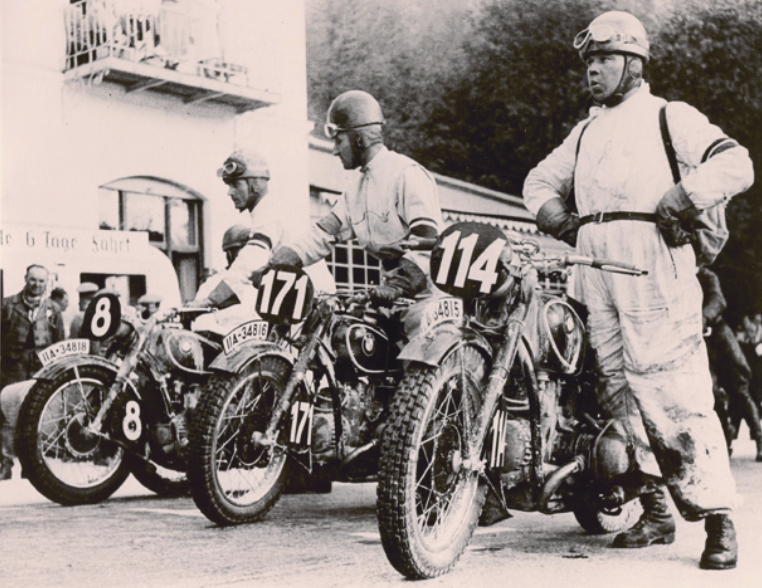
You can already see many patches on the chassis of these machines, not many of which are likely to see the end…It was with trepidation that we awaited the start of our national team on Thursday in Titisee, where the second half of the big western loop back to Oberstdorf began at dawn. But Kraus and Müller will compete [following a severe crash]. With the help of special bandages and medical tricks, it was possible to get Kraus back in the saddle and Müller in the sidecar. You have to realise what it means for these two men to set off on a 495km journey in this condition, which is by no means easier than the previous stages. The thoughts of all the German participants are centred on Kraus and Müller. Will Kraus be able to get his combination, which has left foot gears, through all the dangers with his severely injured left foot, and will Müller be able to provide him with the necessary assistance as co-driver?…The machines have also all become tired and the traces of countless crashes can be found on all machines without exception. Nobody even talks about ‘slides’ any more. Only complete rollovers and headstands still attract attention. Pepi Stelzer also does a great somersault on this stage. But his engine continues to run unchanged, and the indestructible Bavarian continues his ‘dash’. The best of our national team so far has been Henne, who incidentally is one of the few who think that things could be a bit worse…Remarkably, one of these riders is Miss Cottle, who is coping admirably with her 350 BSA. Unlucky this morning was Miss Foley, who rides one of the new 500cc Zündapps. She only managed to get the engine going after 32 minutes, apparently having made some kind of mistake on the first attempt to start it. She no longer had enough power to continue, so she gave up…The German national team is still at the centre of everyone’s attention. Stelzer has survived his crash from the previous day well. Kraus and his co-driver Müller actually seem to be hanging in there. This quiet heroism is also admired without envy by their foreign colleagues…The sixth and final day of riding began on a cloudy note, covering another 250km over poor roads to the road triangle there, where the final speed test was to take place…paralysing horror spread among the German sports fans when it became known in Füssen that Stelzer, a member of the German national team, had fallen while swerving in front of a cat and had been lying unconscious for some time. German drivers who found him got him back on his feet and persuaded the completely dazed man to resume his journey. And ‘our Pepi’ did manage it, but the German team was now no longer penalty-free and this misfortune meant they were 25 points behind the Czech national team, who had only scored 22 points up to the Füssen speed test. As a result, the international trophy was lost to Germany at the last moment, as the Czechs only needed to maintain the required average of their classes in the speed test, as the greater speed of a team only decides if there is a tie. The mood among the Germans was therefore understandably very dejected at the start of the final test, and even the
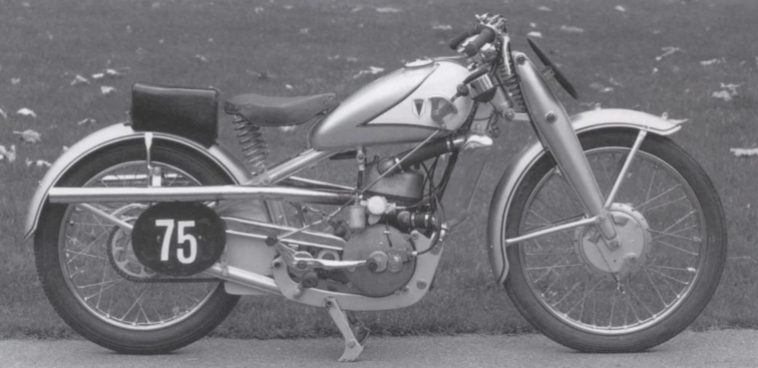
prospect that the German Silver Vase team with the DKW drivers Geiss, Kluge and Winkler had remained penalty-free thanks to the heroic self-conquest of Winkler and thus had the Silver Vase pretty much in the bag…But it was apparent that the Czech national team’s sidecar machine could barely keep up with the required pace. And in the fourth round, the crazy Czechs took their fate. The 350cc Java, which had already produced suspicious noises at the beginning of the final examination, eventually stopped after becoming slower and slower. The engine had broken down and had no longer endured the ruthless twist on the Füssen road triangle after the six-day trial. And so the Czechs lost the trophy again to Germany, after feeling like a sure winner in the morning. One can imagine that the German national team ran their final rounds under the shocking jubilation of thousands of spectators crossing the Füssen street triangle. The lap of honour turned into a unique triumphal ride, and as they entered the parking lot, the brave drivers were almost torn apart by the enthusiastic crowd. Nevertheless, the applause received by the German silver vase team was no less. The three DKW drivers stayed close to each other during their nine rounds, as they had only to keep their average. Their machines—this is the charging pump model, as well as compressor engines—also survived this last test without a single suspender. Thus, the supercharger concept idea in the touring machine must have celebrated a complete victory, as the German motorcycle industry can be proud of this overall success. And a third great joy gave us this very well-finished day, namely the victory of the DDAC team in the competition for the prize of the Corps leader Chickenlein. This award, which was won for the first time last year by the Dublin students, also went to German hands this time. You can’t really win more convincingly.” Meanwhile, back in Blighty the Cheltenham Chronicle reported: “Evesham Rider Awarded Silver Medal—The International Six Days Trial in Bavaria finished on Saturday with Germany the winners of both the International Trophy and the Silver Vase. Germany’s national team dropped 28 marks during the week—because of a cat. On Saturday J Seltzer was riding at speed when a cat ran across his path and was killed. The marks, were lost through the time taken to repair the damage to his machine. Czecho-slovakia had only lost 22 marks and were ahead of Germany, but one of the riders gave up in the speed test, losing 44 marks. England was third with the loss of
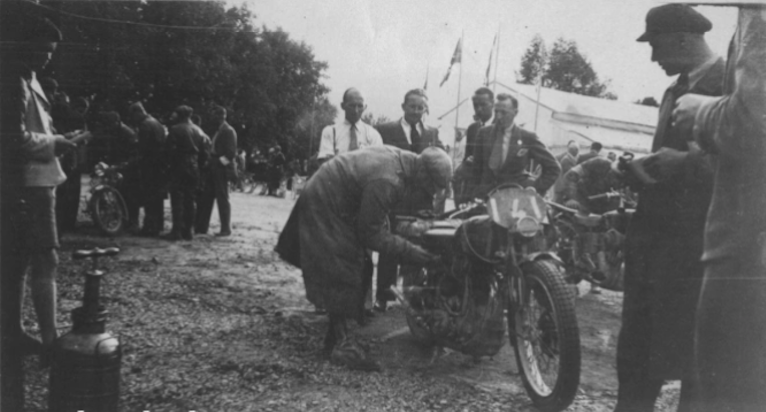
401 marks, and Italy fourth with 402 marks lost. Tim Robbins, the Evesham rider, gained a silver medal awarded to competitors not losing more than 10 marks. A letter has been received from Jack Williams of Cheltenham, who retired following a crash. He stated he was riding along a narrow track when a German motorcycle and sidecar came round the bend on. its wrong side. The only thing to do was to jump off his machine, and this he did, with no more damage than a sprained wrist. In the collision the chassis of the sidecar was torn from the cycle. A large crowd quickly gathered and, states Mr Williams, ‘If I had been hurt they would’ve murdered this man.’ He was a garage proprietor and on his way to attend to a German competitor’s machine, but he had no right to be on the course.” Results. International Trophy: 1, Germany (25 penalty points); 2, Czechoslovakia (66); 3, Great Britain (401); 4, Italy (402); 5, France (565). International Silver Vase: 1, Germany A (0 penalty points); 2, Czechoslovakia A (61); 3, Italy B (204); 4, Holland B (300); 5, Ireland A (303); 6, Holland A (404); 7, Hungary (515); 8, France B (565); 9, England B (600); 10, Italy A (601); 11, Germany B (623); 12, Switzerland (642); 13, Czechoslovakia B (903); 14, Great Britain A (R); 15, France A (R); 16, Ireland B (DNS).
“FOURTEEN DIFFERENT TYPES of sidecar to suit every taste and purse form the Pride & Clarke range for 1935. There are eight completely new models…The majority are now constructed with a combination of light aluminium sheet panels on a base of three-ply and a strong wooden framework.” Priced ranged from the Super-Lightweight Sports model at £7 7s 6d for bikes up to 250cc to the Airline saloon at £2 17s 6d.




KNOBBLY TYRES AND OTHER modifications had made trial bikes so good that courses had to be made tougher and tougher to give riders sufficient challenge. Some hill sections were now regarded as dangerous. The ACU hosted conferences where manufacturers, riders and organisers had their say on the sport’s evolution. The Colmore Cup was the first national trial to ban knobblies and within three years every major trial had a ‘standard tyres only’ rule. Inevitably the tyre manufacturers offered tyres that were as knobbly as possible within the rules.
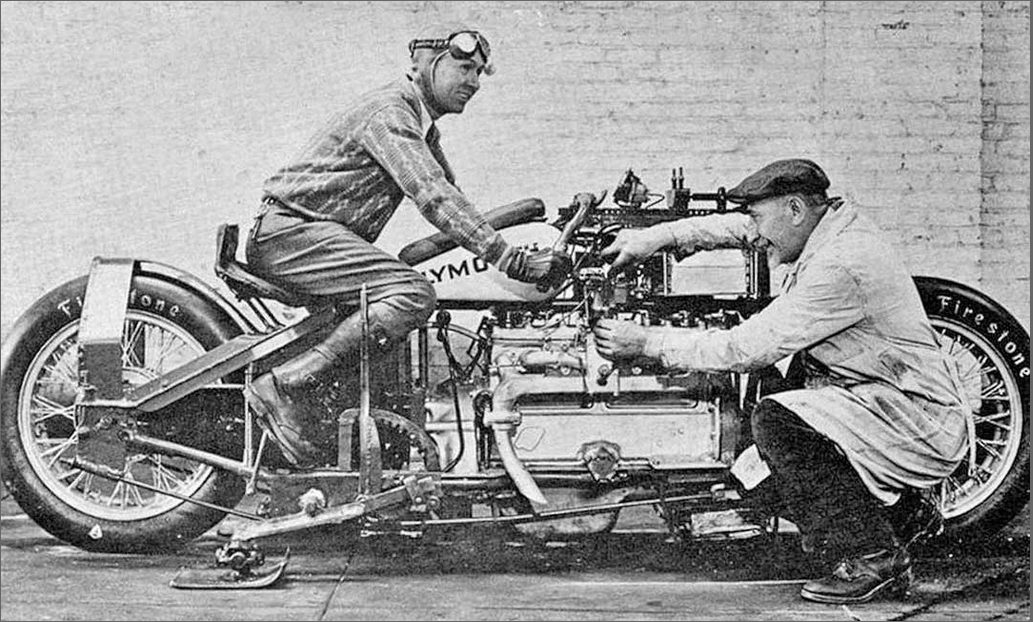
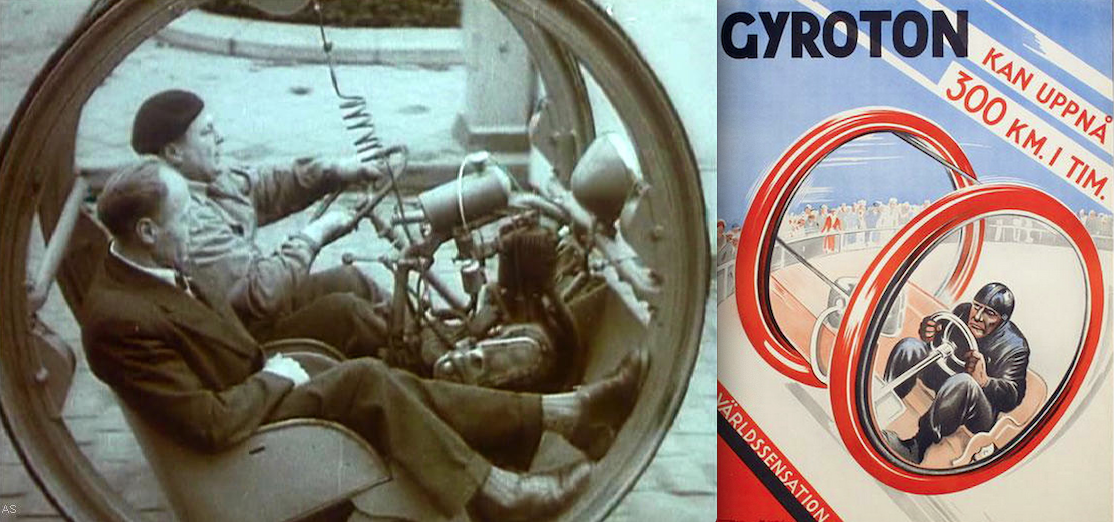
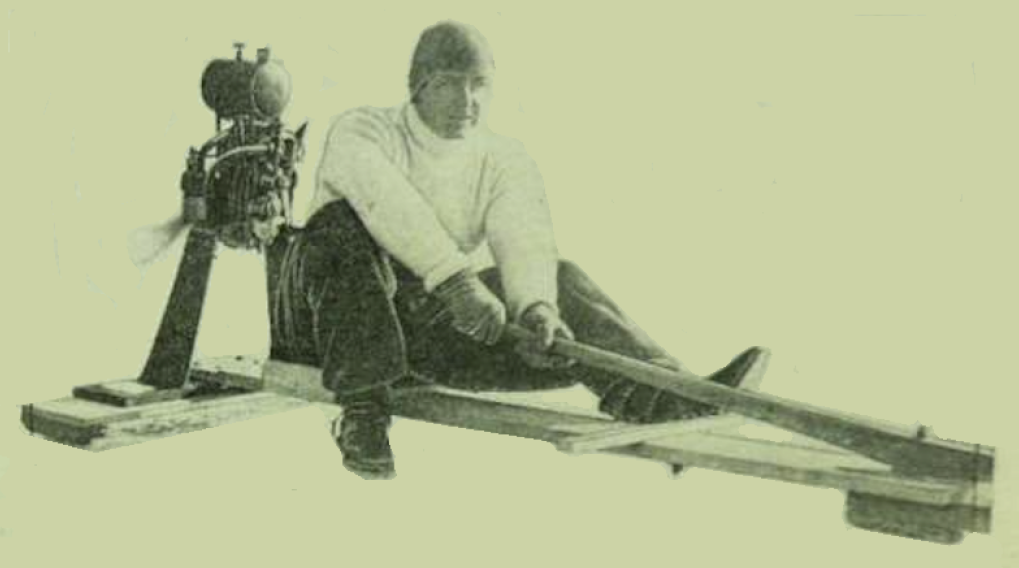
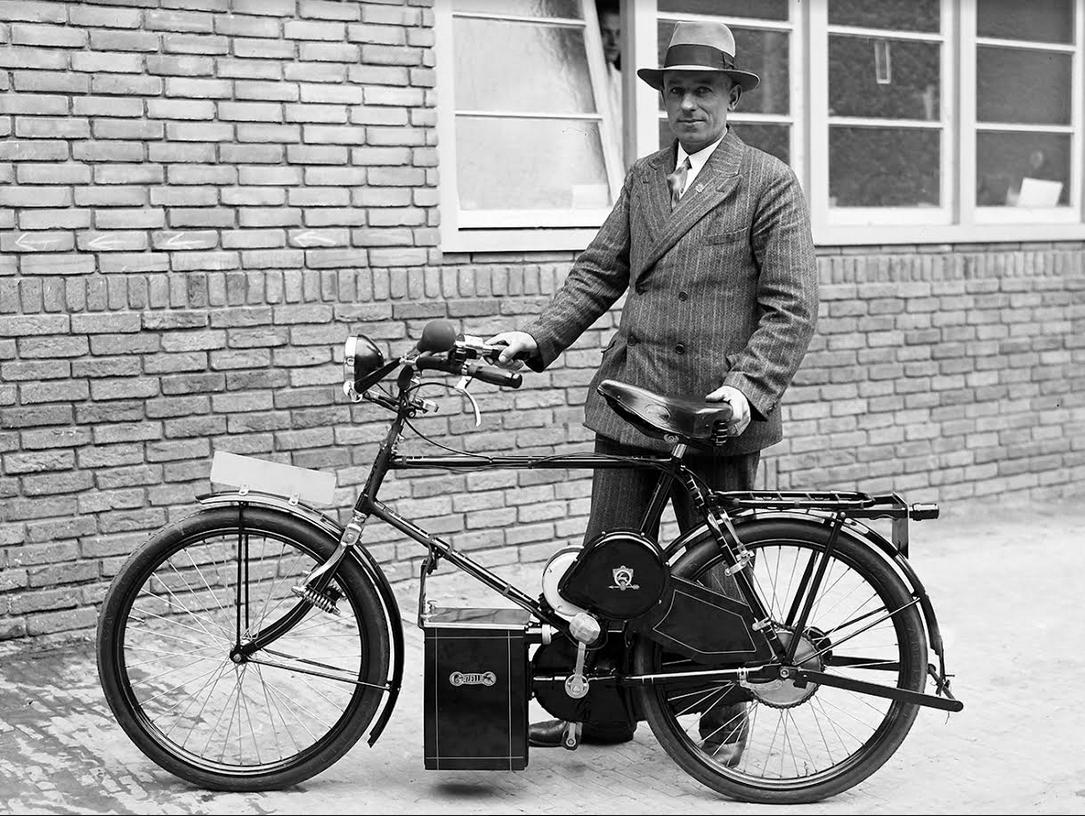
“NEW NEW ZEALAND RECORDS in both solo and sidecar classes were established recently. Riding JK Masder’s 500cc JAP-engined machine, C Goodwin, one of the Dominion’s veteran riders, averaged 109.09mph in two runs over a flying half-mile. On the same machine with a sidecar attached and with the owner as passenger, another veteran rider, B Bray, achieved an average of 89.5mph. The successful attempts were made at Muriwai Beach, about 30 miles from Auckland, North Island.”
“IN THE PAST BROUGH Superior machines have been too expensive for the majority of motorcyclists, and the maker has had many requests for a machine more in keeping with the length of the average motorcycle’s pocket. To meet this demand, a new model called the New SS80 has been introduced which, fully equipped, is to sell at £90. The power unit is a 1,000cc side-valve twin. All moving parts including the valve guides are totally enclosed and positively lubricated by a full dry sump system. The specification is the same as that of the 1150 model. This includes a duplex frame, four-speed gearbox with foot change and quickly detachable wheels with 3¼in and 4in section Fort Dunlop tyres on front and rear wheels respectively. Double strength, metal chains are used and the primary chain is totally enclosed. As usual on Brough Superior models, very large fuel tanks and fitted, the petrol tank capacity is 4½ gallons and oil capacity half a gallon. Full road equipment is included in the specification, namely, Lucas Magdyno lightning, Altette electric horn, rear wheel driven speedometer and a neat saddle of no less than 18 inches width. Although the price is a low, one for a Brough Superior it is stated that there is no alteration in the standard of workmanship and materials.
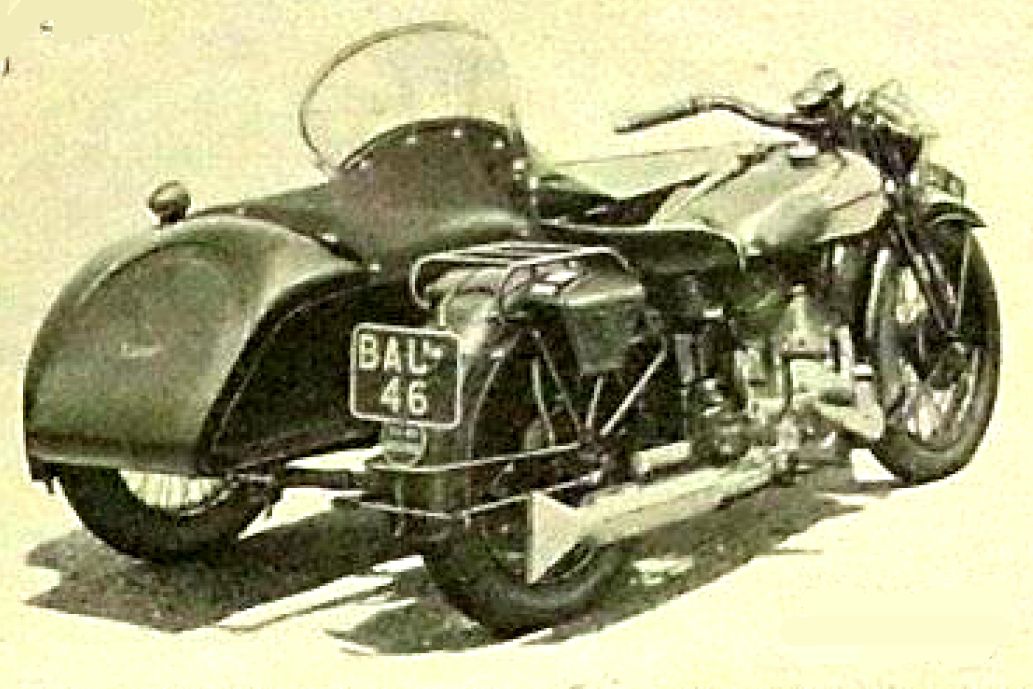
WORLD MOTOR CYCLE SPEED RECORDS were tumbling. Ernst Henne raised the flying kilometre record yet again, hurtling along the Frankfurt Autobahn on the blown 750cc BMW at 159.10mp—a London BMW distributor was appointed. The DOHC supercharged transverse four Rondine (Swallow) took a clutch of 500cc records at up to 152mph (ridden by Piero Taruffi it also won the 200-mile Tripoli Grand Prix). The Rondine’s manufacturers were busy building aircraft and sold the design and six bikes to Guiseppe Gilera; Taruffi joined Gilera as works rider.Harry Nash’s New Imperial, fitted with a light-ally flyscreen and engine enclosure, set a flying-kilometre record, at 70.1mph.
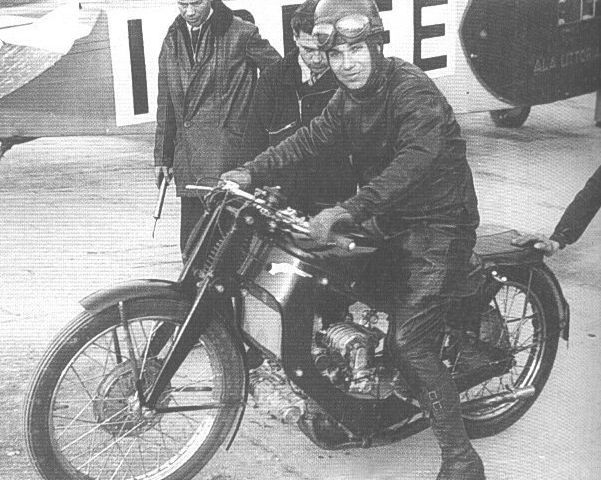
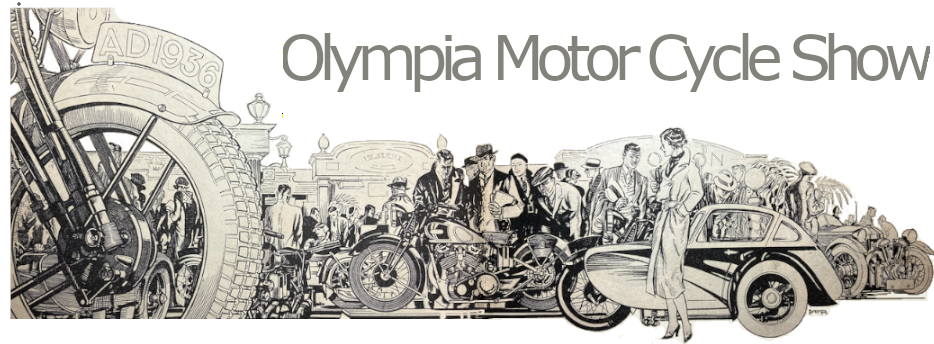
“‘MOTOR CYCLES FOR ALL NEEDS—machines that are quieter, cleaner, neater.’ This, as Torrens stated in the BBC’s National programme last Friday, is the slogan of motor cycle manufacturers, and the present Olympia Show marks a big step forward. Let everyone admit it: Over the past few years the industry has to some extent rested upon its oars. Some would use another less complimentary metaphor and assert that it has been in a rut. This is largely true and the cause was economic. The export trade was booming when along came the world depression and cut into it like a knife; down, too, went the purchase of motor cycles at home. Retrenchment was the order of the day, and the natural corollary was stagnation in design. Now a new spirit is abroad. General trade is on the up-grade. The industry is alive—determined to get out of the rut, to make better motor cycles and to cater for all tastes. We know this to be so, and the present show confirms it. There are two new four-cylinder motor cycles, all-enclosed motor cycles, machines made for two, the first of what is likely to be a series of motorised bicycles, half a dozen or more new engines…And there are many valuable but less spectacular improvements, such as the standardisation of larger fuel tanks, the fitting of prop-stands and the provision of better riding positions. Visiting the present Show is a tonic. The crowds are enthusiastic, and among them are thousands who have come not just as sightseers but to settle upon their motor cycles for 1936. They are lucky, so, too, are all who are able to visit Olympia, for it is the world’s most important motor cycle exhibition and augurs well for the future of motor cycling.”
“IT IS REASONABLE TO ASSUME that manufacturers exhibiting at Olympia place the most emphasis upon the models they expect to be the best sellers. Thus, if a particular 500cc model is looked upon as being the most important in the range, several examples are usually displayed. Hence an analysis of the machines at Olympia is of more than passing interest. All told, there are 320 machines on manufacturers’ stands. Of these, 277 are solo motor cycles, 31 sidecar outfits and 12 three-wheelers. The most ‘popular’ type is the 500cc machine. One in three (33.5%) of the machines on the stands is a 500; next comes the 250s, with 24.7%; then the 350s, 19.3%; I,000cc machines have a total of 8.4%; for 150cc it is 6.3%, and for machines of 600cc and over 1,000cc, 5.3 and 2.5% respectively. Over 13% of the machines exhibited have more than one cylinder. There are 11 four-cylinders and 31 twins. Push-rod operated overhead-valve engines, of course, hold sway numerically. Slightly over 63% of the exhibits are of this type. Next in order comes the side-valve type (18.5%); then the two-stroke with 11.3%, and overhead-camshaft designs, 6.5%. How widespread has been the adoption of the four-speed gear box will be gathered from the fact that this year no fewer than three out of every four machines are so fitted. That sensible feature, foot operation of the gears, is now standardised on a large proportion of the exhibits, both touring and sports machines. In the majority of cases the gear box is separate from the power unit; nevertheless, no fewer than thirty machines have unit construction.”
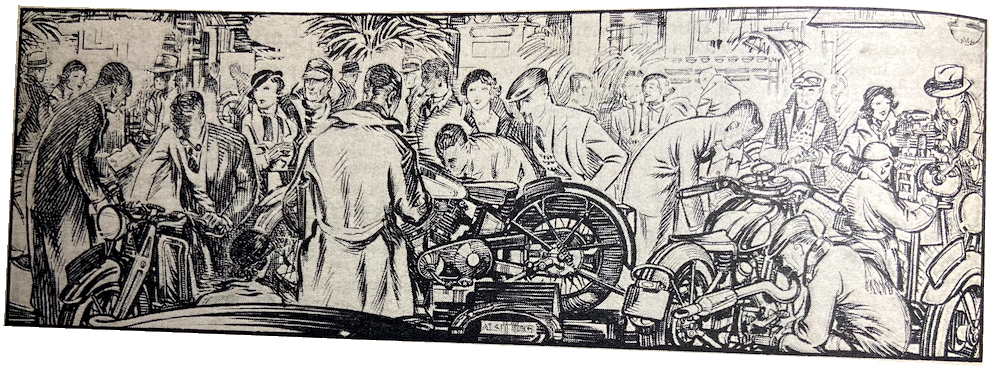
“IT TAKES TIME TO SEE the new AJS at Olympia.,” Ixion warned, “Not merely because it deserves study but because unless you are very tall hours can elapse before your view includes more than shaven necks, turned-up collars, and such like. After exhausting your patience in a prolonged Rugger scrum which pretends to be polite, you eventually arrive in or near the front row, and commence to lean backwards, and employ your ‘situpon’ as a lever to thrust the crowd away so that you can enjoy a thrilling model. Doubt if any machine staged at Olympia has ever gripped quite so any visitors. It is an attempt to make the best of both worlds, for it should serve as quite a docile tourer and even potterer, attractive to those who like the best; and plus a blower, and a gay grasp on the grips, it should hunt the fastest on the roads. Everybody is suggesting that if it could be mass-produced by the thousand it might render many machines obsolete within twelve months. We greet it well, and hope that racing fame awaits it. But here’s a searching question for you—if it is entered in the 1936 TT and is not too young to stand up, who is going to ride it?”

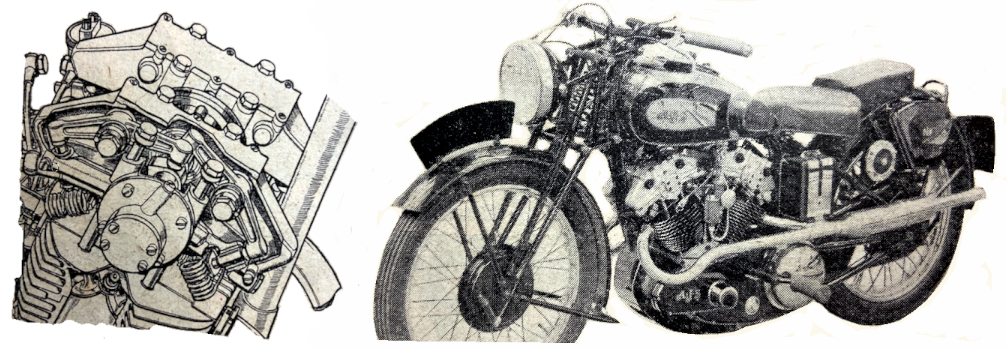
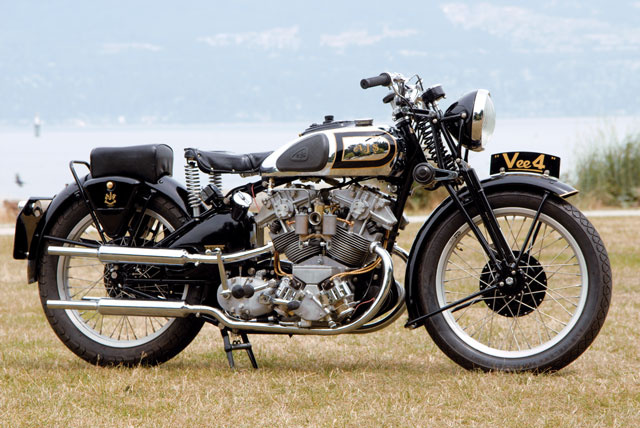
“ROUND OLYMPIA WITH IXION: The great hall at Olympia has never looked better than on opening day. Once upon a time in boom days there were a round hundred more exhibitors than survive to-day, and the floor looked cluttered up. Nowadays each exhibitor is allotted a nice slab of floor, and can space out his machines, whilst the factory artist has a freer hand in designing top-hamper for stand decoration. Moreover, I found on opening day a really gratifying crowd of cosmopolitan engineers, financiers, salesmen and road enthusiasts. Like most Britons I made a bee-line for the new AJS four-cylinder, preening itself rather consciously on an electric turntable in a little railed-oft paddock studded with flood lamps. It is definitely to be raced. No super jockey has yet been engaged, but the Men Behind consider that its extreme (‘blown’) speed will tempt every free star out of his present orbit; and that even if they don’t nab a super star, it will be so fast on the straights that an ordinary sort of a lad could throttle it round corners and yet beat a super star on any other bus. I passed to the Norton stand, where the jewellery counter simply screams for a ‘stick-up’; their trophies are now numbered by the thousand, and it is whispered that every stand attendant has a holstered ‘rod’ under each armpit. Nobody there would tell me anything…the atmosphere was ‘deeds speak louder than words’, and ‘what we have we’ll
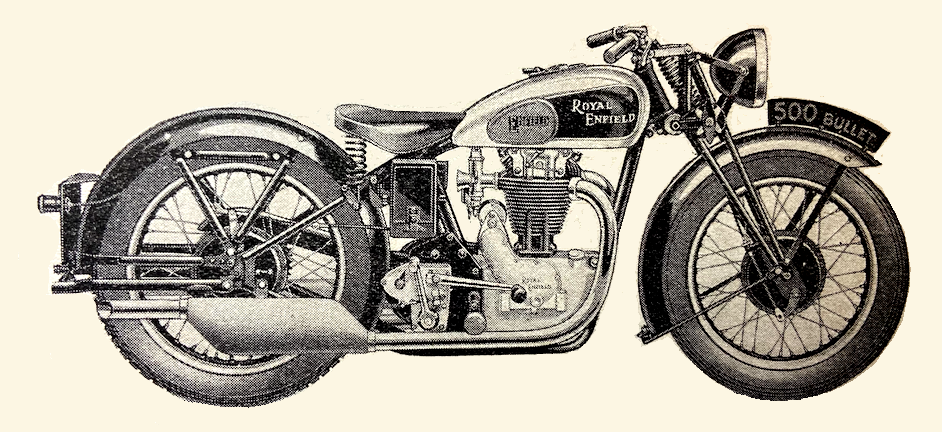
hold!’ I gathered that if the Guzzi was ill-advised enough to come to Douglas next year it would learn where it steps off. Then to the Levis—said to be the nearest approach to a ‘tool-room’ job surviving in the industry, ‘specials’ always excepted. There is only one girl in the works (a dipper in the enamelling shop), and only one boy (he runs errands). I gather that the rest of the Levis crew are the sort who were teethed on a spanner, and always had a feeler gauge hidden in their binders. Nice jobs are the new ‘Light’ models; anything up to 30lb lighter than their prototypes, and full of performance. I liked the external rocker adjustment, and a handlebar which maintains its grip angle irrespective of whether it is set low for the road or high for the ‘Colmore’. Along to Royal Enfield, still all meek and blushing at being the only 100% trade team in the ‘Inter-national’. Their technical men are worth hearing on the subject of quickly-detachable wheels, which they regard as absurd. If the puncture is a nail, you don’t want to swop the wheel, but only to expose a nice arc of tyre—so they loosen (not detach) four nuts, and the top 180° of the tyre is laid naked. If the hole is too small to find or too large to mend, you want a new tube. Pull spindle out 1½in; spring forks ⅛in; out drops a distance piece; thread old tube out via gap; thread new tube in via gap; and there you are. Rudges are another firm who have done a lot of quiet ‘development’. The comp Ulster is based on MacGregor’s Scottish winner; it has a three-row bearing big-end; a lighter
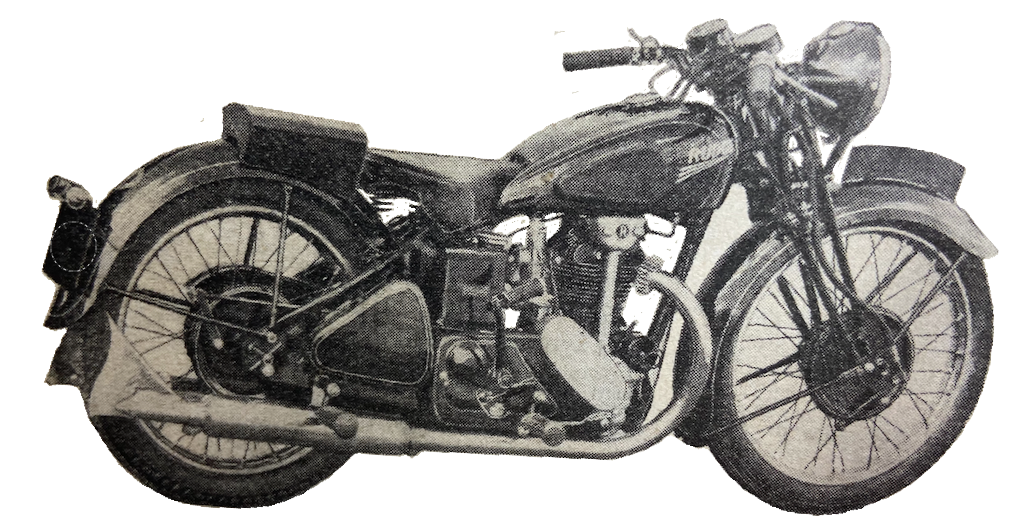
front-wheel assembly to facilitate handling over bad stuff; and a belt drive for the dynamo, so that the lighting set can readily be dropped for trials work. Keen attention has been paid to silence here—note the absorber tube in the tail pipe and the neat little strip gauge so that you can reset it accurately after a noisy day in the wilds. The OK Supreme people were busy booking orders and trying not to look turkey-red under customers’ compliments. They were evidently very proud of their 90mph high-camshaft 500cc at £65. I gather the last few miles are based on special tuning, as the bus is 50s cheaper minus a speed guarantee. George Brough for once could hardly be induced to talk about his buses; he was too excited at the idea of competing in yet another Exeter run; he was one of the gallant 46 who competed 25 years ago in the first of the series, but he displayed with pride Fernihough’s racer, which has done a standing half-mile at 88mph, a truly fantastic acceleration. He offered to guarantee his new big-end for ten years, and as a proof the Rolls-Royce specification of the BS showed me that even the rear-stand pivot was furnished with its own to little greaser. The Vincent-HRD machine continues the kind of progress one expects from a factory where directors are riders. They confess that the TT taught them a lot—especially about lubrication. They have probably eliminated primary chain
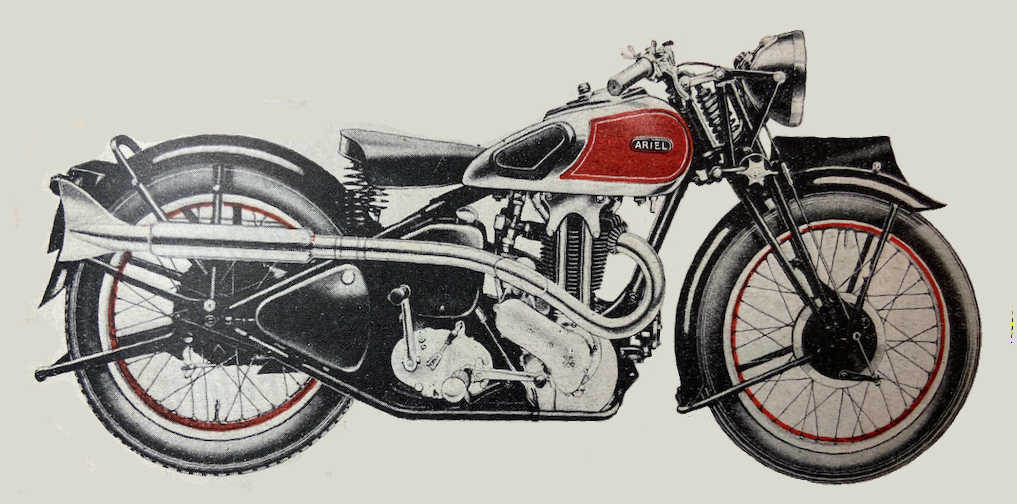
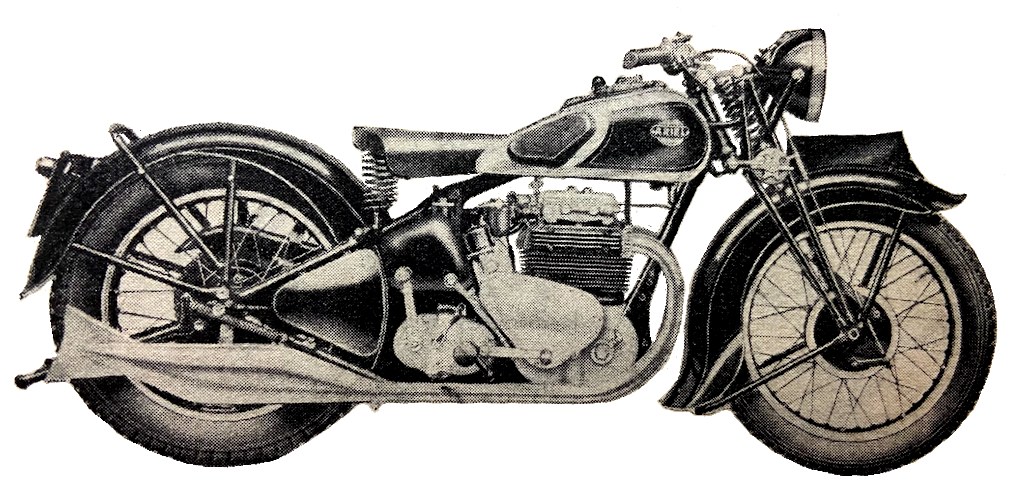
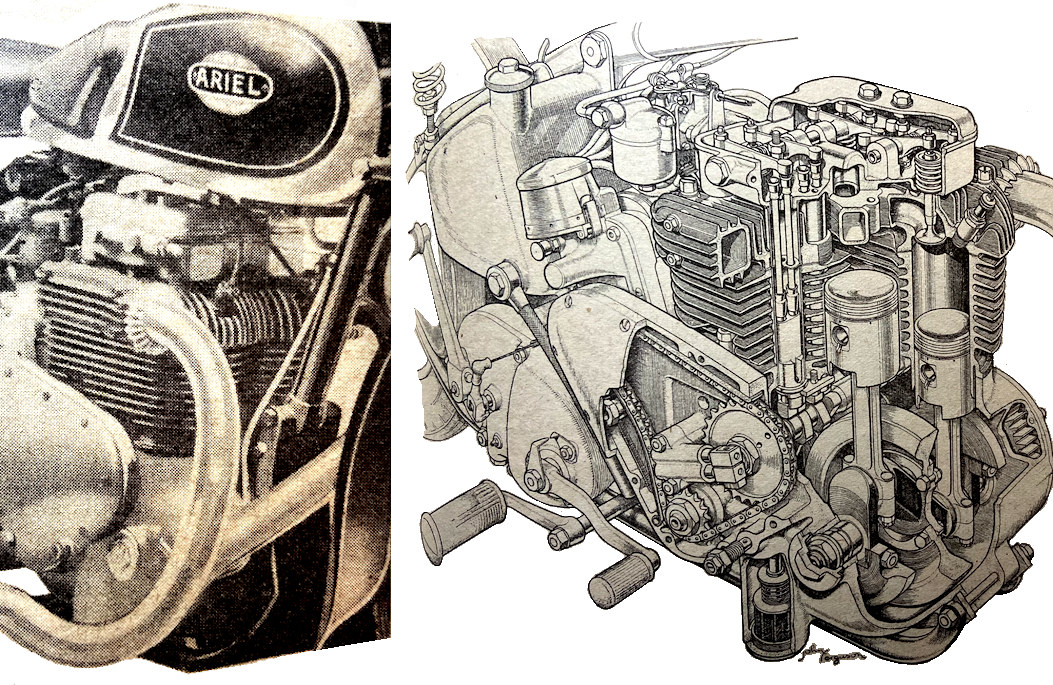
troubles by using a duplex chain in an oilbath, with a cunning little external gauge for testing tension. I like the manner in which the important instruments are all mounted forward of the handlebar. The Morgans are better looking than ever, and it is small wonder that they sell well in competition with small cars when one considers that the £114 model with a four-cylinder, water-cooled engine cruises at 60mph and is most economical to run. Ariels are very absorbed with jigs for the new 1,000cc four, which will be in production by March. Designer Turner was very interesting on the multi-vs-single debate. He is not trying to wring more knots from the Red Hunter singles; they do a genuine 90mph already, and though you can get more, it would demand a racing plug, and be useless in traffic, whereas the 1,000cc four, being so lightly stressed, can do a 100mph on any normal plugs you like to fit. The cynosure of the BSA stand was a star-shaped dais with one or other of the new Empire Star models on each point of the star, and a centrally-illuminated pillar displaying the verdicts of various experts and racing stars on its manifold merits—a most effective piece of showmanship. A new Velocette is always an event. Neat as the original camshaft was, the new model has a far simpler and decidedly more efficient cylinder head, and the lubrication is said to be a ‘wow’; we shall watch this machine in the
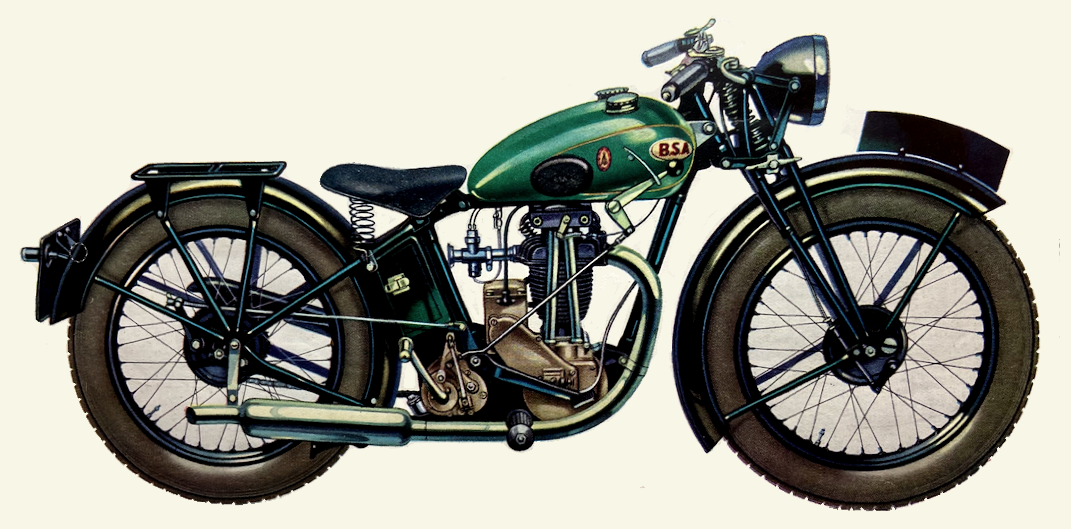
A twistgrip and Dunlop pillion seat cost 7s 6d and 8s 6d respectively.
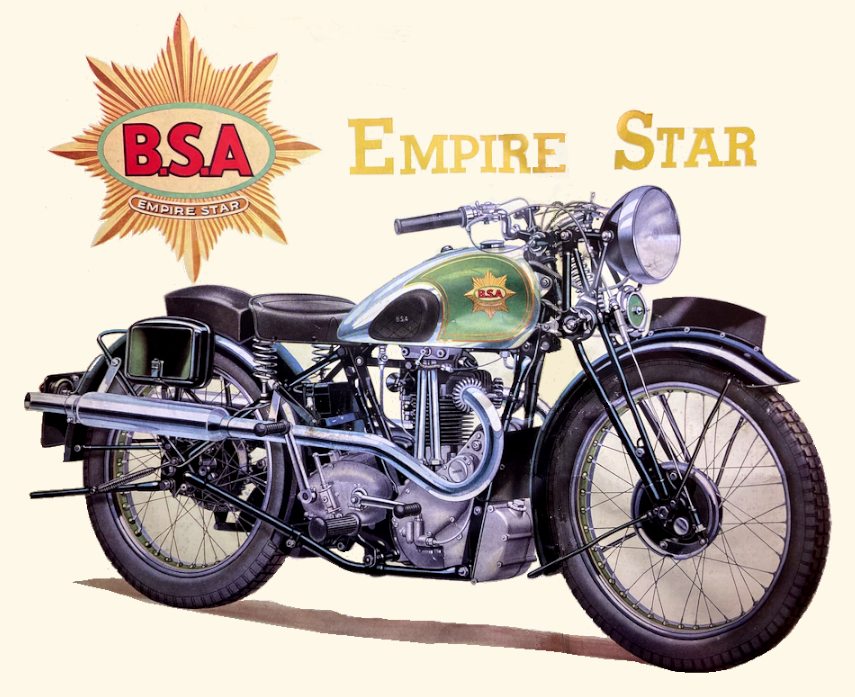
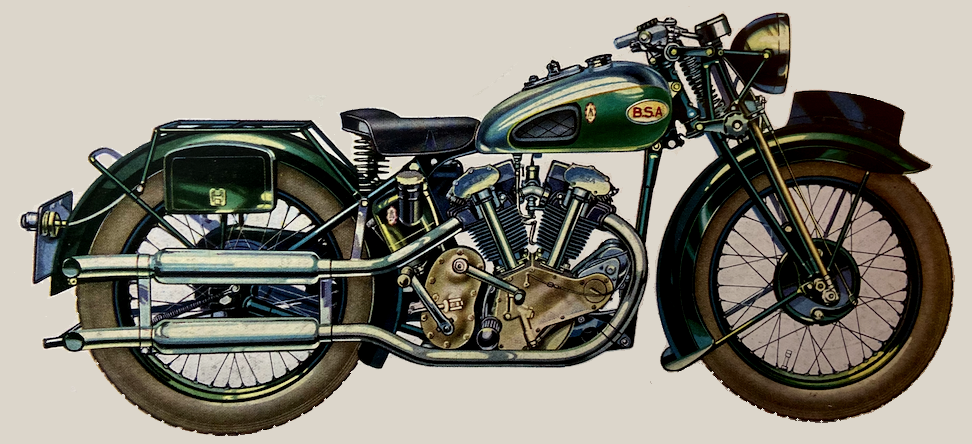
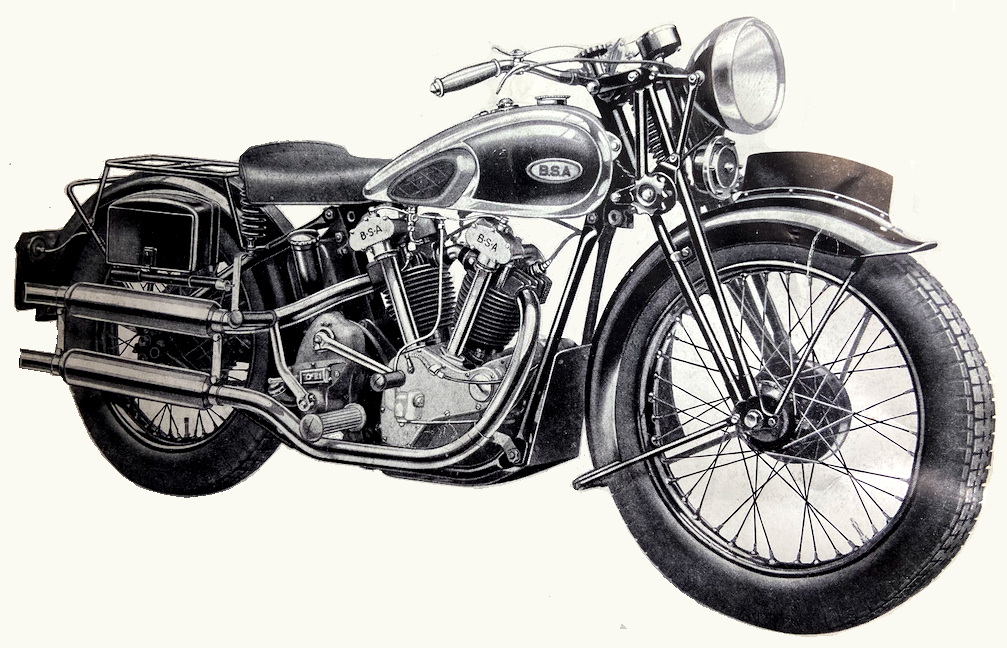
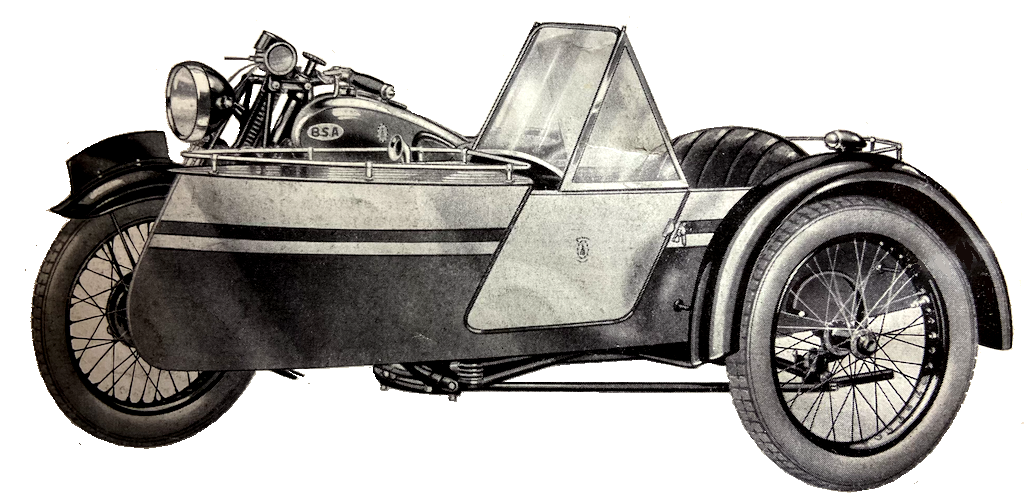
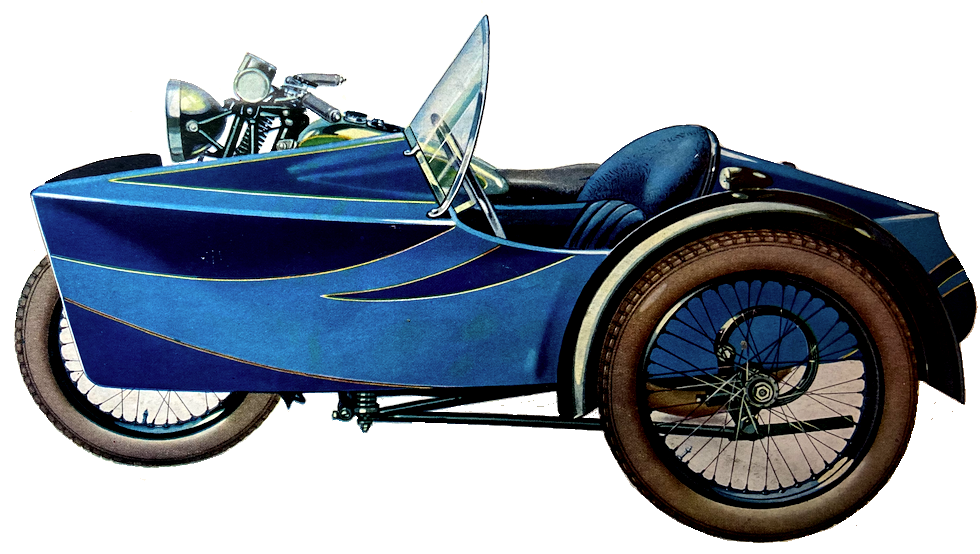
1936 TT with the highest expectations. A 500cc Manxman stood proudly on the Excelsior stand; it has already done a timed 96mph in roadster form, and is not passed off test at less than 30bhp. Development of these models comprises a host of vital lubrication details. The ‘Manxmen’ have special gear boxes with ball bearings at both ends of the layshafts, and the gear change pedal pivoted very far back. This sounds trivial, but actually it furnishes a gear change with less pedal motion and permits the footrests to be set well back, where a racing man wants them. The Coventry Eagle Pullman two-seater drew such crowd that lady pillionists obviously hate muddied stockings more than I had imagined. The machine bristles with pleasant details—rear bumper, rubber fenders on legshields, accessible battery, excellent chain adjusters, and super silencing. At long last the Francis-Barnett people are charmed with the flat-top piston model of the 250cc Villiers engine. It is definitely 3mph faster than the old deflector type, and will do as near 60mph as no matter; it is innocent of piston slap; it can be flogged indefinitely on arterials; and it registers round about l00mpg at 30mph. The carburation is now completely OK, and altogether the delay in production has been amply justified. The James stand was eminent for some low-priced baby two-strokes—and some three-wheel delivery vans. Crowds round
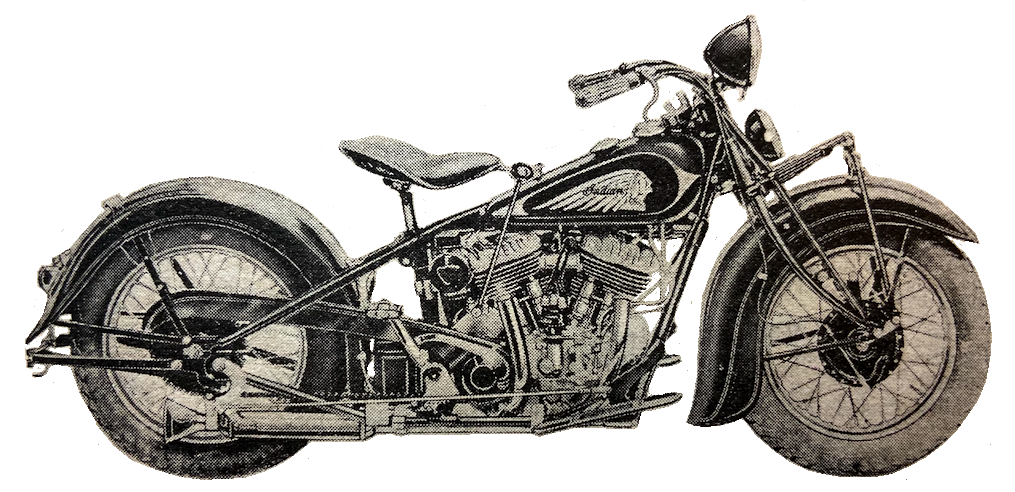

the Triumph range were mainly concentrating on the 650cc vertical-twin with the helical-gear primary drive, and the new Model 3/2 sportsman’s 350cc model, which has been redesigned for low weight and high performance. Their 500cc ohv model, too, looks a gem. In their de luxe equipment that very rare item, an illuminated instrument board, is included; I could never see why instruments are useful only by day, as most designers appear to think. Freights, tariffs and insurances prevent the Indians selling as freely in this country as their intrinsic merits would otherwise ensure. Their ‘four’, in spite of being a line-ahead, somehow looks more compact than our V4s, but the detail design would stand cleaning up. Many of the fittings are worth close study. I was told on the New Imp. stand that they had now sold 25,000 ‘unit’ models, and were still awaiting their first order for a helical gear replacement. This factory claims the allegiance of an amazing variety of riders; they sell small stuff to the impecunious, and simultaneously they find customers ready to pay £92 10s for a Grand Prix 350 with aluminium-linered cylinder and bronze head. In the days when the bloods of the movement could afford to pay for the best, Sunbeams thought nothing of asking over £100 for a 500 of the first water, and the depression naturally hit their special de luxe market rather hard. I admire the skill with which they brought down their prices to suit altered conditions without jettisoning the ideals for which they were always famous.For 1936
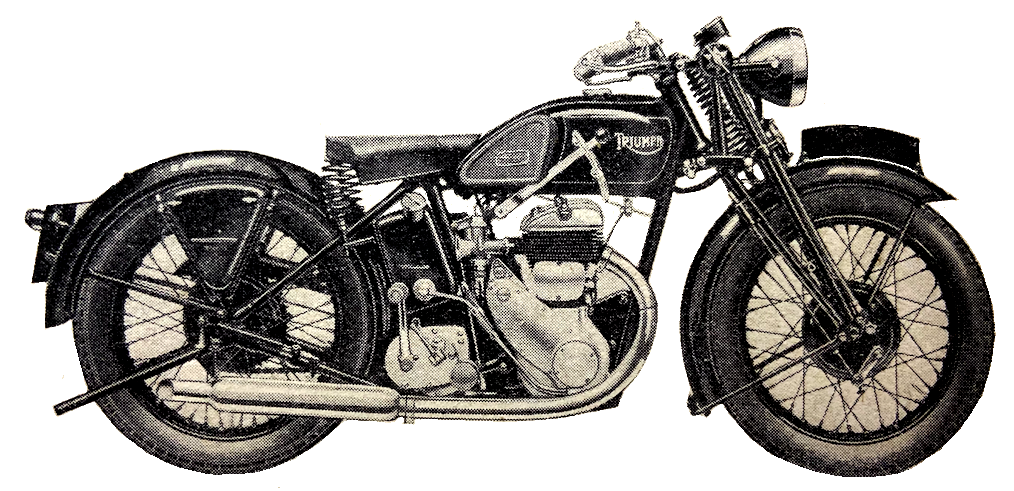
their 500cc ohv costs no more than £66 without lighting, and what an aristocrat it is!We must bid a tearful farewell to the Matchless four-cylinder. A few of the Silver Arrows are still being made to special order, but the Silver Hawk is dead. This factory possesses one of the finest plants in the motor cycle industry, and makes engines for a number of good firms. The star of its 1936 range is the Clubman model—a good clean design free from all eccentricities. The Matchless people stage one of the best prop stands on the market—a long, heel-operated fellow with a radial action. The engines have one invisible detail of interest—their valves are chromium-plated, except for the seats; this has eliminated sticky valves during the running-in period; when the plating is worn off the high spots, the guides have bedded down properly. Their primary chains, which are not duplex, betray no serious wear after 15,000 miles, thanks to a really oil tight chain case coupled with an improved shock absorber. Space forbids me to notice other exhibits in detail, but those who hope that one day the Government will wake up to emulate foreign dictators, and free small engines from tax and insurance, should study the 125cc Villiers unit (engine and gear box). The engine is a snorter for its size, and with the aid of a deflector-less piston achieves good performance and high economy. It being assembled into (a) motor cycles, and (b) motorised bicycles by two or three firms already, despite tax and insurance burdens. For example, the Wolf people sell either type of machine at £18 10s. These tiny machines ought to be counted by thousands on our roads–as their opposite numbers are in some Continental countries.”
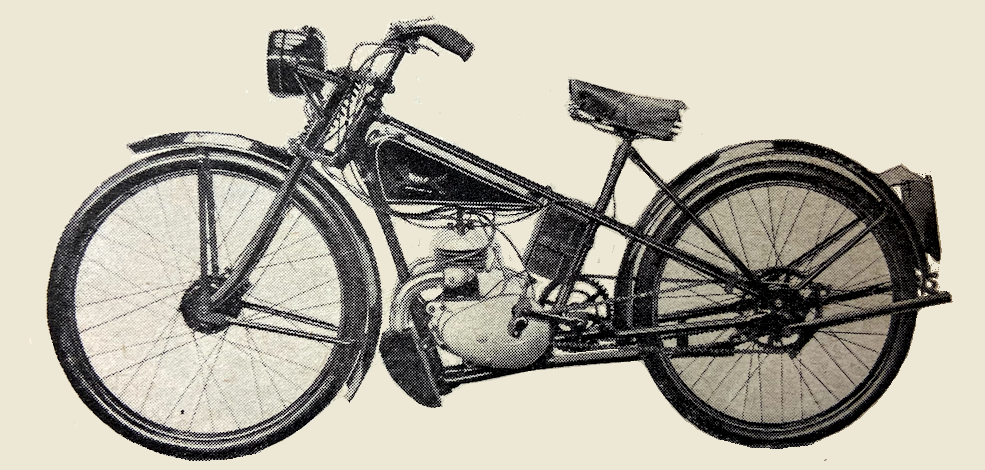
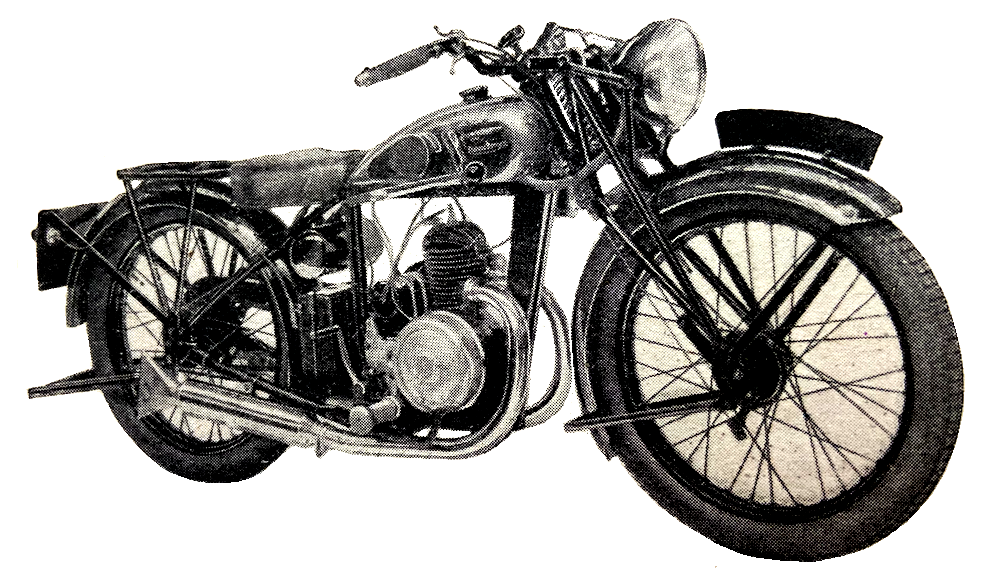
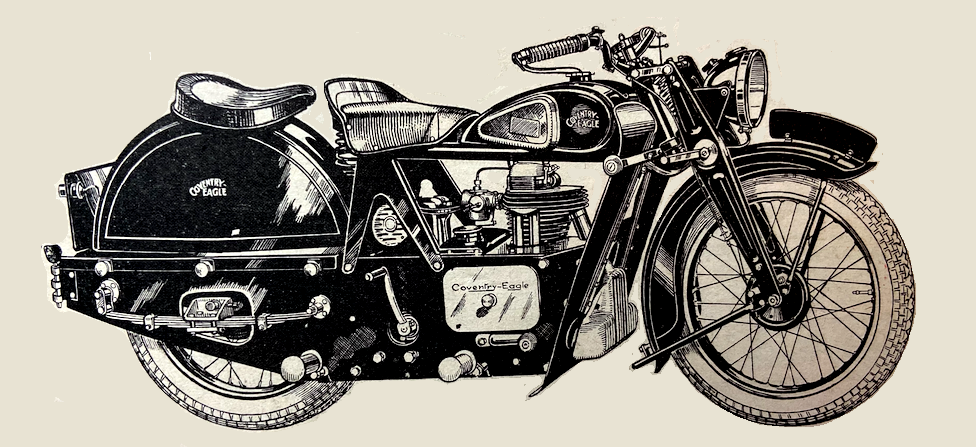
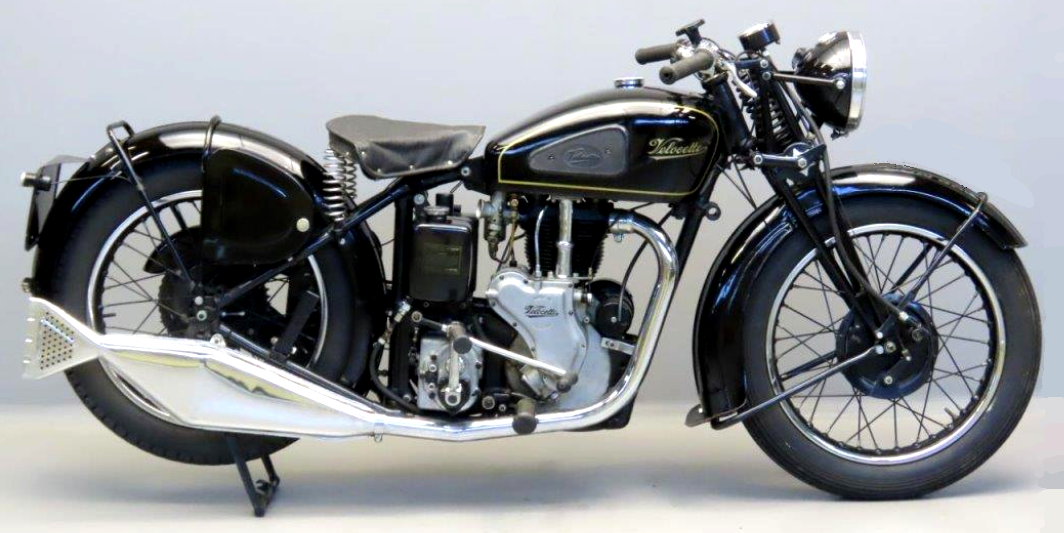
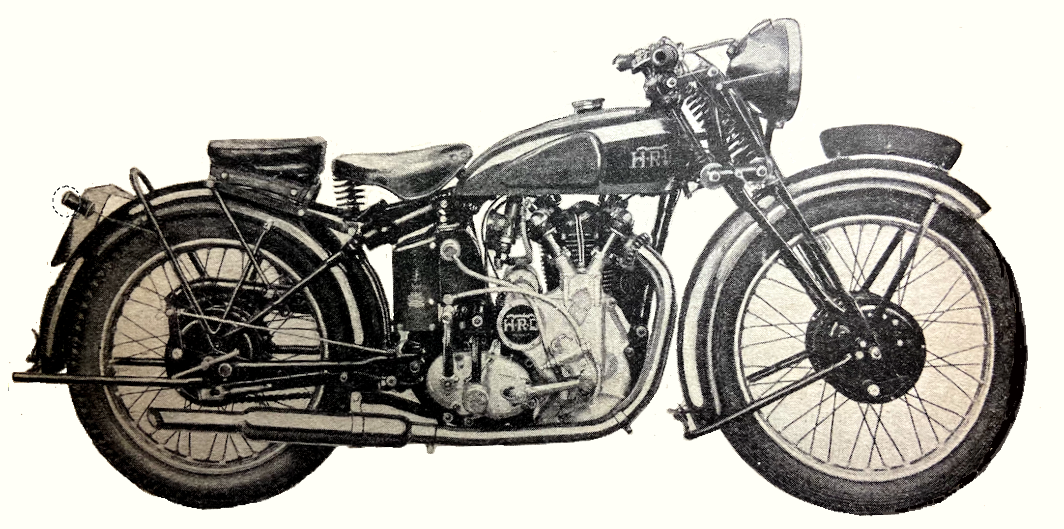
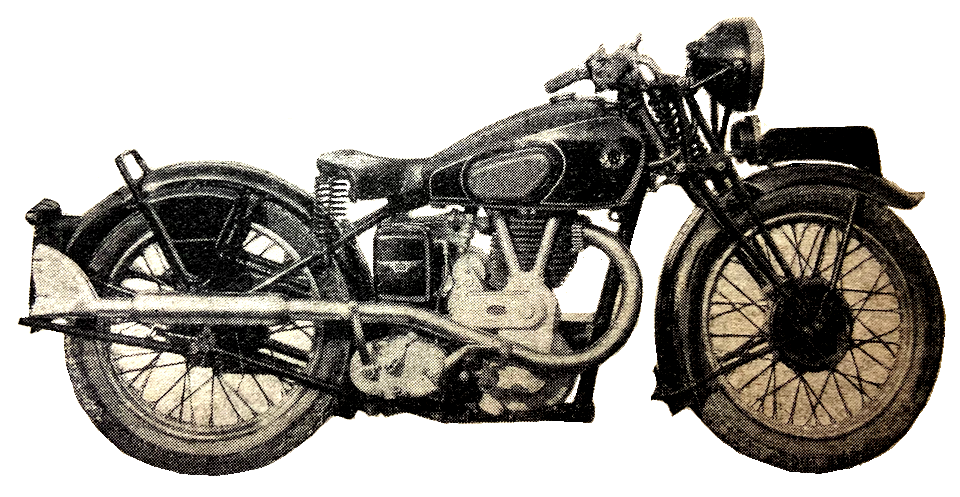

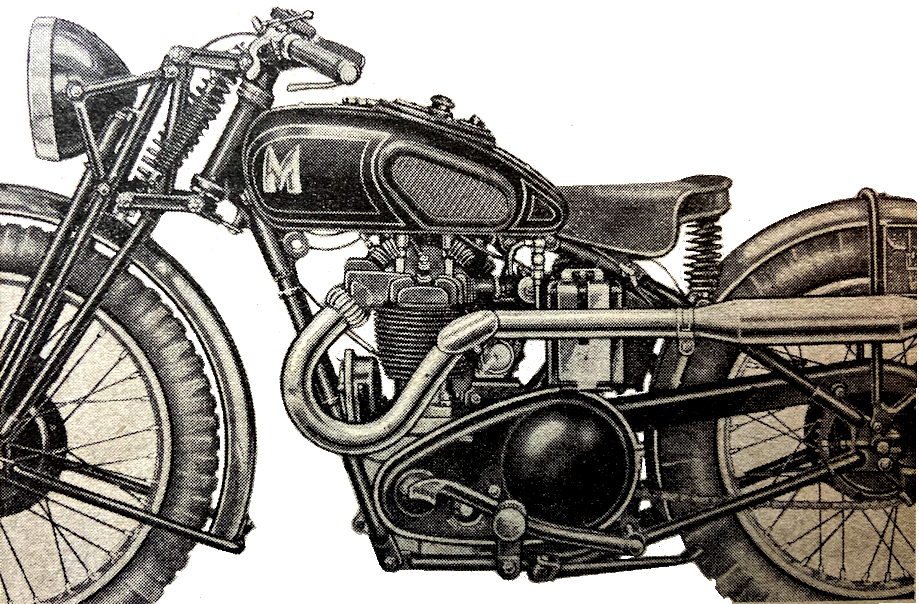
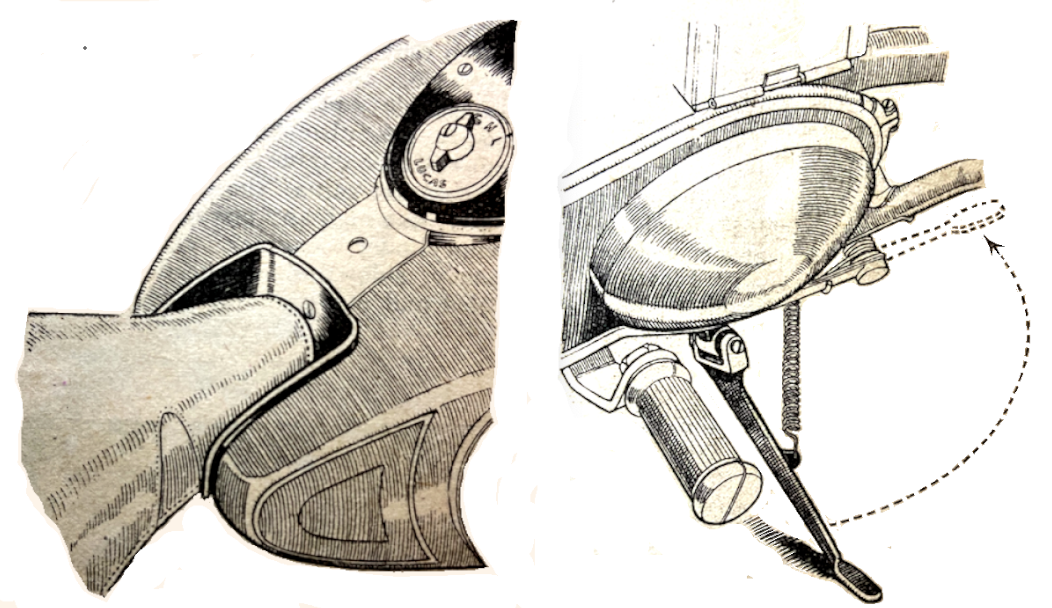
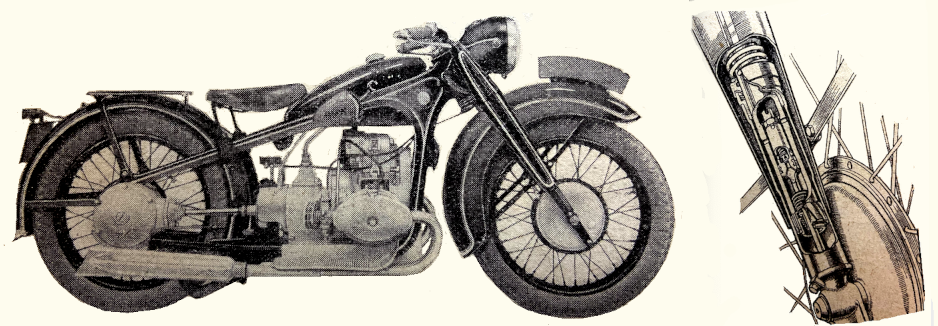
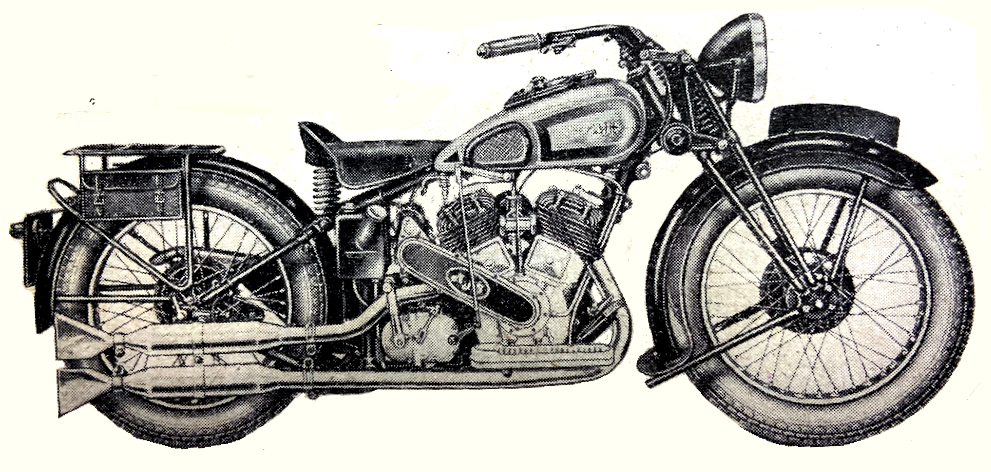
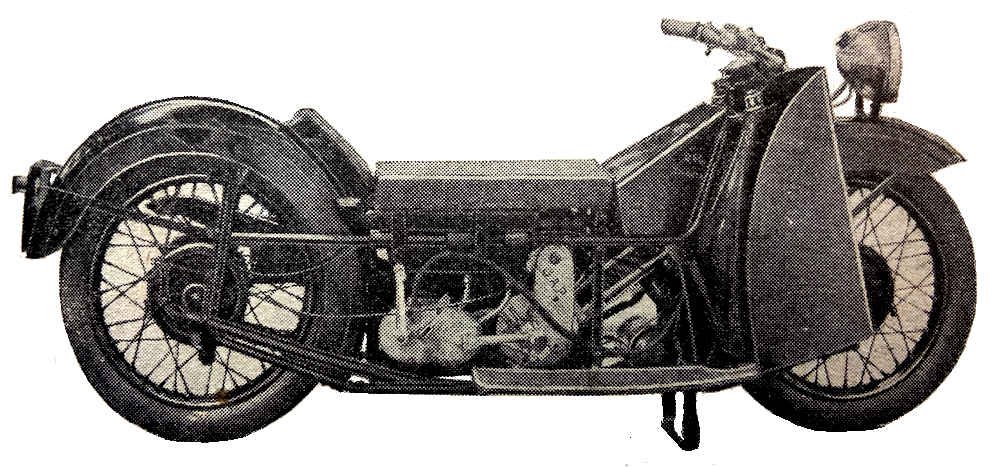
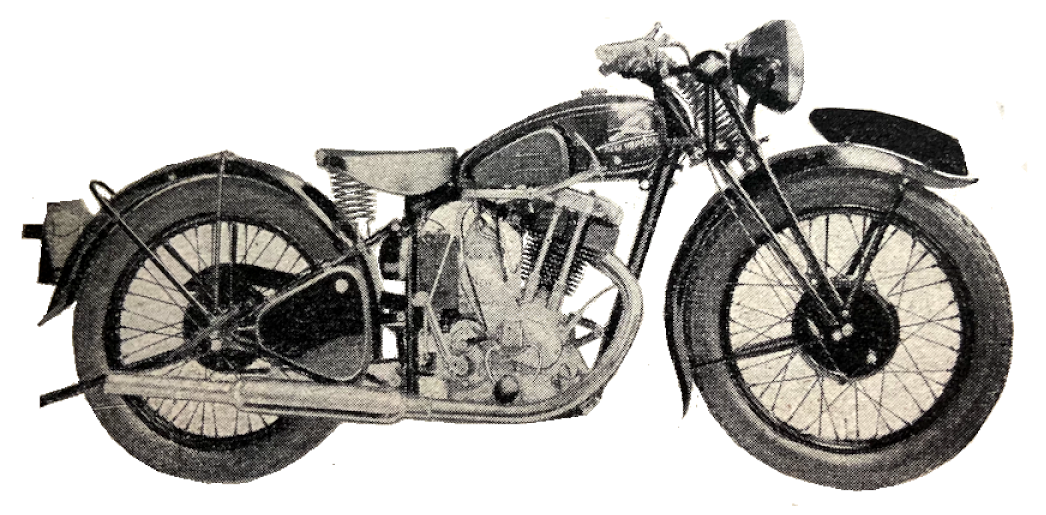
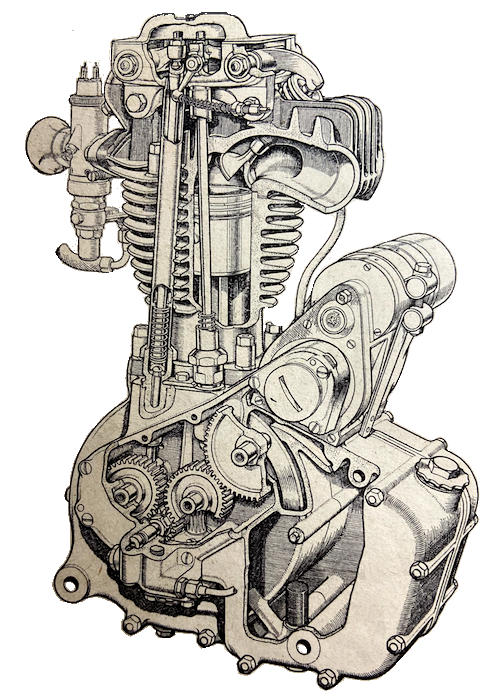
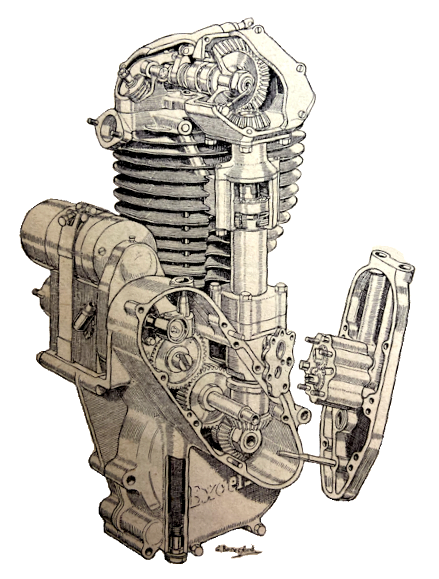
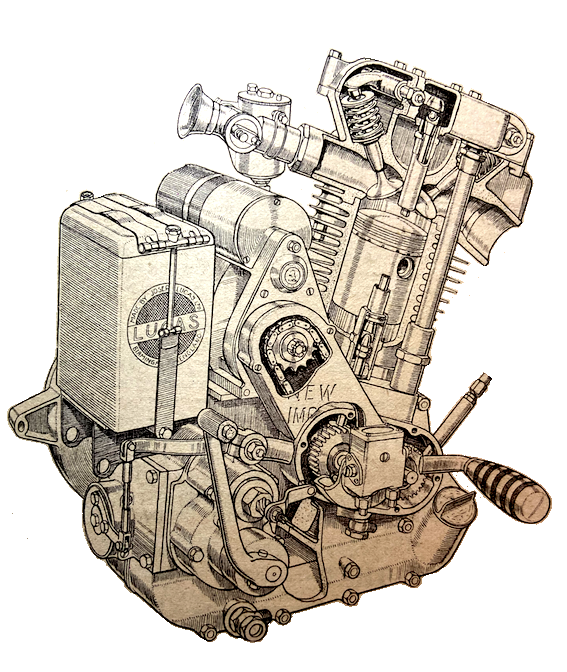
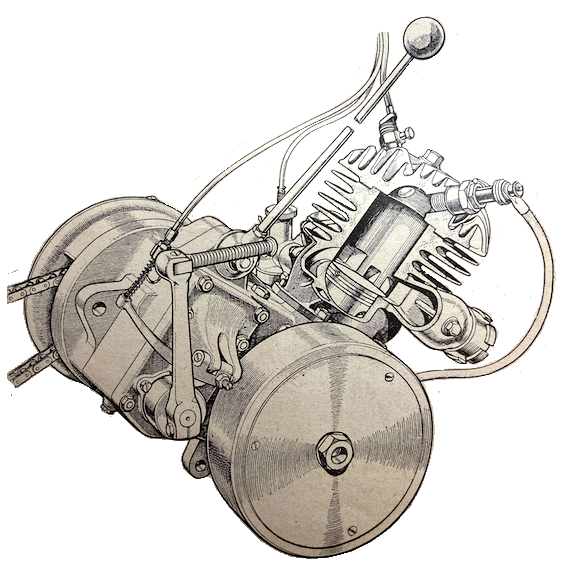
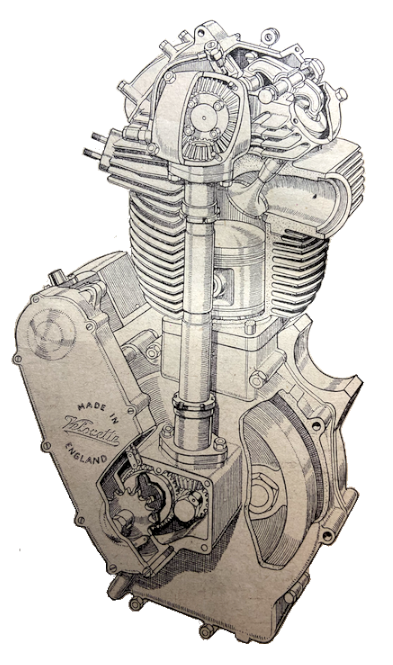
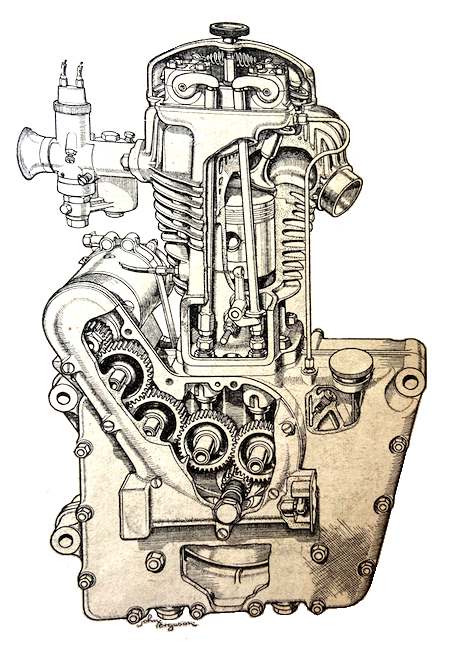
“AFTER OPENING THE SHOW Mr Hore-Belisha, the Minister of Transport, joined the BMCA Fellowship as Member No 1. The Fellowship scheme is something new. The Association has found that there are many motor cyclists who want to support any organisation that will really fight the motor cyclist’s battle, but do not want to pay a guinea for the full benefits of membership—legal defence, technical advice, touring information, and the other facilities. Hence the Fellowship scheme at five shillings, which includes a lapel badge. Another interesting bit of news is that, following the BMCA’s approach to Parliamentary candidates at the recent Election, Lord Sandhurst and Captain Strickland, MP, have formed a strong committee of MPs to watch over motor cyclists’ interests in the House of Commons—which, as we suggested in a leader a fortnight ago, was the next and obvious step.”
“ONCE AGAIN LEN HEATH (497cc Ariel) collected the principal award in a scramble type of trial—to wit, the Alfred Scott. Memorial Trophy, which was ‘raced’ for last Saturday over some of the roughest going in Yorkshire. Heath came very near to making zero time, also, but was pursued throughout by Allan Jefferies (493cc Triumph), and as the local rider steadily closed up the starting interval his time for the 49 miles (or so) became the standard. It was 2hr 28min 18sec. On time Heath lost only two marks, but by very tidy riding over the many difficult obstacles his total loss was only 39 marks. Jefferies, losing no marks on time, dropped 54 on observation; his rapid progress was rather dearly bought, for Vic Brittain (490cc Norton) got round with a loss of 36 observation marks and only. dropped seven on time, so he showed a better result and was the runner-up. George Rowley (498cc Matchless), with the same loss of observation marks as Brittain, took the pot for the best performance ‘on observation only’. He put in some exceedingly pretty riding on a model that seems to lend itself to sure control at quite low speeds on ‘impossible’ places. George certainly disproved any belief that he succeeds only by turning up the wick and hoping for the best (tactics described in the Scott Trial country as ‘muck or nettles!). The route of the trial was an even more concentrated version of familiar obstacles than the previous year’s course. It was compressed into a circuit of about 15 miles, almost entirely over practically unused tracks across moorland farms, into ravines (and out of them again) and across bits of open ‘shooting’. But the start and finish of the circuit was at the top of Cat Crags, and getting to the start was also in the ‘race’, so Cat Crags had to be scrambled up four times in all. During the week preceding the event rain had soaked down steadily and there was a good deal of misgiving about certain parts of the course and their possibility. However, Saturday morning was clear,
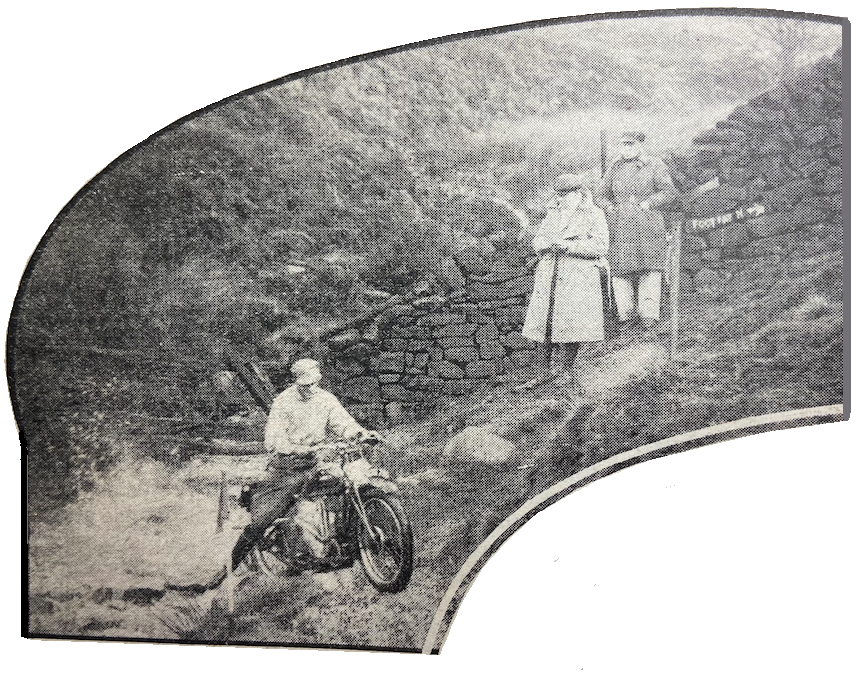
brilliant and frosty, and one or two people found thin films of ice out the main roads a little unsettling in the early morning when travelling to the start at Hopper Lane, near Blubberhouses. Indeed, one of these ice patches accounted for a non-starter, for GR Sothern (596cc Douglas) came to grief on a lonely moorland road. The first passer-by happened to he a doctor. The doctor had his repair outfit with him, and when Sothern awoke it was to find that his head had been properly stitched and bandaged; thereafter he went to spectate at Kex Beck. Among the 73 entries the only other non-starters were four riders from Edinburgh, who failed to appear, so that 68 competitors set out to beat the forces of Nature and the obstacles of man. A mile or so of main road warmed up the motors and then it was ‘good-bye’ to smooth surfaces—unless they happened to be wet grass. A sharp turn off the road through Kex Ghyll and front wheels were at once in the boggy mire leading to the steep track through the bracken on to the heights of Cat Crags. The mud and water are not usually too deep to negotiate, but they form a surface too unstable to permit of the slightest mistake, while the hill has enough rock outcrop to be capable of unseating anyone who treats it lightly. Two thirds of the entry lost marks on this first ascent of Cat Crags before they started the three circuits proper. Another short stretch of genuine road led to Kex Beck, after which the whole circuit became truly rural. Kex Beck is only a tiny stream, but it lies in a hollow with steep and slimy banks; and it was now taken in the reverse direction to usual. And what was formerly an uncomfortable descent over Round Hill Moor was an appalling ascent towards an ever-receding horizon. Only five people got away with it—W Longbottom (596cc Scott), Ken Norris (248cc Red Panther), GE Rowley (498cc Matchless), L Heath (Ariel) and D Lamb (Ariel). GP Whyman (596cc Douglas) got nearly up, turned round, careered down into a moorland ‘beck’, and bent his front forks into curious shapes. Strong men stood upon and pulled at the girders in order that the model could be wheeled. Loftshaw Ghyll splash was not too bad, but AH Walker (249cc Triumph) started to experience clutch slip hereabouts that persisted throughout the day—not to mention the incidental discomforts of a broken fork spring and saddle spring anchorages that came adrift. Many spectators who had reached the somewhat hidden-away Fairy Dell—’at the bottom of the garden’—waited patiently for a trial that never came. For the Dell was cut out owing to the depth water in the splash. Dearncombe Head was only a few fields away, but quite invisible and much less accessible, and only a few onlookers found their way to it. But it was undoubtedly the real test of riding in the ‘race’. Not a single competitor managed to descend to the tiny stream without footing. The splash was nothing. But the ascent therefrom is terrific and there is one hairpin that does not call for ample steering lock—it wants a frame hinged in the middle! With everybody failing or footing it was difficult to single out those who deserved special mention. But certainly Oliver Langton (249cc Triumph) was one, if only for his great restart after being held up by a bunch of failures. CH Wood (172cc SOS) also kept going nicely, while 0M Dixon (497cc Ariel) failed to take the hairpin, sailed on into the moor, turned round, and got in a rush that nearly brought him to the top. Jack White (248cc Ariel) just managed to keep the wheels turning; Bob MacGregor (499cc Rudge) and Graham Goodman (497cc Ariel) both used their feet, and then, at the summit, hared off in the wrong direction; Vic Brittain (490cc Norton) grounded his crank case and had to be pulled on to better ground; and RG Wilkinson (348cc Calthorpe) all but rolled back into the ravine, but ‘held it’ until help reached him. H Blake (348cc BSA) appeared to be the only competitor to make a clean ascent, but it was difficult to judge amid such a welter of plunging models and pounding feet. Tyrell Smith (499cc Rudge) got his gear control all mixed up and had to spend a great deal of time sorting it out. Meanwhile, Ken Wilson (348cc Panther)—last year’s winner—L Heath (497cc Ariel) and A Jefferies (493cc Triumph) were riding steadily over Denton Moor, and their progress was being watched, for
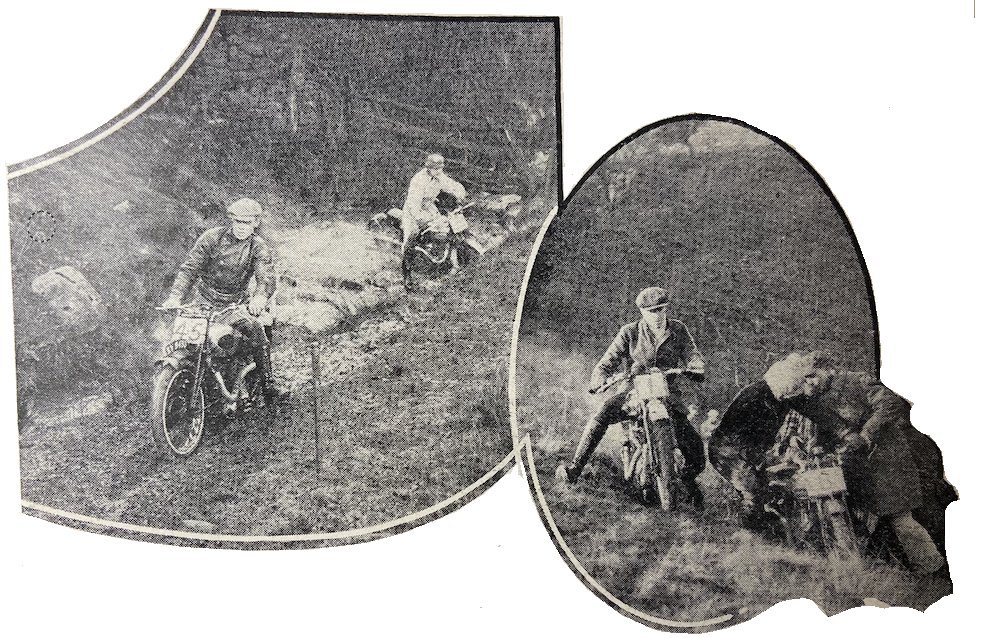
it seemed that they were the riders to watch. Wilson held his lead from Heath, and Jefferies was closing up on the second lap. Then the Panther suffered a sad bout of plug trouble and went out. CF Brett (277cc Triumph) retired at Kex Beck, and on Round Hill Moor H Blake (348cc BSA), positively blinded by the sun just above a crest, dropped into a deep gully and was winded for a few minutes. JS Hyslop (249cc Triumph), at the same spot, shouted ‘Hey up!’, took his own line, which happened to be where the crowd stood, and got away with it. Of course, the crowd ‘Hey upped!’. Ken Norris (248cc Red Panther), it was said, had disappeared with gear box trouble, and JH Kitto (349cc Rudge) was ‘enjoying very poor health’ in the magneto department, but carrying on. WA West (497cc Ariel) had swept off his near-side footrest, and was getting expert at ‘standing on the chain case’ on observed sections. For two hours after Allan Jefferies finished Timekeeper Lumby sat upon a bentwood chair on the windy summit of Cat Crags awaiting the stragglers. Then he. packed up his watches—and shortly afterwards CH Wood (172cc SOS) arrived, having done his three laps. Officially he was not among the 41 finishers, but later the stewards decided to give. him the ‘under-200cc’ pot. Provisional Results: Alfred Scott Memorial Trophy (best performance of the day), L Heath (497cc Ariel), marks lost, 39. Raymond Bailey Trophy (second best performance), VN Brittain (490cc Norton), 43. Norman Dixon Prize (third best performance), J Williams (348cc Norton), 58. President’s Rose Bowl (best performance against standard time, A Jefferies (493cc Triumph), 0. Yorks Evening Post Rose Bowl No 2 (second best performance against standard time), TE Flintoff (493cc Sunbeam), 5. Yorks Evening Post Rose Bowl No 1 (best performance on observation only), 0E Rowley (498cc Matchless), 38. Raspin Bowl (second best performance on observation only), R Wilkinson (493cc Sunbeam), 44. Galloway Cup (best under 200cc), CH Wood (172cc SOS). Junior Tankard (best over 200cc and under 300cc), WT Titian Jnr (249cc Velocette), 64. Special Prize (best performance by rider competing in Scott Trial for first time), WJ Smith (346cc OK Supreme), 82. Folbigg Cup (best performance on Scott machine), W Longbottom (596cc Scott), 109. Scott Trophy (best one-make team), Sunbeam: R Wilkinson, C Helm and TE Flintoff, 184. Myers Cup (best team, any make), ‘Sonnenblick’: L Heath (497cc Ariel), J Williams (348cc Norton) and A Jefferies (493cc Triumph), 151.
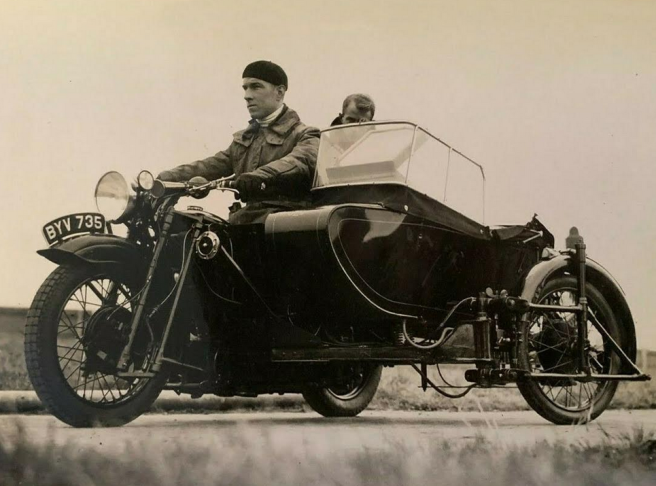
“THE SECOND OF THE SERIES of mass meetings of motor cyclists organised by the British Motor Cycle Association was held at the Woodcock Street Baths, Birmingham, last week. In spite of very wet weather there was a good attendance—the estimates varied between 450 and 600—when Alderman WF Lovsey, JP, the chairman, opened the meeting. Mr. Lovsey is the chairman of the Birmingham Watch Committee…He said he realised that the motor cycle was not a dangerous machine if properly handled, but there was, he thought, a section of riders who failed to exercise the care that was necessary on the roads to-day…there were 16,000 motor cycle owners in the city, and during the past year, out of a total of 12,053 motor-ing prosecutions, 3,015 of those involved had been motor cyclists. The next speaker was Capt W Strickland, MP, who stated that too great an emphasis was laid on fatal accidents and not enough on the contributory causes. He went on to say that in this respect motorists and motor cyclists did not always get a fair deal from the police and magistrates. He welcomed the BMCA, and promised his full support, on behalf of motor cyclists, in the House of Commons, but pointed out that much more notice would be taken by the Government if, when making a protest, MP.s were able to show that they had the full weight of motor cyclists’ opinions behind them. He therefore urged all to join the BMCA. Mr JW Bryan, a director of BSA Cycles, said that proper support for the Association would open out a new era for an historic movement. He considered that licences should be granted to people of a lower age than at present was the case. Lord Sandhurst, 0BE, chairman of the BMCA, suggested that a gentle warning from the police in such cases as speedometer-less machines being driven at slightly over the 30mph limit would do a great deal more good than prosecutions. Maintaining that motor cyclists should have a representative organisation of their own, Mr TF Watson, of the Birmingham MCC, also thought the Government might, with advantage, reconsider the present rates of taxation. Then it was Graham Walker’s turn, and he appealed for—almost demanded—less apathy on the pact of motor cyclists. He asked for short period licences, better rear lighting on lorries, and better road surfaces. He called on the Government to ensure that riders who passed the driving test should be able to secure insurance at reasonable rates. Mr Ernest Humphries wound up the speeches wilt a plea for uniformity in road construction and police methods. “
…and that’s all the yarns I could track down for 1935, at least for the time being. Have a decko at some of the ads that tempted motor cyclists to put their hands into their pockets; see you in 1936.
